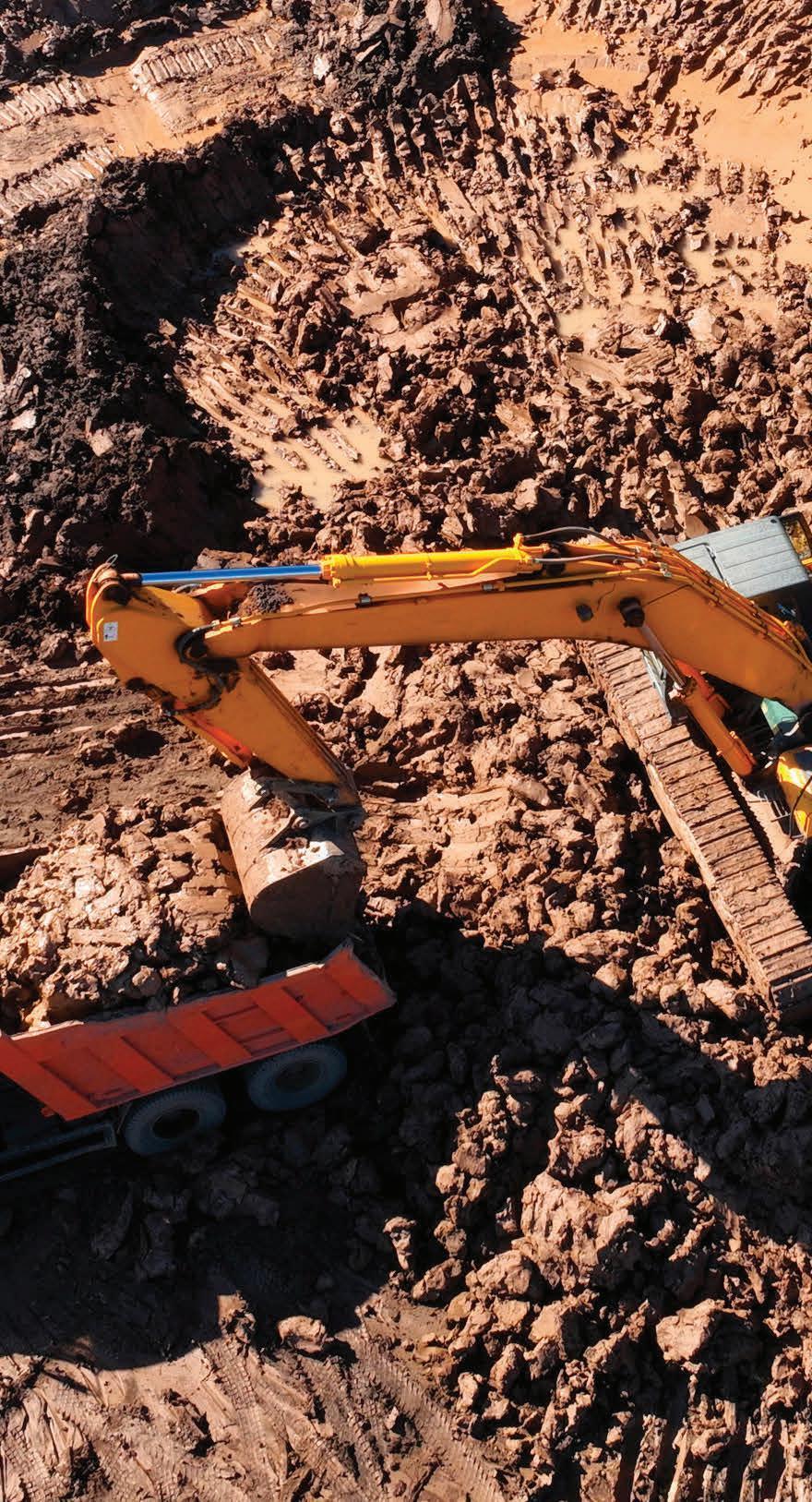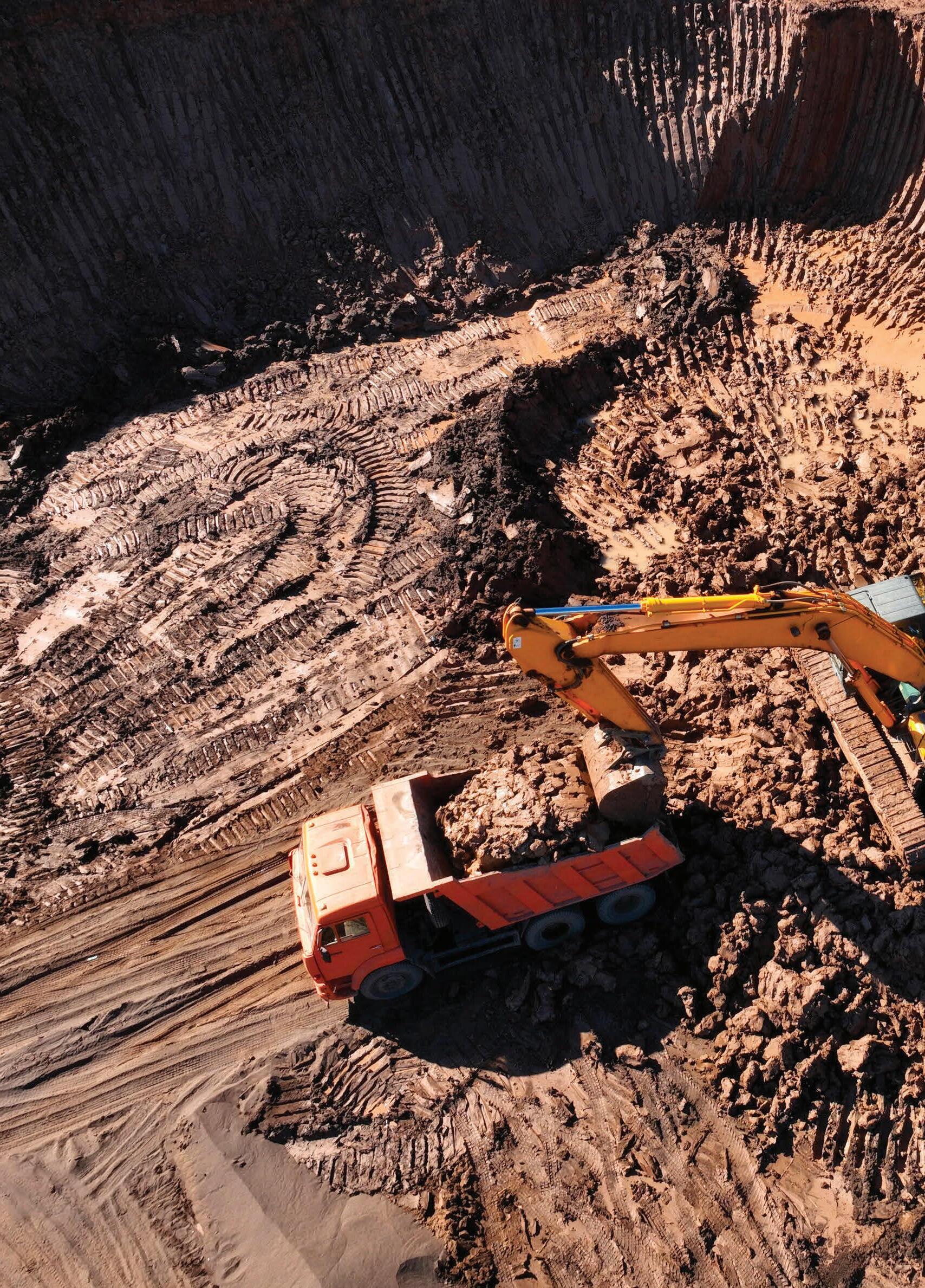
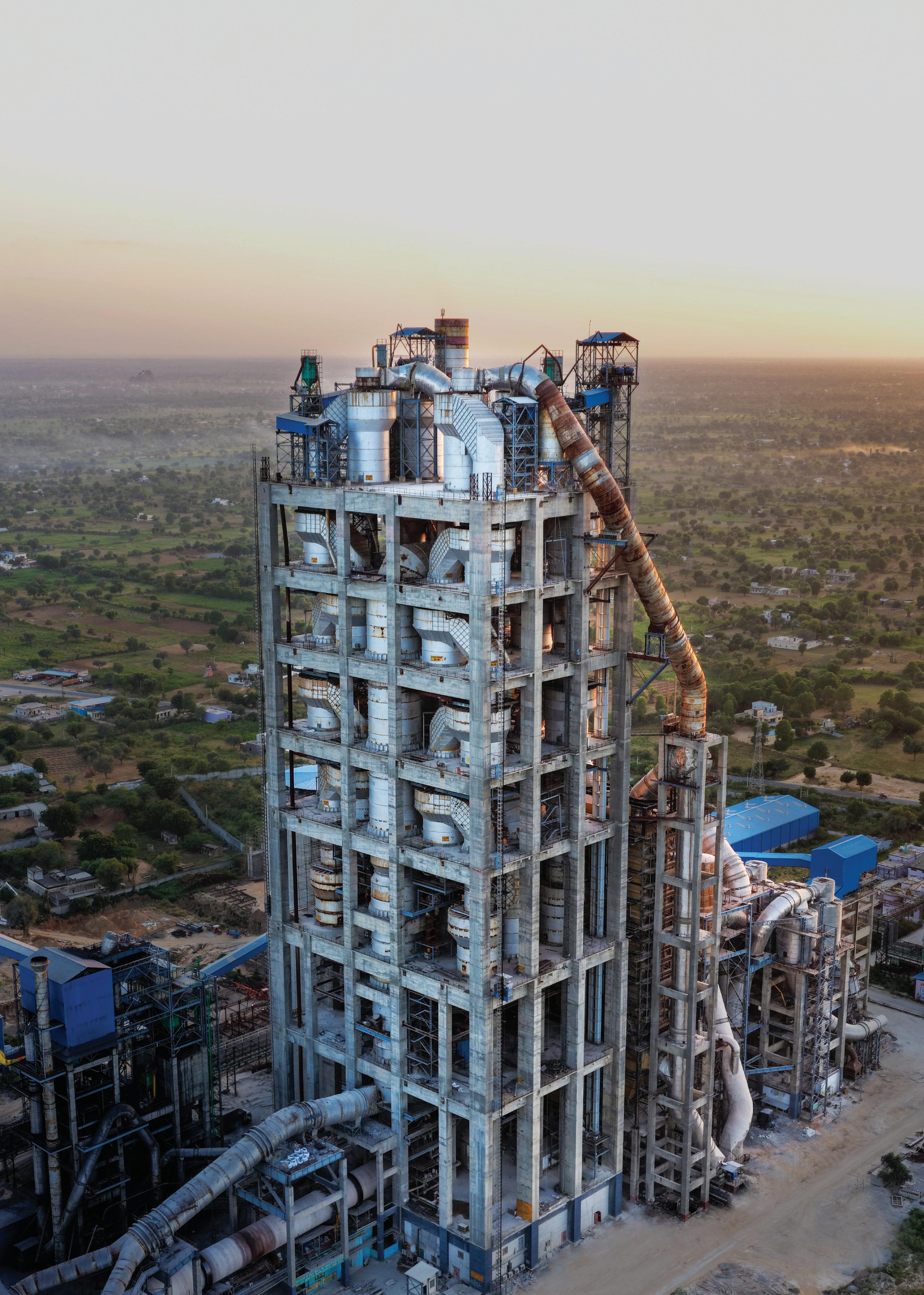



At Shree's Nawalgarh plant, the pyro line isn’t just breaking world records for production — it’s setting new standards for energy efficiency, alternative fuels and digital intelligence. Fuller® Technologies is building a cleaner, smarter future together with Shree Cement. Formerly FLSmidth Cement November 2025




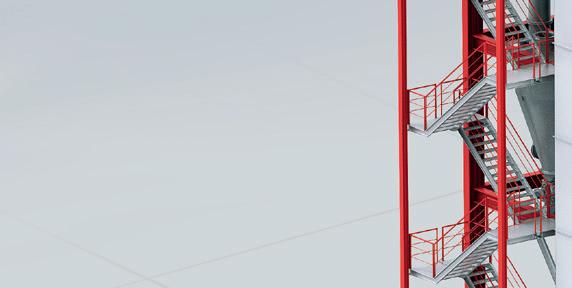
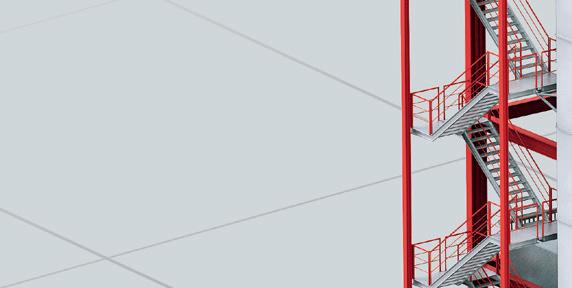





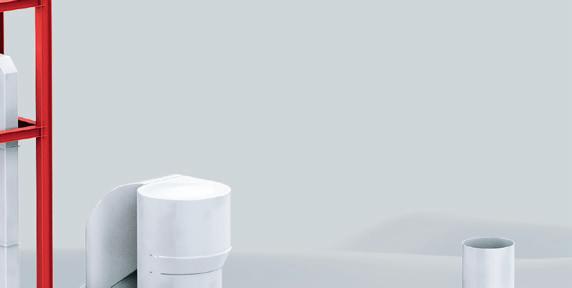


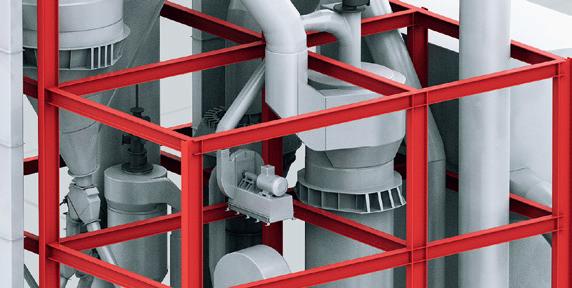




Rotary calciner for upgrades

Based on the familiar principals of clinker production, rotary clay calciners are ideal for mothballed clinker production lines.





Cement producers around the world are pursuing clay calcination as part of e orts to cut the carbon intensity of cement.
But how best to implement these projects?
That depends on a range of site-specific factors.



Our clay calcination solutions have been developed from proven components and processes to deliver a high-quality Portland cement substitute. And they come backed by our advanced process and plant engineering skills to ensure they deliver the best possible results for your application.


We can also combine them with our leading alternative fuel solutions to further reduce carbon emissions. So, when you’re looking for your clay calcination partner, think KHD.
And let’s deliver Cement beyond Carbon together. www.khd.com/clay-calcination


Flash calciner for new projects
Ideal for greenfield projects, our flash calciner delivers cost-e ective clay calcination, including for very sticky clays and clays with up to 40% moisture.

Benefit from extra AF potential
Alternative fuel solutions like the Pyrorotor® o er signifcant extra benefits with regards to emission reduction.


Our clay calcination solutions produce material that is the same color as ordinary cement –thanks to advanced process control. No additional processes required.
03 Comment
05 News
REGIONAL REPORT: MENA
10 Mixed Fortunes in MENA
FANS & BLOWERS
48 Contingency Planning for Process Blowers
Matt Piedmonte, Aerzen Rental Solutions, discusses how contingency planning can safeguard critical process blower operations in cement and gypsum plants.
SAMPLING & ANALYSIS

Alfie Lloyd-Perks, WorldCement, explores how sharply different economic realities are defining the cement sectors in Saudi Arabia, Egypt, and Iran.
COVER STORY
16 Nawalgarh’s Record-Breaking Rise
Manoj Taneja, Fuller Technologies, explores how the Nawalgarh Plant is raising the bar for modern cement production with record-breaking technology, rapid execution, and a strong focus on sustainability.
DECARBONISATION
24 From Vision To Action
Cliona Cunningham, Cement Europe, outlines how a strategic rebrand and new action plan are helping the cement sector drive Europe’s industrial transition toward climate neutrality and competitiveness.
30 Supply Shocks And Substitutes
Dr S B Hegde, Jain College of Engineering and Technology and Pennsylvania State University, explores the shifting dynamics surrounding raw materials for cement production and the strategies needed to ensure supply chain resilience and support carbon reduction.
CEMENT ADDITIVES
35 Targeted Additive Technology
Alejandro Velez and Emmanuel Gallucci, Sika AG, explore the role of SCM-specific additives in enabling cement producers to improve efficiency whilst meeting decarbonisation goals.
GEARS, DRIVES & MOTORS
40 The Smart Way Forward
Jon Siverling, Regal Rexnord, reveals why gearbox recertification is the smarter way forward.
45 Efficiency Fuels the Future Innomotics explores how advanced motor and drive technologies can help cement producers boost efficiency and cut carbon emissions.
57 Waste Works Wonders
Jeremy Williams, Thermo Fisher Scientific, explains how advanced analytical techniques support the safe and sustainable use of alternative fuels.
WASTE HEAT RECOVERY
61 Wringing More From Waste Heat
Joakim Jaeger, Climeon AB, explores how low-temperature organic Rankine cycle technology is unlocking new value from waste heat to enhance energy efficiency and decarbonisation.
67 Closed-loop Cooler Breakthrough
Sinoma EC explains how applying a cooler exhaust gas closed loop system can significantly improve waste heat power generation efficiency in cement kilns while reducing emissions and enhancing clinker line performance.
MATERIALS HANDLING & STORAGE
71 Pneumatic Power Play
Wen Peng & Chen Xiangyou, Henan SRON Silo Engineering Co., Ltd., present the advantages of silo pump pneumatic systems for cleaner, smarter, and more reliable powder material handling.
75 Perfecting Packing Performance
Frank Ormeloh, HAVER & BOECKER, explores how packing equipment advancements are boosting efficiency and sustainability.
81 Smarter Shutdown Strategies
R. Todd Swinderman and Daniel Marshall, Martin Engineering, explore best practices for managing safe and efficient plant shutdowns.

At Shree’s Nawalgarh plant, the pyro line isn’t just breaking world records for production – it’s setting new standards for energy efficiency, alternative fuels and digital intelligence.
Fuller® Technologies is building a cleaner, smarter future together with Shree Cement.

















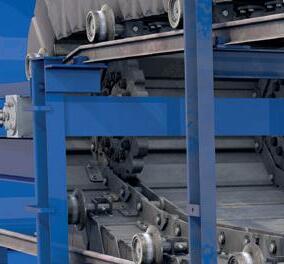


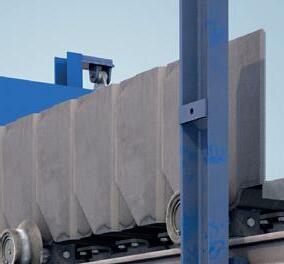























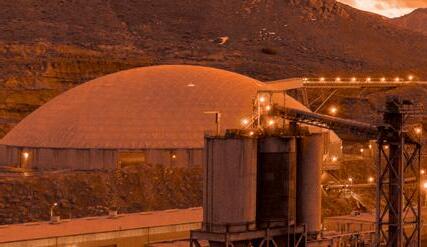



















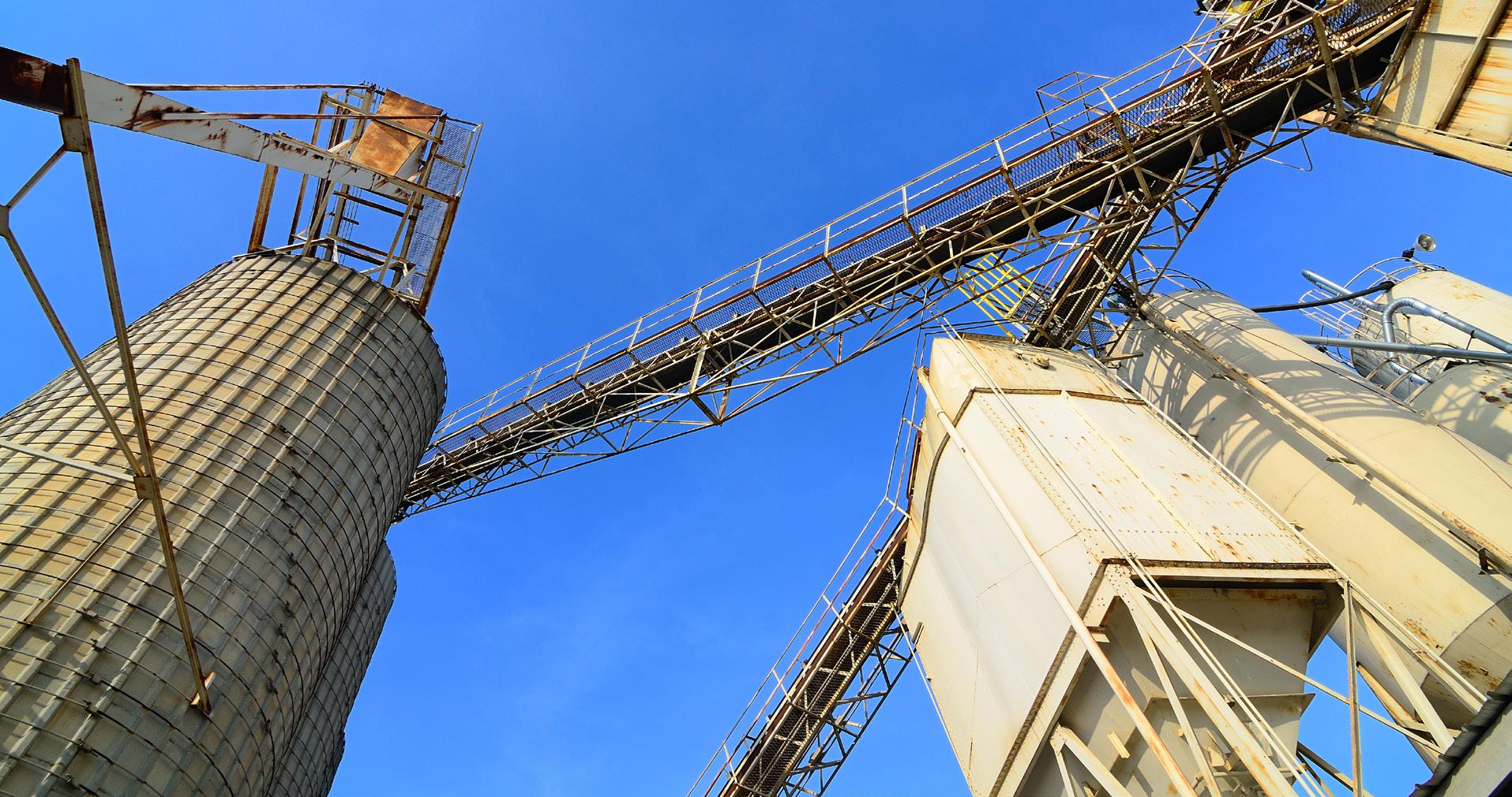
Sales Manager: Ian Lewis ian.lewis@palladianpublications.com
Sales Executive: Sophie Birss sophie.birss@palladianpublications.com
Head of Events: Louise Cameron louise.cameron@palladianpublications.com
Event Coordinator: Chloe Lelliott chloe.lelliott@palladianpublications.com
Digital Events Coordinator: Merili Jurivete merili.jurivete@palladianpublications.com
Digital Content Coordinator: Kristian Ilasko kristian.ilasko@palladianpublications.com
Junior Video Assistant: Amélie Meury-Cashman amelie.meury-cashman@palladianpublications.com
Digital Administrator: Nicole Harman-Smith nicole.harman-smith@palladianpublications.com
Administration Manager: Laura White laura.white@palladianpublications.com
Reprints reprints@worldcement.com

DAVID BIZLEY, SENIOR EDITOR
The UK has been something of a leader when it comes to decarbonisation efforts over recent decades. However, an uncomfortable statistic has recently come to light through new research published in TheTelegraph: up to 15% of the reduction in the UK’s greenhouse gas emissions over the past decade has been due to industrial decline. Whilst the world continues to rapidly approach, and break, climate red lines with seemingly casual abandon (RIP ‘keep 1.5 alive’), and any decarbonisation gains are to be appreciated, achieving them inadvertently, rather than through the UK’s globally impressive decarbonisation projects, clearly isn’t the right approach.
This most recent news also comes in the wake of the announcement from the Mineral Products Association that UK cement production had fallen to its lowest level since 1950 – a year when the country was still recovering from the Second World War, George VI was still on the throne, and rationing was still in place.
CBP019982
Annual subscription (published monthly): £160 UK including postage/£175 (€245) overseas (postage airmail)/US$280 USA/Canada (postage airmail). Two year subscription (published monthly): £256 UK including postage/£280 (€392) overseas (postage airmail)/US$448 USA/Canada (postage airmail). Claims for non receipt of issues must be made within 4 months of publication of the issue or they will not be honoured without charge.
Applicable only to USA and Canada: WORLD CEMENT (ISSN No: 0263-6050, USPS No: 020-996) is published monthly by Palladian Publications, GBR and is distributed in the USA by Asendia USA, 17B S Middlesex Ave, Monroe NJ 08831.
Periodicals postage paid at Philadelphia, PA and additional mailing offices. POSTMASTER: send address changes to World Cement, 701C Ashland Ave, Folcroft PA 19032
Copyright © Palladian Publications Ltd 2025. All rights reserved. No part of this publication may be reproduced, stored in a retrieval system, or transmitted in any form or by any means, electronic, mechanical, photocopying, recording or otherwise, without the prior permission of the copyright owner. All views expressed in this journal are those of the respective contributors and are not necessarily the opinions of the publisher, neither do the publishers endorse any of the claims made in the articles or the advertisements. Uncaptioned images courtesy of Adobe Stock. Printed in the UK.
Palladian Publications Ltd
15 South Street, Farnham, Surrey GU9 7QU, UK
Tel +44 (0)1252 718999
Email: mail@worldcement.com
Website: www.worldcement.com
Nobody who wants to see economic growth (the UK government, for example) wants to see industries close – particularly industries that supply essential products like cement. To quote Dr Diana Casey, Executive Director for cement and lime at the Mineral Products Association: “Cement quite literally underpins the nation’s growth and we can’t deliver new homes, schools, hospitals, transport links, or clean energy infrastructure without it. The UK has a choice: to build these vital development projects with UK-made cement, or to build them with imports – sending jobs, investment, and economic growth overseas.”
And if carbon-intensive products, like cement, are no longer being produced in the UK where there is relatively stringent emissions regulation, then where are they coming from? The MPA points out that cement imports to the UK have nearly tripled from 12% of sales in 2008 to 32% in 2024. UK cement manufacturers have found themselves caught between some of the world’s highest energy costs and uneven carbon taxation that means importers (especially those from outside of the EU) pay much less for their emissions.
Not only is that bad for UK cement producers from a commercial perspective, it also risks the offshoring of emissions, undermining domestic decarbonisation efforts, and setting back attempts to combat climate change.
All of this goes to demonstrate how decarbonisation is a multifaceted challenge, one where policy is just as important as technology; where CBAM is just as much a part of the solution as CCUS. The good news is that, despite these hurdles, the UK is poised to continue its role as a leader in decarbonisation as the government throws its weight behind major projects like HyNet (including Heidelberg Materials’ Padeswood CCS, the follow-up to Brevik CCS) and the Peak Cluster, which will ultimately decarbonise more than 40% of the UK’s entire cement output.
If you’d like to hear more about both the technologies and the policies driving the cement industry’s net zero transition, then join us at EnviroTech 2026, taking place in London on 15 – 18 March. Early-bird registration is now open: www.worldcement.com/envirotech


It was a momentous occasion at the Rohrdorf cement plant. Numerous guests and representatives from regional and state politics attended the inauguration ceremony for the new pilot plant for tempered clays.
Daniela Ludwig, Parliamentary State Secretary at the Federal Ministry of the Interior, cut the symbolic ribbon together with Rohrdorfer Managing Director Mike Edelmann, thereby inaugurating the plant. The Rohrdorfer pilot plant was built as part of a pilot project funded by the Federal Ministry for Economic Affairs and Climate Protection and the EU and will receive up to €8.65 million in funding due to its innovation potential.
Tempered clays are one of the most important levers on the path to low-carbon cement production. Around 30 percent of emissions can be avoided by replacing clinker with tempered clays. The plant successfully went into operation in July and has since been activating (‘tempering’) up to 50 tpd of raw clay through thermal treatment. The aim of the plant is to research tempered clays, as these can be used as a lower-CO2 alternative to clinker – the main component of cement. The new plant is therefore a key component in Rohrdorf’s decarbonisation roadmap.
In her speech, Daniela Ludwig praised Rohrdorfer’s initiative: “With this new plant, the Rohrdorf cement factory has once again proven that it is one of the most innovative companies in our region. Decarbonising the cement industry is an important task if Germany is to achieve its climate targets as planned. I am impressed by the determination and entrepreneurial courage with which Rohrdorfer is approaching this task.”
District Administrator Otto Lederer and Member of the State Parliament Daniel Artmann took part in the ceremony. They, too, are impressed by Rohrdorfer’s innovative strength: “A look at Rohrdorf shows that Bavarian industry is as innovative as ever and has long had climate protection on its agenda,” said Otto Lederer. Daniel Artmann had words of praise: “It is initiatives like this that secure jobs and thus prosperity in our region. I congratulate Rohrdorfer on this milestone.”
By the end of 2026, the net zero emission team will investigate the ideal composition of raw clays and optimise the processes for thermal treatment.
Based on these trials, a large-scale plant is to be built in the future that will enable significant CO2 savings. The potential savings amount to a total of 60%. Thanks to tempered clays, almost half of this can be avoided. “We have achieved a lot within our plants, but our influence ends at the factory gates,” points out Mike Edelmann, Managing Director of the Rohrdorfer Group. “The lack of planning security in the transport and storage of carbon dioxide, uncompetitive electricity prices, and an uncertain funding landscape are a stumbling block for us. We urgently need more support and backing from politicians, otherwise the climate targets cannot be achieved.”
Cemex has announced that it has closed the sale of its operations in Panama to Grupo Estrella for an enterprise value of approximately US$200 million, representing a multiple of approximately 12x adjusted EBITDA for the 12 months ended August 31, 2025.
Cemex also announced that it has increased its holdings to a majority stake in Couch Aggregates, a leading player in the aggregate materials industry across the southeastern US, expanding on a joint venture originally announced in July 2024. Cemex believes that, in the short term, this investment will offset the loss of EBITDA from the sale of its operations in Panama. A small part of the proceeds from the divestiture of Panama are being allocated to this transaction.
“These transactions are important building blocks in our strategy to rebalance our portfolio and continue investing in growth in priority markets, particularly aggregates in the US,” said Jaime Muguiro, CEO of Cemex.
Grupo ESTRELLA, a Dominican privately owned industrial conglomerate, is acquiring the divested assets in Panama, that mainly consist of one cement plant in Calzada Larga, Chilibre, which, as of December 31, 2024, had an installed cement capacity of around 1.2 million tpy. The divested assets also include related cement, ready-mix concrete, aggregates assets, and rights to acquire additional reserves for Panama’s operations. Cemex will retain its admixtures business in Panama.
AUCBM AICCE 28

11 – 13 November, 2025 Dubai, UAE www.aucbm.net
TÜRKÇİMENTO International Technical Seminar & Exhibition 19 – 23 November, 2025 Antalya, Turkey teknikseminer.com.tr
15 – 18 March, 2026 London, UK worldcement.com/envirotech
SOLIDS Dortmund
18 – 19 March, 2026 Dortmund, Germany www.solids-recycling-technik.de
IEEE-IAS/PCA Cement Conference
26 – 29 April, 2026 Fort Lauderdale, USA cementconference.org
Couch serves diverse markets with sand, gravel, and crushed stone, operating seven sand & gravel pits and five marine terminals.
Cemex’s portfolio rebalancing strategy is part of its broader commitment to providing the highest possible returns to its shareholders by being the best partner to its customers, having a laser-like focus on operational efficiency, and following a disciplined capital allocation strategy.
Etex and Heidelberg Materials Benelux unveil breakthrough low carbon cement technology
For the first time, the combined expertise of two industry leaders enables a fully circular process that transforms fibre cement waste into high-quality secondary raw material, which is then used to produce circular, low-carbon cement that will be reused to produce new fibre cement products. Taking part in this common project marks a major step forward in the transition to a more sustainable built environment.
This is achieved through two innovative processes: one developed by Etex, in collaboration with the Jacobs Group, and the CCLIX process led by Heidelberg Materials.
Etex, in collaboration with the Jacobs Group, will implement a new process that transforms fibre cement waste from Etex’s fibre cement production lines and the broader construction sector into Recycled Fibre Cement Paste (RFCP). This avoids landfilling and downcycling, reintegrating valuable material into the construction value chain. A new recycling facility in Hemiksem, Belgium (Antwerp), is currently under construction, with completion expected by mid-2026.
At its Lixhe cement plant in Belgium (Liège), Heidelberg Materials is developing CCLIX, an innovative process that upgrades recycled fibre cement paste (RFCP) through enforced carbonation. By treating RFCP with CO2 captured from kiln exhaust gases, the material is transformed into carbonated RFCP (cRFCP), regaining cementitious properties and becoming a high-quality secondary raw material that can partially replace clinker in low-carbon cement production. To scale up this breakthrough, a dedicated carbonation reactor will be commissioned at Lixhe by the end of 2028.
The CEMLOOP XL project delivers measurable environmental benefits:
f Prevents 60 000 tpy of fibre cement waste.
f Saves 100 000 t of raw limestone per year.
f Reduces CO2 emissions in cement production by at least 20%.
f Cuts energy use in cement manufacturing by 15%.
f Enables new fibre cement products with more than 20% recycled content and a 15% lower carbon footprint.
f Captures or avoids about 900 kg of CO2 for each t of RFCP.
In the CCUS world, this is a unique combination of utilisation and storage in one integrated step: the captured CO2 is part of the new product yet chemically bound in such a way that it will not be able to return to the atmosphere during or even after its lifetime. Therefore, also according to EU regulation, it acts as a permanent CO2 sink.


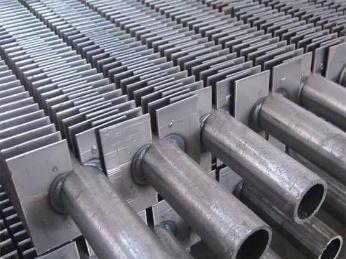



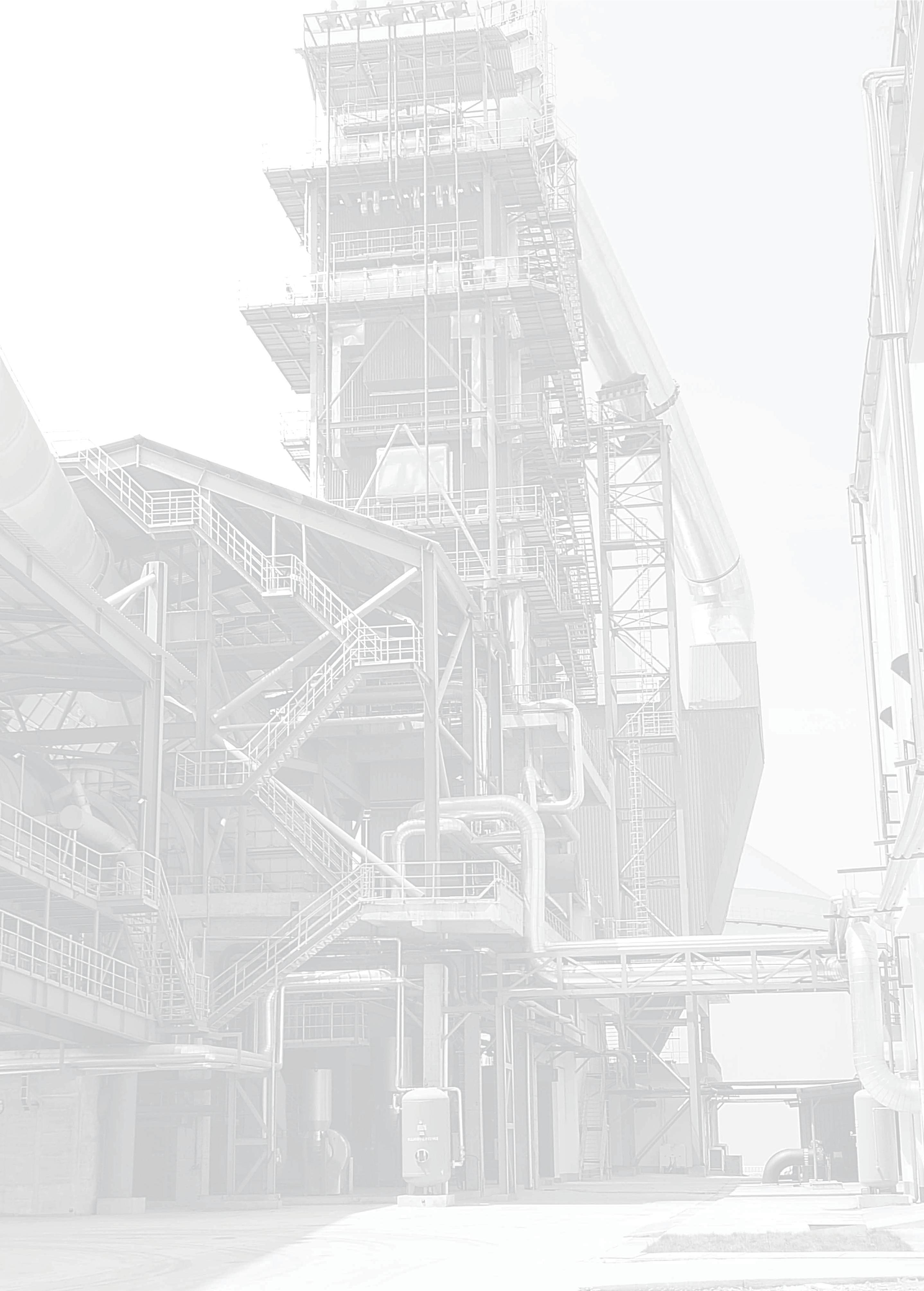
Serge Montagne, Technical Director Cement Operations, Heidelberg Materials Benelux: “Pioneer on the path to carbon neutrality, Heidelberg Materials has long been committed to reducing its CO2 emissions. One of its key levers is lowering the clinker content in its cement. To accelerate the shift toward more sustainable and environmentally friendly solutions, the company is actively working to diversify its sources of secondary cementitious materials. CEMLOOP XL is a significant step forward toward new generations of cements, making the construction materials more sustainable and responsible.”
CEMBUREAU rebrands to Cement Europe, launches Cement Action Plan
The European Cement Association has unveiled its new identity – Cement Europe – marking a new chapter for a sector that is the backbone of Europe’s construction value chain; vital for housing, infrastructure, energy systems, defence, and the digital economy. A cornerstone of Europe’s economy, it is also a driver for change in its industrial and clean transition.
This strategic rebrand reflects a clear evolution: building on a solid legacy to position Cement Europe as a partner driving Europe’s competitiveness and climate neutrality.
With more than 200 plants across Europe and over 120 innovation projects already under way, Cement Europe embodies an industry that is fully local, essential to Europe’s autonomy, and a frontrunner in decarbonisation. The new identity connects this legacy with the future; bold, purposeful, and aligned with Europe’s wider clean and digital transitions.
“Cement has always been the foundation on which Europe builds,” said Jon Morrish, President of Cement Europe. “Our new identity honours that reliability, while reflecting who we are today: a sector powering change through innovation, circularity and partnership. Cement Europe stands for strength with purpose, helping Europe build its competitive, sustainable future.”
It is no coincidence that the rebrand coincides with the launch of the Cement Action Plan, a strategic blueprint outlining the policies needed to unlock investment in industrial decarbonisation while maintaining Europe’s competitiveness. The plan
highlights how cement – indispensable to housing, infrastructure, renewable energy systems and digital facilities – can continue to support Europe’s growth while cutting emissions in line with the sector’s net zero roadmap.

“Europe’s industrial transition must go hand in hand with competitiveness,” said Koen Coppenholle, CEO of Cement Europe. “Our members are investing, innovating, and deploying low-carbon solutions at scale, but to reach our ambitions, we need the right enabling framework. Cement Europe symbolises that partnership: between industry, policymakers and society.”
Building on the sector’s net zero roadmap, the Cement Action Plan sets out the enabling conditions required for the European cement industry to remain competitive while delivering on its climate ambitions. The Plan responds to the growing dual challenge faced by industry: ensuring a level playing field and restoring the business case for decarbonisation investments.
“The Cement Action Plan sends a clear message. Competitiveness is paramount if we are to succeed in the clean transition,” said Jon Morrish, President of Cement Europe. “Our industry is ready to deliver low-carbon, circular materials, but we need the right regulatory, funding and infrastructure conditions to make it happen.”
Europe’s cement sector is already leading the race to decarbonisation, having launched more than 120 innovation projects across the continent. Yet without a competitive business model, these efforts are at risk. The Plan identifies clear actions to strengthen competitiveness:
f A watertight CBAM by 2026, ensuring fair treatment for imports and exports.
f Business planning security under the EU ETS, with regulatory consistency and long-term predictability.
f Competitive access to energy, through electricity market reforms, tariff reductions, and strengthened interconnections.
“We have the ambition, the technology and the projects. But without the right enabling framework, the transition will stall,” added Koen Coppenholle, CEO of Cement Europe. “The Cement Action Plan is a call for a strong policy partnership to deliver Europe’s industrial decarbonisation while keeping production, jobs and investment in Europe.”
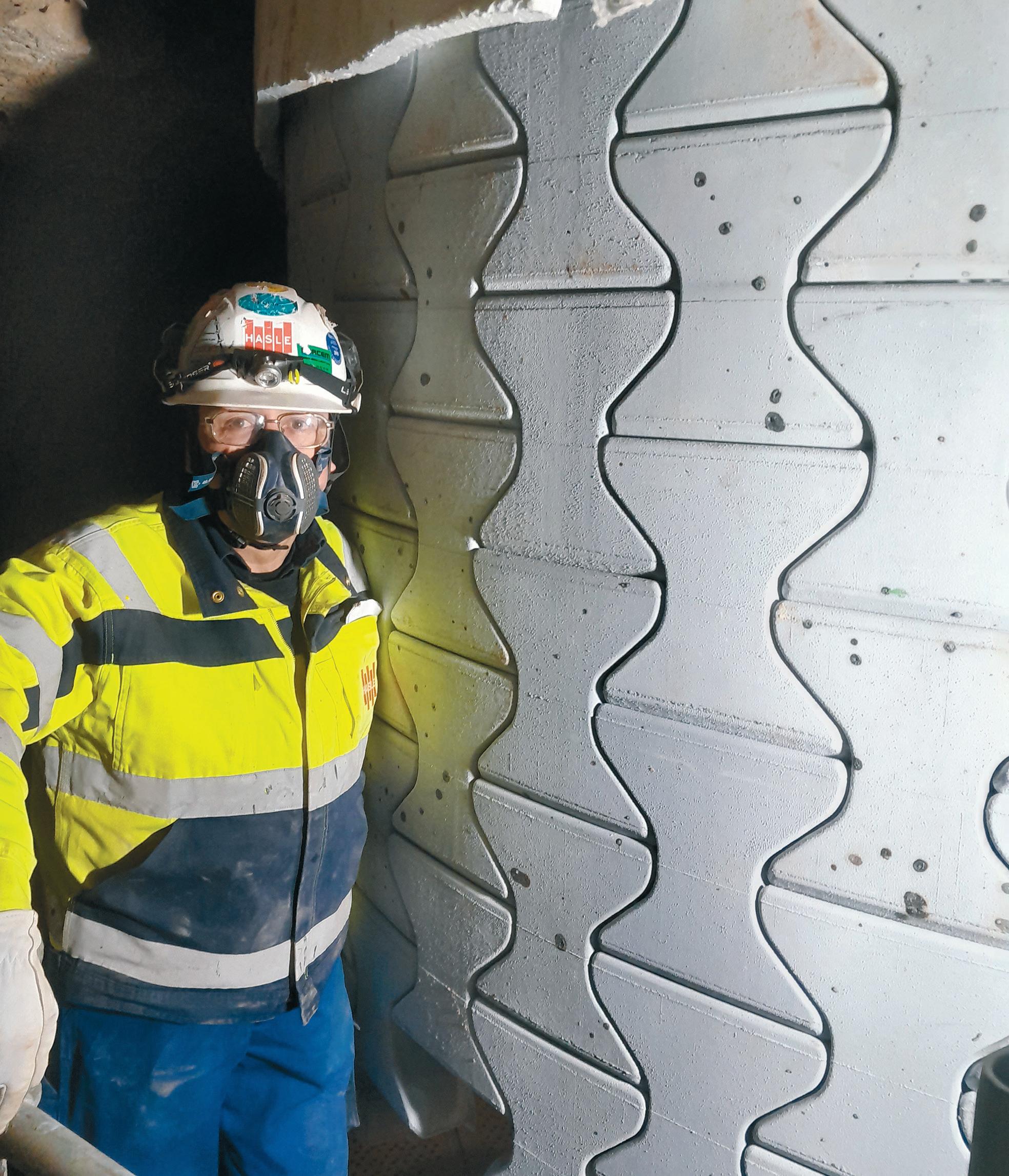

Germany - cement plant, lowest stage cyclone
Operating temperature: 950 °C.
Lifetime achieved: 1 year.
(Steel dip tube previously used achieved a 2-3 months lifetime).

Japan - cement plant, lowest stage cyclone
Operating temperature: 950 °C.
Achieved 1 year of operation and still running. 2 years lifetime expected. (Previously operating without dip tube).
The HASLE Ceramic Vortex Finder (CVF) is engineered to endure the harsh conditions of cyclones operating at elevated temperatures and utilizing alternative fuels, providing a durable alternative to traditional steel dip tubes.
The CVF is assembled on-site by individual ceramic elements, which interlock to form a stable tube hanging from a steel ring welded to the roof casing of the cyclone.
• Withstand temperatures up to 1200 °C / 2200 °F
• Enables sustainable fuel conversion through excellent resistance to chemical attacks
• High dimensional stability prevents deformation, ensuring high separation efficiency
• High abrasion resistance
• Smooth surface - Minimal build-up and coating
• 15–16 kg per element allows for easy handling during installation and use of existing manholes
• Variable diameter options: 1.5 to 7.5 metres

USA - cement plant, lowest stage cyclone
Operating temperature: 900 °C
Achieved 1,5 year of operation and still running.

Australia - cement plant, lowest stage cyclone
Operating temperature: 850-900 °C.
Lifetime achieved: 2 years and 9 months (Previously running without dip tube).

Alfie Lloyd-Perks, World Cement, explores how sharply different economic realities are defining the cement sectors in Saudi Arabia, Egypt, and Iran.
he Middle East & North Africa (MENA) region remains one of the more resilient pockets in the global cement industry. However, this region conceals a more complex and fragmented reality at the national level. While some economies surge ahead with visionary mega-projects, others are constrained by political tensions and economic pressures that suppress demand and squeeze profitability. The region's cement story is therefore one of divergent paths, where soaring ambition in one nation stands in stark contrast with harsh economic realities in another. This article will explore these parallel realities in the MENA region by delving into the cement sectors of Saudi Arabia, Egypt, and Iran – three regional giants whose fortunes are being shaped as much by political will and economic policy as by construction demand itself.
Economic overview
Saudi Arabia's economy is poised for a stronger performance in 2025, navigating a pivotal moment as it balances its vast oil wealth with an ambitious, state-driven diversification agenda. After a slowdown in 2023 – 24, economic growth has accelerated

in 2025, supported by the faster than expected unwinding of OPEC+ output cuts and a strong recovery in the services and non-oil sectors. Real GDP is projected to grow by around 4% in both 2025 and 2026, according to the IMF, while the World Bank expects steady gains across both oil and non-oil sectors.
Saudi Arabia's non-oil economy remains the undisputed growth engine, expanding by nearly 5% in the first half of 2025. This surge is being driven in part by the state's massive commitment to its Vision 2030 agenda, with unprecedented investment flowing into tourism, manufacturing, and technology. The strategy is delivering tangible results, driving unemployment below 3% at the start of 2025 and fuelling a broad-based private sector boom.
The key theme in Saudi Arabia is acceleration: an economy steadily moving beyond oil dependence, maintaining reform momentum while attempting to manage the pressures of rapid transformation.
Cement sector update
Saudi Arabia's cement sector is operating at full throttle, physically building the Kingdom's economic transformation by supplying its historic giga-projects. The industry's pivotal role was evident in its strong
finish to 2024, with quarterly cement sales climbing 12.33%, driven primarily by robust domestic demand, which accounted for more than 96% of total sales. This relentless activity is fuelled directly by massive construction projects under the Vision 2030 initiative, including NEOM and Red Sea Global, which are generating unprecedented demand for construction materials. Major producers are responding with strategic expansions aligned with these national ambitions. Qassim Cement Company, for instance, has signed a landmark US$298 million contract with Sinoma International Engineering to build a new 10 000 tpd production line. As CEO Omar Al-Omar stated, this project is designed to "replace outdated, low-efficiency production lines," directly supporting Vision 2030's objectives for enhanced energy efficiency and environmental sustainability.
With the cement market projected to grow at a CAGR of 6.10% through 2030, Saudi Arabia's cement industry remains strong. All in all, a combination of strategic expansion, technological modernisation, and domestic demand have positioned producers not merely to supply Saudi Arabia's transformation, but to grow substantially alongside it.
Economic overview
Egypt enters 2025 on a fragile but improving footing, emerging from one of its most difficult economic periods in recent memory. Growth slowed to just 2.4% in FY2023/24, but the outlook has brightened following the March 2024 currency devaluation and the IMF’s US$8 billion support package. With inflation easing and monetary policy starting to relax, GDP growth is forecast to rise to 3.8% in FY2024/25 and 4.6% in FY2025/26, marking the beginning of a gradual recovery. This recovery is being driven by a weaker currency that has boosted export competitiveness and tourism, alongside major foreign investments like the landmark US$35 billion Ras El Hekma project that is delivering crucial foreign currency inflows.
Still, vulnerabilities persist. While inflation has retreated significantly from its peak of nearly 40% in August 2023 to around 12%, new challenges have emerged. The fiscal deficit is set to widen to 7.2% of GDP in FY2024/25 according to the World Bank, reflecting higher interest costs and fading one-off revenues. External financing needs remain heavy, compounded by weaker Suez Canal receipts and upcoming debt repayments. The key theme in Egypt is cautious recovery – where ongoing reforms, lower inflation, and renewed investment are helping to steer the economy from crisis toward a slow but steadier path of stability.
Cement sector update
Despite a challenging domestic economic climate, Egypt’s cement sector has demonstrated strategic
resilience, maintaining its position as Africa's largest producer with a capacity exceeding 80 million tpy according to some reports. The industry has adeptly navigated economic headwinds by capitalising on international opportunities. The 2024 currency devaluation, though painful for households, significantly boosted Egypt's external competitiveness. Cement and clinker exports surged to a record 9.7 million tpy in 2024 – a near threefold increase from 2022 – transforming the nation into a major global supplier.
However, this export boom was so potent it prompted government intervention, with authorities requesting plants limit exports to no more than 30% of their capacity to ensure sufficient domestic supply and stabilise local prices. Despite this intervention, investor confidence remains strong. At the inauguration of Mapei’s new facility in 10th of Ramadan City, CEO Veronica Squinzi described Egypt as “a very promising market for the global construction industry,” citing demographic demand and state-backed infrastructure projects. It is clear that foreign firms continue to view the sector as a strategic foothold in North Africa’s industrial resurgence.
Even amid economic turbulence, Egypt's cement industry remains robust. Strategic export growth, continued foreign investment, and careful balancing of domestic needs have allowed producers to not only weather the storm but position themselves for future gains as the broader economy stabilises.
Economic overview
Iran is arguably the wild card in this trio, grappling with one of the most severe economic crises in its modern history.
A combination of stringent international sanctions and profound domestic policy missteps has triggered rampant inflation and a catastrophic collapse of the rial, which has lost over half its value in recent years. Inflation remains persistently high, officially hovering between 40 – 50%, devastating household purchasing power and deepening a severe cost-of-living crisis. This macroeconomic turmoil is compounded by a debilitating internal energy crisis.
Chronic electricity and natural gas shortages have led to widespread blackouts, forcing the government to impose mandatory power cuts on major industries, severely disrupting operational continuity and raising production costs across the board. The IMF projects a meager 0.6% GDP growth for 2025 – a figure that signals an economy in effective stagnation.
Efforts to pivot towards alternative trade partners like China and Russia have provided limited relief, failing to offset the loss of broader access to global markets and finance. The key theme for 2025 is a vicious cycle: geopolitical isolation and internal
mismanagement have eroded business confidence, crushed domestic demand, and paralysed the productive investment needed for a recovery. With unemployment rising and real wages plummeting, the economic outlook remains bleak.
For the cement sector, this paints a profoundly challenging picture. Despite ranking as the world's seventh-largest cement producer in 2023, the industry's potential remains severely constrained by a debilitating energy crisis, as noted earlier. Unprecedented electricity and natural gas shortages have triggered widespread blackouts, with Iran Insight reporting production halts at approximately 22 cement factories and over 30 idled kilns due to government-imposed power cuts. This has significantly impacted output, with some reports indicating that actual production is falling 13 million t below the country's nominal capacity.
Despite mounting domestic pressures, the sector has demonstrated a degree of resilience by strategically pivoting into international markets. While domestic consumption has fallen drastically, cement exports have actually continued to grow, according to the Tehran Times. In the first quarter of 2025, cement exports jumped 17.1% year-on-year to reach 1.39 million t. This export-driven growth has been largely concentrated in neighbouring countries, with Iraq emerging as the leading destination. Long story short, the industry's fate ultimately depends on resolving the deep-seated energy crisis and overcoming the structural, political, and economic constraints that continue to paralyse domestic growth. For now, strategic exports provide a crucial lifeline, but the sector's significant latent potential will remain constrained until broader stability returns.
Conclusion
The cement landscape across the Middle East and North Africa is defined by divergence. On one end of the spectrum, Saudi Arabia’s Vision 2030 continues to fuel an extraordinary construction boom, driving domestic demand and industrial expansion at an unprecedented scale. Egypt, meanwhile, is charting a slow but steady recovery, leveraging currency realignment and export growth to rebuild competitiveness and restore investor confidence. Iran, by contrast, remains caught in a web of sanctions, policy inefficiencies, and chronic energy shortages that have limited its potential.
This divergence underscores that while cement remains fundamental to regional development, its growth trajectory will continue to reflect the distinct political and economic realities within each nation.



Silos made to measure bolted bulk material silos for all kinds of bulk solids simple and quick installation short delivery times comes with complete finish easy to relocate


Join leaders in the cement industry’s decarbonisation efforts at: EnviroTech: The Gateway to
Bringing together business leaders, technical experts, innovators, and other stakeholders from across the cement industry, EnviroTech places you at the heart of the decarbonisation discussion.
Join peers and colleagues from around the world for:
• A 3-day presentation agenda, featuring leading cement producers.

• In-depth panel discussions and Q&As with technical experts.
• Multiple catered networking events.
• A full exhibition featuring leaders in sustainability and decarbonisation.













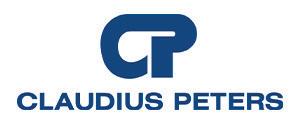




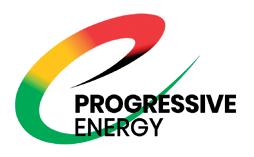
15 – 18 MARCH, 2026

Sign up today and secure your place at the heart of the cement industry’s decarbonisation discussion. Topics to be covered include:
• Additives & Admixtures
• Alternative Fuels
• Blended Cements & SCMs
• Carbonation & Circularity

• CCUS
EnviroTech attendees will benefit from a special rate at our venue located in the heart of London on the South Bank of the River Thames.
Ammenities include:
• Luxury accommodation with views over the Thames.
• Prime location in the heart of one of the world’s great cities.
• Multi award winning pan-Asian riverside restaurant and bar.
• Indoor pool and fitness centre.
Availability is limited, so take advantage of our special conference rate and book today.

Book your tickets and accommodation here!
For sponsorship opportunities please contact:
Rod Hardy Sales Director
rod.hardy@worldcement.com
• Digitalisation & AI
• Hydrogen
• Policy & Legislation
• Renewables
• Waste Heat Recovery



Lewis
Manager
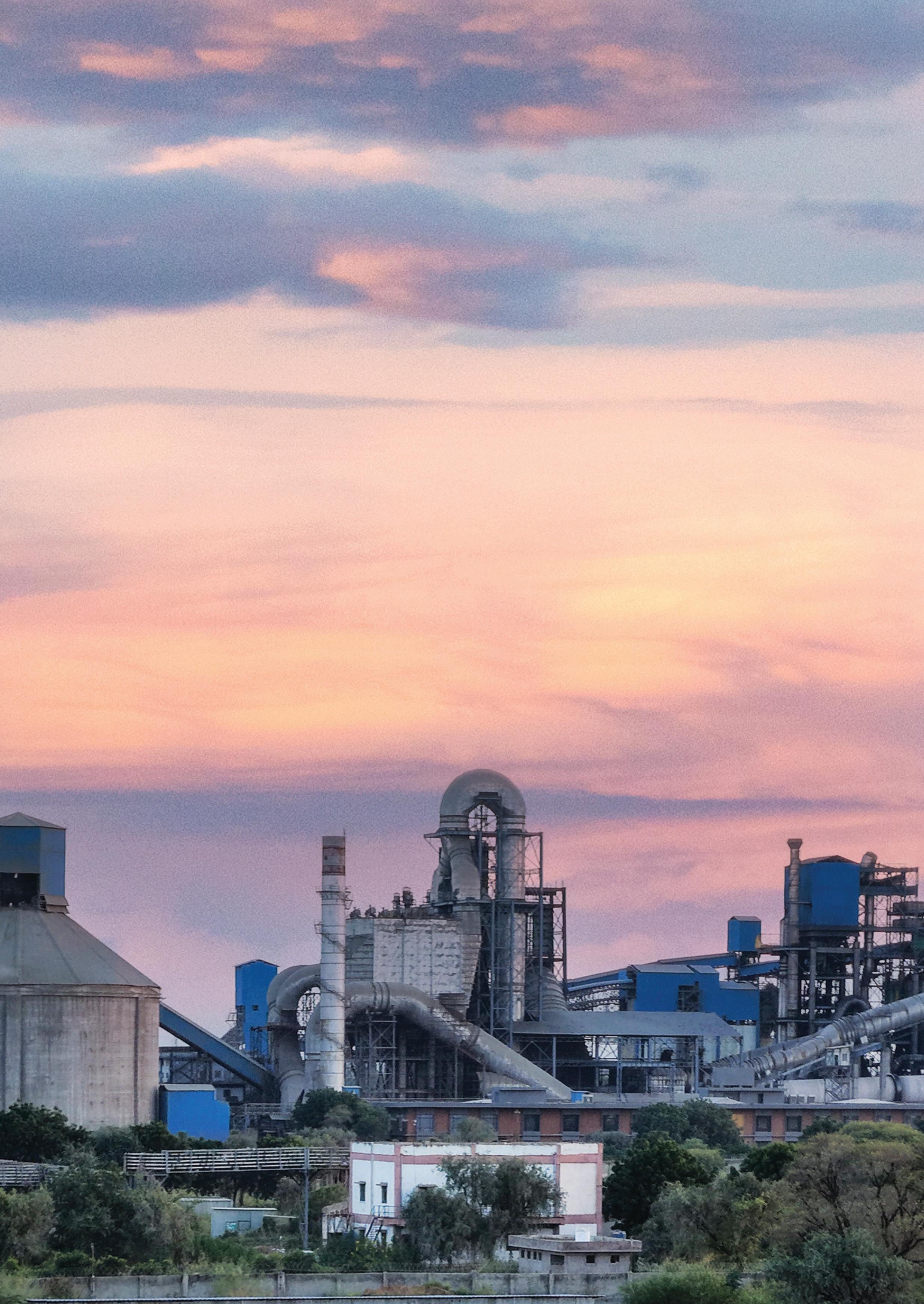



Cement plays a vital role in India's development, supporting the country's ambitions for long-term economic growth. As urbanisation accelerates, infrastructure projects like Smart Cities, Bharat Mala, and metro rail developments are driving steady demand for cement. With per capita consumption increasing, despite historically lower than global averages, India’s evolving urban landscape and infrastructure needs are expected to significantly boost cement demand in the years ahead.

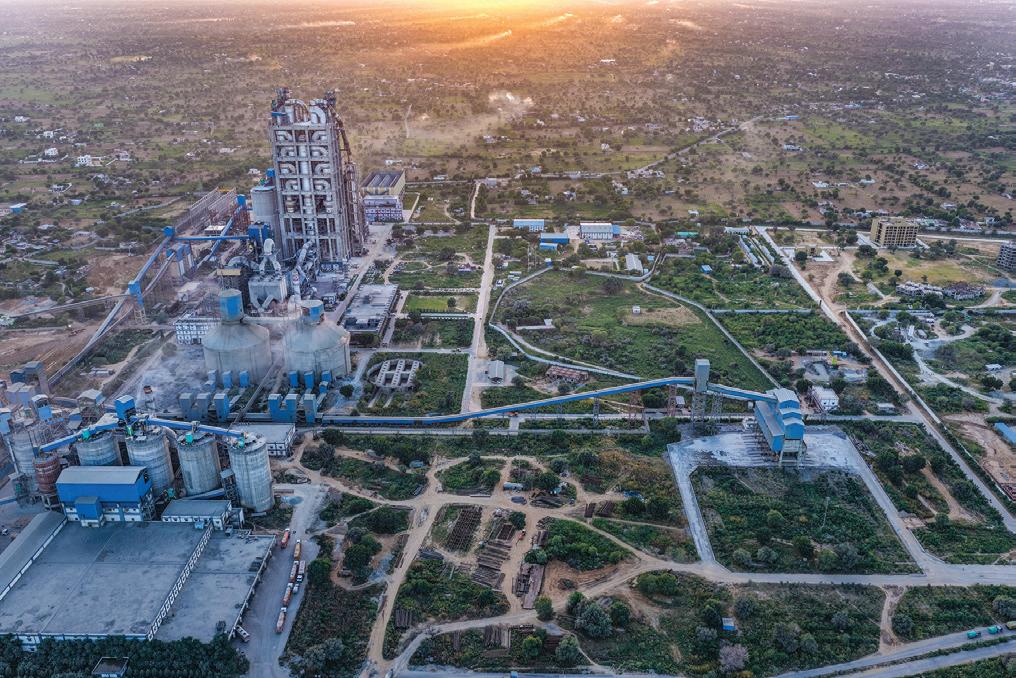

Shree Cement is well positioned to support India’s growth and is playing a pivotal role in the country’s expansive infrastructure development. The Nawalgarh plant will supply the wider region of North India with cement and clinker, feeding a number of grinding plants in the area.
With easy access to a rich supply of raw materials, Nawalgarh was an obvious choice for Shree Cement’s newest cement plant. As well as abundant reserves of limestone, the region also boasts strategic access to cement markets in Northern India, minimising logistical costs and delivery times, while also offering a competitive edge in these rapidly growing markets.
Though water scarcity is an issue in the region, the plant has committed to using modern, water-efficient technologies, ensuring minimal water consumption and waste.
For example, the OK Mill can be operated without using any water whatsoever if needed, making it an optimal solution in regions where water conservation is particularly important.
Satish Maheshwari, Chief Manufacturing Officer, Shree Cement, adds, “We have significantly invested in alternative fuels (AFs) – including hazardous waste, municipal solid waste (RDF), and biomass – to reduce fossil fuel reliance. Our new solid waste feeding system for MSW is operational at one site and is being replicated at others, enhancing AF use and improving thermal substitution in kilns.” The plant also follows Shree Cement’s principle of reducing clinker content in blended cements, which aims to reduce the carbon footprint of Shree Cement products.
The project kicked off with the issuance of the Letter of Intent (LOI) on 15 September 2021 for the raw mill. As per the LOI, equipment was expected to be delivered within 8 – 13 months from the contract’s effective date. The first lot of raw mill arrived on-site in May 2022, with the major consignment – the grinding table – delivered in February 2023. Civil work for the raw mill and its building began in May 2022 and was completed by January 2023. Fabrication was wrapped up by June 2023 and erection commenced in January 2023, concluding by September 2023. The final commissioning was completed on 14 December 2023, marking the operational start of the mill.


SSL, the market-leading cement shipping solution –now with enhanced analytics – delivers actionable intelligence. Learn the things you didn’t know you needed to know to sell more cement.
The world leader in logistics, automation and quality monitoring solutions for the cement industry
Work Smarter® · pscl.com
The Cross-Bar® Cooler at Nawalgarh is the largest in the world, with a grate area of 325 m2 and a throughput guaranteed at 11 500 tpd, though it has been running at around 13 500 tpd since commissioning. Offering both high throughput and highly stable operation, the cooler also contributes to Shree Cement’s sustainability goals thanks to its hot air recirculation, which generates about 8 MW through the waste heat recovery (WHR) system.
“With a Cross-Bar Cooler, the bigger you go, the greater your efficiency gains,” says Gowrishankar Ramachandran, Senior Product Specialist, Fuller. “We were not concerned about the size of the project – we knew we could achieve the performance guarantees with ease. Start-up was paced to get the full pyro system up and running smoothly, starting at 5000 tpd and quickly ramping up to full capacity and then beyond. The combination of features ensures smooth operation whatever is going on in the kiln and preheater, meaning the cooler is unfazed by the introduction of new AFs or variations in throughput.”
Featuring ABC Inlet technology, which ensures no build-up in the cooler, Shree Cement also benefits from the cooler’s heavy duty roller breaker (HRB) and mechanical flow regulators (MFRs) to improve reliability and uptime.
f The ABC Inlet uses a patented in-grate design that pushes compressed air up through the grates, blasting agglomerations. Pressure sensors detect when build-up is starting to occur and the automated blast control system reacts accordingly, increasing blast frequency to disperse the clinker and prevent further buildup.

f The HRB can handle clinker boulders up to 1.5 m without blockages. It features a series of transport and crushing rollers that allow right-sized materials to pass through and crush larger materials down to a pre-set size. Its low speed contributes to a long wear life of 3 – 5 years, while the rollout design enables easy maintenance.
f MFRs control airflow across the whole clinker bed – irrespective of clinker bed height, particle size, distribution, or temperature. This optimises heat recuperation and air distribution, reducing both fuel costs and the number of cooling fans required.
This cooler is a ventless system, with hot air being recirculated back into the cooler instead of bringing in ambient air. This improves the WHR temperature and boosts the power generated through the system.
With WHR from the preheater in addition to the cooler, the total power generated is around 15 – 18 MW.
Though the operation has the potential for high dust pickup, the cooler casings were enlarged so that dust pickup is less than 4 m/s. This reduces dust to the tertiary air duct and helps reduce the environmental impact of the cooler operation, as well as the wear
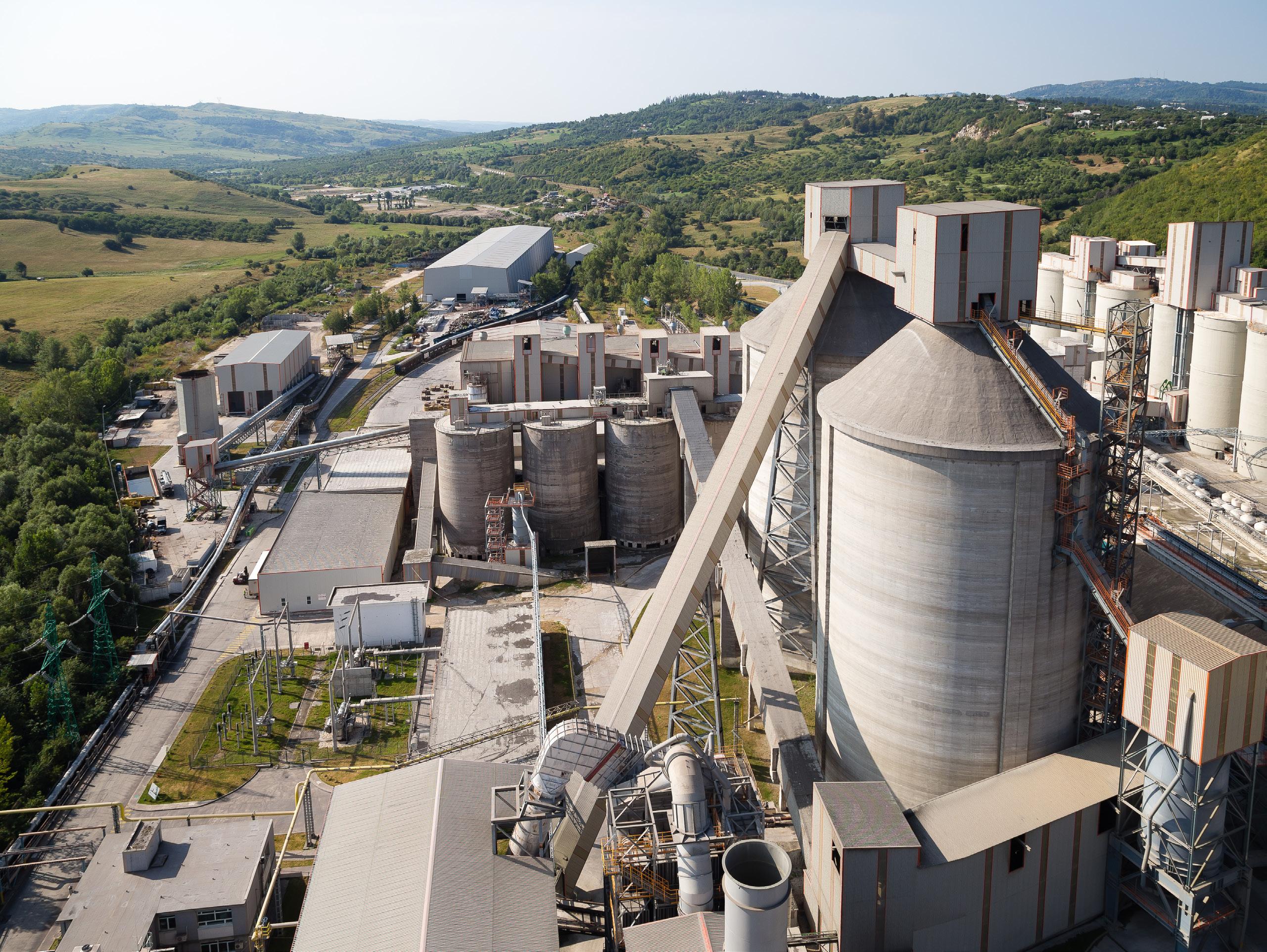
As your operations expand in the cement market, having a reliable partner is essential to support your growth and performance goals.
Regal Rexnord delivers durable, high-performance solutions that help minimize downtime and maximize efficiency across critical cement applications—from conveyors and crushers to cooling systems and bucket elevators. Our technologies are built to withstand extreme temperatures, heavy loads, and abrasive conditions, ensuring consistent operation in even the harshest environments.
Whether you’re optimizing existing systems or scaling for future demand, our expertise in motion control and power transmission helps keep your equipment running smoothly and your maintenance predictable.
Discover how Regal Rexnord can help you drive productivity and reliability in your cement operations.

Learn more at rrx.link/Regal-Rexnord-Cement
and safety issues that come with dust settling on equipment and on the local environment.
“Reliability is our number one priority,” explains Satish Maheshwari, Shree Cement. “Choosing a cooler design that eliminates snowmen formation, can process large boulders, and is very low maintenance was critical to ensuring a continuous operation capable of keeping up with the rest of our pyro line. We were so impressed with the performance of the system that we have ordered two identical lines for another plant, which are currently in the process of being installed.”
The cooler is part of the world’s largest pyro system, which includes:


f Four string preheater:
» Cyclone stage I : 7784 mm, Top (HR+).
» Cyclone stage II : 7984 mm.
» Cyclone stage III-VI : 8180 mm with low Nox calciner.
f Dia 6.0 m x 88 m long & 3 support kiln with forged tyres.
f JETFLEX 2.0 kiln burner (type standard and plus).
f 2 x 750 tph Pfister® FRW Rotor Weighfeeder 5.22/13 for Kiln feed and 6 x Pfister Smart Linear Feeder.
The Fuller Low NOx Calciner prevents the build-up of raw meal on the calciner walls and maintains a hot core for excellent combustion and NOx reduction. With a design based on extensive research, field tests, and CFD modelling, the Low NOx calciner is capable of burning almost any fuel type, giving Shree Cement full flexibility to switch between coal, petcoke, and AFs. The calciner has the added advantage of reducing NOx while also minimising the need for ammonia injection, creating a cleaner, greener, more cost-effective process.
The JETFLEX® burner was chosen for its high degree of fuel flexibility, further aiding Shree’s green ambitions. The burner can burn any mix of coal, petcoke, oil, natural gas, and AFs while maintaining an optimal flame shape. The flame formation is controlled by separate systems for axial and swirl air, ensuring fast ignition and stable flame formation with a shorter and more intense flame. That reduces volatility in the kiln and gives the Nawalgarh plant greater efficiency throughout the pyroprocess.
The OK Mill 66.6, selected as the raw mill for this plant, is the largest OK raw mill in the country with a guaranteed capacity of 1070 tph – though it has been running at 1080 tph since commissioning. The OK Mill was selected for its history of efficiency, low water use, and ease of maintenance. The rollers can be swung out for repair or hard-facing so that operations can continue with the remaining rollers, enabling continuous productivity. The OK-R-66-6 VRM for this plant includes a RARM-1300 separator, known for the simplicity of its design, which reduces wear and maintenance, lowers differential pressure, and reduces mill fan power (and thus operational costs), while still providing efficient separation.
This is not the only OK Mill at the Nawalgarh plant. An OK 66-6 finish mill with ROKSH-1100 classifier is employed for cement grinding at 360 tph. In addition, the plant has an ATOX 32.5 coal mill with RAKM-32.5 classifier for
coal grinding – guaranteed at 46 tph but running at 56 tph.
“Every large-scale project brings its own set of exciting intricacies, and this installation was no exception,” says Satish Maheshwari, Chief Manufacturing Officer, Shree Cement.
“The integration of key components such as the grinding table and classifier required precise calibration to ensure the mill’s optimal performance in producing high-quality cement. Coordinating the different phases – civil work, fabrication, and erection – was accomplished through proactive planning and seamless teamwork between ourselves and Fuller. Our approach focused on leveraging technical expertise and adaptive management strategies, which allowed us to navigate each phase smoothly and efficiently. The successful commissioning of the mill stands as a testament to our commitment to excellence and continuous innovation throughout the project.”
Energy efficiency, energy saving, and energy production
Shree Cement is committed to reducing its environmental impact and has deliberately selected solutions and processes that enable a reduction in resource use. Energy-efficient grinding operations and a pyro process that prioritises WHR enable the plant to reduce its carbon footprint without compromising productivity.
“Energy conservation remains a top priority for us, driving innovations from shop-floor experiments to major capital investments,” explains Satish Maheshwari, Shree Cement.
“These efforts have reduced carbon emissions and production costs. Over 55% of our energy needs across the company are met through green energy sources, including solar and wind power alongside our WHR systems. Combined, these systems produce in excess of 520 MW. We consistently exceed PAT Cycle targets and have been honoured as ‘best performer’ for the highest number of energy-saving certificates in both PAT Cycle I and II by the Bureau of Energy Efficiency.”
Shree Cement is an advocate of the benefits and necessity of digitalisation to improve cement plant performance and efficiency. A few years ago, Shree Cement rolled out ECS/PlantDataManagement across 16 plants and 24 lines in a huge digital upgrade to drive efficiency and increase productivity. The new Nawalgarh plant does not require a digital transformation, however, because it has been built as a digital native. It is equipped with ECS/PlantDataManagement,
which delivers all plant and process data in accessible and practical forms to plant managers and operators, maintenance teams, analysts, and decision-makers, giving them the insights necessary to optimise production lines, minimise equipment downtime, improve productivity, and reduce environmental impact. ECS/PlantDataManagement includes important tools like UptimeGo, the downtime analysis solution, and SiteConnect, the mobile app that allows plant operators and managers to view real-time plant data anytime, anywhere from a mobile device.
The plant is also utilising advanced automation solutions across the plant, including in the laboratory where Fuller is enabling clinker substitution while ensuring optimal cement quality. QCX®/RoboLab is a high-tech robotics solution for automated sample preparation, analysis, and automated quality assurance and quality control procedures.
This advanced automation system ensures fast, accurate, and safe analysis with as few operators as possible.
It receives and co-ordinates samples from the QCX/AutoSampling system and can take on challenging laboratory tasks to ensure optimal quality control in the face of variations in AFs and changes to the cement mix. Again, this was a choice Shree Cement made to ensure the plant has the flexibility to deliver lower carbon cements without compromising on final product quality.
In December 2024, Shree Cement celebrated the first anniversary of the Nawalgarh plant, marking a significant milestone in its journey of innovation and operational excellence. The plant’s rapid rise as a leading player in cement production aligns with the global position of this company, whose strategic initiatives in AFs, emissions reduction, and water management have earned industry-wide recognition, including the acclaimed position of ‘industry mover’ in the construction materials category of the S&P Global Sustainability Yearbook 2025.
Shree Cement’s focus on blended cement production has lowered natural resource consumption and CO2 emissions by 7.2 million t in FY23-24, with 73.52% of total production comprising blended cement, with an average clinker-to-cement ratio of 64.66%.
“Partnering with a solutions provider like Fuller enables us to turn our sustainability ambitions into reality,” says Satish Maheshwari, Shree Cement. “Together we are shaping the future of our industry and our region, and we are very proud of the contributions we are making towards a more sustainable cement industry and greater economic prosperity.”

Cliona Cunningham, Cement Europe, outlines how a strategic rebrand and new action plan are helping the cement sector drive Europe’s industrial transition toward climate neutrality and competitiveness.

urope’s industrial transition is entering a decisive phase, with competitiveness and climate change under an overarching growth umbrella. The cement sector is stepping up with a clear, coordinated strategy to ensure Europe can decarbonise while staying strong. The rebranding of CEMBUREAU to Cement Europe marks a turning point: a shift from traditional representation to strategic leadership, and from planning to deployment.
CEMBUREAU’s new identity – Cement Europe – reflects what the sector stands for today. Cement Europe speaks for an industry that is not only foundational to Europe’s infrastructure and economy, but also central to its climate and competitiveness goals. The rebrand follows a sector-wide narrative exercise that positions cement as a solution provider – one that builds the homes, transport networks, renewable energy systems, and climate adaptation and defence infrastructure Europe needs.
The updated visual identity is bold, architectural, and minimalist, designed to resonate with policymakers, partners, and the public.
It reflects the sector’s strategic relevance to the EU’s priorities, its local footprint with 200 plants and 57 000 direct jobs, and its leadership in circularity and low-carbon innovation.
“Our new identity is a statement of intent,” said Koen Coppenholle, CEO of Cement Europe. “Cement Europe stands for our history of reliability, our role as a constant ally to society, and our determination to drive positive change. We are ready to innovate, collaborate, and help shape a sustainable, resilient future for Europe under the right competitive conditions.”
But the rebrand is only one part of the story. Cement Europe has developed a new strategic framework that builds on the net zero roadmap – first published in 2020 and updated in 2024 – and translates it into a deployment-focused agenda. This new Action Plan responds directly to the Clean Industrial Deal and the Draghi Report’s call for sector-specific strategies, investment certainty, and a ‘sense of urgency’ in addressing the competitiveness of the European industry. It also reflects the growing political recognition of cement’s role in Europe’s industrial transformation, as highlighted in President von der Leyen’s recent State of the Union address.
The sector has set a CO2 emission reduction target of 50% by 2030 and 78% by 2040, aiming to achieve net zero in cement production by 2050 – with the potential to deliver negative emissions across the cement-concrete value chain. But these are not just numbers. There are 120 projects currently underway, addressing a wide range of levers across the value chain, including the use of alternative fuels, reducing clinker content in cement, increasing energy efficiency, and, for 43% of the reduction effort, deploying carbon capture and usage/ storage (CCU/CCS) technologies. These initiatives demonstrate that the sector is ready to scale innovation and deliver real impact. The roadmap laid the foundation; the Cement Action Plan builds on this by injecting a sense of urgency – calling for the regulatory, financing, and infrastructure frameworks needed to make the transition a reality. It shifts the conversation from ‘what’ to ‘how’ – from technical potential to real-world delivery.
Basic industry competitiveness is still being held back by structural barriers. Electricity prices are still two to three times higher compared to pre-crisis levels and significantly higher than in EU neighbouring countries, which have increased their exports into the EU. Regulatory uncertainty around the future of ETS allowances and the lack of clarity on ETS benchmarks continue to weigh heavily on both short- and long-term business planning. Reaching final investment decisions on decarbonisation projects requires not only a stable policy environment, but also targeted financial support where justified. Deploying breakthrough technologies at scale demands more than ambition – it requires robust public funding, effective de-risking mechanisms, and the timely rollout of enabling infrastructure such as CO2 transport and storage infrastructure. Permitting procedures are slow and fragmented, making it difficult to move from project to execution. At the same time, global trade flows are shifting, and imports from neighbouring regions with weaker climate policies are rising, thus threatening Europe’s climate leadership and industrial base.
The Cement Action Plan not only raises the sense of urgency – it also reaches out to policymakers at both EU and national level to ensure a shared effort in maintaining a competitive and climate-aligned cement industry in Europe.
At the heart of this agenda are a few essential enablers: a well-functioning, interconnected electricity market that delivers low-carbon energy at affordable prices, a level playing field through a robust and enforceable carbon border adjustment mechanism (CBAM), and finally legal certainty to support both short- and mid-term business planning.
Bringing breakthrough technologies to deployment at scale will require more than ambition – it demands robust public grant programmes, funded through instruments like the Innovation Fund and ETS revenues, alongside the rapid development of CO2 transport and storage infrastructure.
Finally, the right regulatory incentives must be in place to drive market uptake of low-carbon cement and concrete through public procurement, product standards, and labelling that reward climate performance.
The sector’s local value chain is a strategic asset. Cement is produced, used, and recycled locally supporting regional economies and reducing supply chain vulnerabilities.
The Action Plan builds on this strength, positioning cement as a driver of strategic autonomy and industrial resilience. In a geopolitical context where Europe is seeking to reduce dependencies and reinforce its industrial base, cement offers a tangible, scalable contribution.
“We are moving from ambition to execution,” said Koen Coppenholle. “Our members are rolling out low-carbon technologies, scaling circular practices, and preparing their teams for the future. But we need Europe to match this momentum – with policies that enable investment, infrastructure that supports deployment, and markets that reward climate performance. Cement is not holding back the transition – it’s helping to build it.”
With the right framework in place, Cement Europe can help lay the foundations of a climate-neutral, competitive, and resilient Europe. The sector is ready. The time to act is now.
Cliona Cunningham is Public Affairs and Communications Director at Cement Europe, where she leads advocacy and communications on policies shaping the cement sector’s transition to climate neutrality, competitiveness, and circularity. She works closely with EU institutions and industry partners to strengthen the sector’s voice in Europe’s green and industrial transformation.

MART™Series nozzles are engineered to blast through the toughest build-up, delivering maximum air cannon force with a precise blast pattern to keep material flowing. For the most severe conditions, our proprietary retractable nozzles extend into the material stream when fired, then pull back automatically to withstand extreme heat and relentless abrasion.
The innovative Y-shaped design of our SMART ™ Series assemblies allows the air cannon and nozzle be installed independently. Service, inspection, and replacement are done entirely from outside the vessel — no cannon removal, no cutting through refractory — limiting downtime, preserving linings, and reducing risk of injury.
SMART ™ Series nozzles from Martin. Brilliant.
Formerly FLSmidth Cement

From India’s largest OK™ Mill to the world’s biggest Cross-Bar® Cooler, every system was designed to achieve more with less.
Reliability, efficiency, and proven performance

True to Shree Cement’s commitment to sustainability, the plant was designed with a targeted approach to energy efficiency, reducing water consumption, fuel substitution and lower carbon cement blends. We are proud to have supplied a state-of-the-art pyro system and OK™ mills for both Cement and Raw grinding. Furthermore, the automated laboratory featuring a QCX/RoboLab® System gives the plant flexibility to deliver lower carbon cements without compromising final product quality.
PROVEN PERFORMANCE MEASURED IN RESULTS
13,500
325 TONS PER DAY
Well exceeding the design capacity of 11,500
TPH OK™ MILL FUEL FLEXIBILITY SQM
Cross-Bar® Cooler grate area – world’s largest in operation.
1070 ~ 100%
Energy efficient, low water use and ease of maintenance
Delivered by the pyro system featuring Low NOx Calciner, PFISTER® feeders and JETFLEX® burner

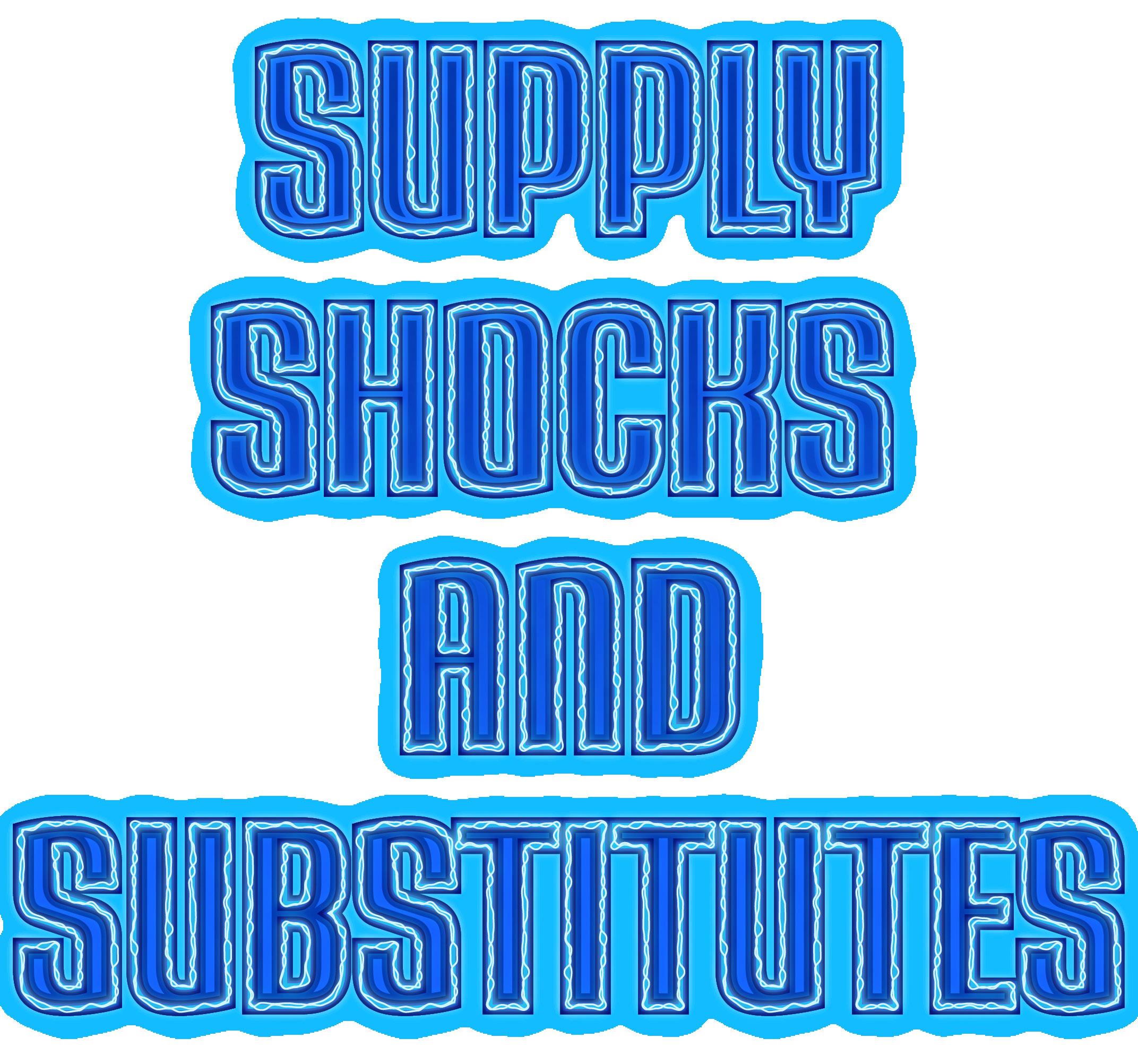
Dr S B Hegde, Jain College of Engineering and Technology and Pennsylvania State University, explores the shifting dynamics surrounding raw materials for cement production and the strategies needed to ensure supply chain resilience and support carbon reduction.

ement is indispensable to modern infrastructure. From highways in the US and Europe to high-rise buildings in Asia and Africa, cement provides structural integrity, longevity, and affordability. However, this versatility comes at a cost. Producing 1 t of cement emits approximately 0.85 t of CO2 and consumes around 1.5 t of raw materials, particularly limestone.
In 2024, global cement production exceeded 4.1 billion t, with leading producers including China, India, the EU, the US, and Brazil. This scale of production creates immense pressure on raw material sources and supply logistics.
Across continents, the cement industry is grappling with overlapping crises – raw material quality degradation, shifting industrial waste flows, and fragile supply chains impacted by geopolitical tensions. Global climate policies, such as the EU Carbon Border Adjustment Mechanism (CBAM), are adding another layer of complexity by penalising emissions-heavy supply chains. A critical re-evaluation of material strategy is now essential – not only for operational efficiency but also for carbon compliance, ESG performance, and long-term resilience.
In regions such as Southeast Asia, North Africa, Southern Europe, and parts of Latin America, cement-grade limestone deposits are showing signs of depletion or marginal quality.
The key concern lies in falling lime saturation factor (LSF) and increasing MgO content, which destabilise the clinkerisation process. For instance, North African plants report a drop



in average CaO content from 52.5% in 2010 to below 49.5% in 2023. Similar trends are reported in Turkey, Brazil, and China’s inland provinces.
As deposits become heterogeneous and high-grade seams are exhausted, cement manufacturers are turning to advanced beneficiation techniques. Froth flotation, high-gradient magnetic separation, and sensor-based ore sorting (XRT, NIR) are now common in regions like Spain, Saudi Arabia, and India. In Switzerland and Germany, real-time mineral analysis using LIBS and XRD sensors has enabled dynamic raw mix adjustments with a standard deviation of LSF reduced by 25 – 30%.
The global shift away from coal and blast furnace-based steelmaking is transforming the landscape of supplementary cementitious materials (SCMs).
The generation of fly ash and GGBFS is on a long-term downward trend. In the US, fly ash production dropped from 37 million t in 2010 to 23 million t in 2023.
In the EU, especially Germany and Poland, the closure of lignite plants has sharply reduced fly ash availability. Table 1 illustrates the changing SCM availability trends in selected regions (2015 – 2025).
The SCM gap is being addressed through material beneficiation (e.g., fly ash classification in the US and Germany), and the development of new binders.
However, logistical challenges persist, particularly for regions where SCM generation and cement consumption are not co-located. Shipping classified fly ash from South Africa to the Middle East is an emerging trend but poses carbon cost concerns.
Global cement players are increasingly exposed to volatile international markets for gypsum, petcoke, and synthetic slags.
For instance, geopolitical events like the Russia-Ukraine conflict and the Red Sea crisis have disrupted logistics from the Middle East to Europe and South Asia. Trade restrictions on Venezuelan and Iranian petcoke have tightened global supplies. Table 2 summarises the key geopolitical risks.
To mitigate these, global companies like Holcim and CRH are investing in synthetic gypsum production, local biomass fuel
sourcing, and supply chain digitisation using block chain-based traceability.
Digital twins and real-time quarry analytics are revolutionising raw material handling. In France, Vicat has implemented drone-based LIDAR terrain mapping, integrated with AI prediction models to forecast CaO and MgO zones. In Brazil and Morocco, automated crushers linked to XRD feedback loops adjust mix proportions to maintain target LSF and silica modulus in real time.
Such digital quarries reduce variability and improve yield from lower-grade deposits. Plants in Germany and the UAE report a 15 – 20% improvement in kiln stability and up to 0.8% clinker factor reduction due to improved homogenisation.
Alternative binders are gaining global momentum. LC3 is now commercially used in Switzerland, India, and Colombia, with
ongoing trials in Kenya and Vietnam. Red mudbased cements are being explored in Australia and China, while Brazil and Thailand are scaling up use of sugarcane bagasse ash. Hybrid systems that blend two or more alternative SCMs are being developed for optimised cost-performance-carbon balance. EU Horizon-funded projects like FReSCO are pushing for binder standards harmonisation.
Predictive kiln models using neural networks are enabling process stabilisation even with variable raw mix chemistries. In China, SINOMA has integrated AI in its flagship kilns, achieving up to 2% thermal efficiency gains. Meanwhile, Heidelberg Materials has deployed digital twins
Synthetic slag Japan, South Korea South China Sea

like
With a strong partner, you can overcome any obstacle.
Just as athletes rely on their teammates, we know that partnering with our customers brings the same level of support and dependability in the area of manufacturing productivity. Together, we can overcome challenges and achieve a shared goal, optimizing processes with regards to economic efficiency, safety, and environmental protection. Let’s improve together. Do you want to learn more? www.endress.com
in German and Canadian plants to simulate clinkerisation and forecast emissions.
Machine learning is also being used in the US and Japan for real-time SCM quality classification, ensuring compliance with ASTM and EN standards despite material heterogeneity.
Policies such as the EU CBAM, Canada’s Clean Fuel Regulations, and India's Performance-Linked Incentive (PLI) scheme for green cement are reshaping raw material sourcing. Cross-border emissions accounting will penalise clinker-heavy imports. International collaboration is required for:
f Cross-certification of low-carbon cements.
f Incentives for clay calcination and ash beneficiation.
f Green freight corridors for SCM logistics.
Material traceability is now part of ESG compliance. Cement majors are integrating sustainability-linked bonds and green loans based on KPIs such as raw material substitution rate, carbon intensity, and clinker factor.
For example, Holcim’s Green Finance Framework targets >50% SCM substitution by 2030, while Votorantim Cimentos’ 2023 report disclosed 87% transparency in raw material origin.
The cement industry faces unprecedented challenges – but also opportunities. From Africa’s limestone beneficiation needs to Europe’s fly ash shortfall, from Southeast Asia’s digital quarries to Latin America’s biomass SCMs, innovation must be localised yet globally informed. By embedding circularity, digitalisation, and climate resilience into raw material sourcing, cement producers can navigate this transition effectively. This is not merely an engineering task – it is a redefinition of material economics for a decarbonised global infrastructure future.
1. International Energy Agency (IEA). (2023). Technology Roadmap: Low-Carbon Transition in the Cement Industry. Paris: IEA.
2. World Business Council for Sustainable Development (WBCSD) – Cement Sustainability Initiative. (2024). Global Cement Industry Environmental Benchmarking Report. Geneva: WBCSD.
3. U.S. Geological Survey (USGS). (2023). Minerals Yearbook: Cement, Fly Ash, and Slag. Reston, VA: USGS.
4. Global Cement. (2024). Global Cement Report –14th Edition. Dorking, UK: Tradeship Publications Ltd.
5. European Cement Association (CEMBUREAU). (2023). Status Report on SCM Availability in Europe. Brussels: CEMBUREAU.
6. Holcim Ltd. (2023). Integrated Annual Report 2023: Financing a Net-Zero Future. Zug, Switzerland: Holcim.
7. Votorantim Cimentos. (2023). Sustainability Report 2023. São Paulo, Brazil.
8. Cement and Concrete Research. (2022). Special Issue: Alternative Binders and SCM Innovation. Volume 161, 106973.
9. SINOMA International Engineering Co., Ltd. (2023). AI-Driven Kiln Optimization White Paper. Beijing: SINOMA Group.
10. Heidelberg Materials. (2024). Digital Twin and Circularity Programs. Heidelberg, Germany
11. European Union. (2023). Carbon Border Adjustment Mechanism (CBAM): Implementation Guidelines. Brussels: European Commission.
12. ASTM International. (2022). Standard Specification for Coal Fly Ash and Raw or Calcined Natural Pozzolan for Use in Concrete (ASTM C618). West Conshohocken, PA.
13. Indian Bureau of Mines. (2022). Limestone Resource and Quality Survey Report. Nagpur, India: Government of India, Ministry of Mines.
14. Cement Manufacturers Association (CMA). (2024). SCM Flow and Market Assessment Report – South Asia. New Delhi, India.
15. FReSCO Project. (2023). EU Horizon 2020 Research Update on Hybrid Binders. Vienna: European Cement Research Academy (ECRA).
About the author
Dr S B Hegde is an industrial leader with expertise in cement plant operation, optimisation, new product development, and cement plant establishment. He is currently a Professor in the Department of Civil Engineering at Jain College of Engineering and Technology, Hubli, India, and a Visiting Professor at Pennsylvania State University, US.
traditional portland cement is undergoing a drastic transformation.
Every cement plant faces its own challenges: from the composition and availability of local raw materials to limitations in clinker supply and variation in operational conditions. Added to this are evolving environmental regulations,


variable energy costs, new carbon taxes and societal expectations for more sustainable solutions. All this has led to an exponential increase in the use of alternative and more environmentally friendly supplementary cementitious materials (SCMs) in cement production.
SCMs offer a viable alternative to optimise clinker factor, reduce CO2 emissions, and reduce production costs. However, their use requires tailored solutions, as the ‘one-product-fits-all’ approach does not deliver the optimal performance any longer. This is particularly relevant as traditional SCMs such as fly ash and slag become scarce or inconsistent and producers are turning to new sources such as natural or lower-reactivity calcined clays or volcanic pozzolans, whose specific mineralogy and reactivity require careful handling.
To address complexities, the role of precise analytical sampling and material characterisation becomes more relevant. Reliable data on the chemical and mineralogical composition of clinker and blended material is essential to ensure the consistency and performance of the final product and to support the formulation of effective cement additives.
Sika has developed a new generation of SCM-specific cement additives within the SikaGrind® range. These solutions are formulated to allow higher clinker reduction without sacrificing performance. New chemical building blocks can improve grinding
efficiency, enhance strength development and optimise rheology, while helping producers reduce their environmental footprint.
As SCMs are generally much less reactive than clinker, the higher substitution rates often lead to reduced cement performance, especially at early ages. This makes the optimisation and control of clinker quality and reactivity increasingly critical and requires more attention than ever. Therefore, the development and formulation of new chemical solutions goes hand in hand with clinker quality optimisation, for which Sika relies on advanced analytical techniques specifically used to classify, compare, and optimise raw materials, clinker, and cement blends.
The production of portland cement clinker involves high-temperature reactions among clinker raw materials, which lead to the formation of key mineral phases. To ensure consistent clinker quality, it is essential to understand its chemical and mineralogical composition.
Analytical techniques such as X-ray fluorescence (XRF), X-ray diffraction (XRD), and microscopy play a crucial role in diagnosing clinker characteristics, detecting deviations in production conditions, and supporting corrective measures.
For instance, and among others, chemical analysis through XRF identifies deviations in raw meal chemistry and flags issues like excess sulfur, alkalis, or free lime. XRD confirms the presence and proportion of


clinker phases, verifying whether burning conditions are sufficient to achieve the desired mineral transformations.
Microscopy supports these findings with visual evidence, revealing structural and morphological indicators of process stability or disruption. Interpreting these data sets collectively, operators can pinpoint specific areas for improvement – such as adjusting the raw mix composition, optimising kiln temperature and fuel input, or modifying the cooling rate to favour proper crystal development.
Despite being extensively applied online during clinker production, those techniques are mainly used as QC to ensure clinker composition remains within defined boundaries, but the data collected are too rarely used to support a comprehensive understanding and optimisation of clinker quality.
Through the systematic integration and in-depth use of XRF, XRD, microscopy, and other methods in its approach, Sika provides cement producers with diagnostic tools and performance optimisation strategies. These methods not only facilitate quality control but also support process optimisation by linking microstructural and chemical characteristics to
kiln performance. Their combined use enables rapid identification of improper production parameters and guides evidence-based decisions to improve clinker quality and overall plant efficiency. Based on this information, cement producers and Sika can clear decisions together on additive selection, blending strategies, and production adjustments towards enhancing the performance of more sustainable blended cements.
The following case studies show that more than a simple chemical supplier, Sika is a skilled and experienced technological partner, able to support its cement customers in all aspects of their process value chain and in their journey towards the production of high-performance blended cement.
A cement producer implemented an alternative grinding strategy. While only minor differences were observed in the particle size distribution (PSD) and Blaine surface area, these variations were insufficient to explain a significant drop in cement reactivity. Thanks to its analytical capabilities and specialists, Sika investigated

this problem further, and scanning electron microscopy (SEM) analysis revealed notable differences in particle morphology.
Under the standard grinding configuration, cement particles exhibited angular, rough surfaces with a high degree of fragmentation, with numerous fine grains attached to larger particles, indicative of an aggressive, high-energy grinding process (Figure 1, left). In contrast, the alternative grinding approach produced particles that were more flake-like and layered, with smoother surfaces and fewer fine fragments (Figure 1, right), suggesting a gentler grinding mechanism or one that favoured cleavage along specific crystallographic planes.
Recognising that these morphological changes could be responsible for the reduced reactivity, the Sika local team reformulated a tailored cement additive, including building blocks specifically targeting the altered particle characteristics, successfully restoring the cement’s performance to the expected level.
Over the years, a cement partner progressively increased the use of alternative fuels (AFs) in their kiln system. While this shift supported sustainability goals, it gradually led to a decline in cement performance, eventually reaching a point where conventional cement additives could no longer compensate for the loss in reactivity.
To address this issue, a joint investigation with Sika was initiated. Through a combination of process analysis and microstructural evaluation, including detailed clinker microscopy, the teams identified that the improper combustion of the AF was disrupting the flame shape and kiln temperature profile, which in turn,
negatively affected the clinker’s microstructure but also, the degree of conversion from belite (C2S) to alite (C3S) and the overall cement phase assemblage.
Figure 2 consists of two images taken from the same clinker produced with two levels of AF. It shows for instance clear changes in the size and distribution of crystals and homogeneity of the clinker nodules.
Based on this insight, the cement producer adjusted the injection strategy of the AF to optimise combustion and restore a stable thermal profile in the kiln.
As a result, clinker quality improved and cement performance returned to expected levels, fully supported by the tailor-made additive formulation from Sika.
Raw meal variability and AFs can significantly impact kiln operation and clinker chemistry. These changes affect not only the formation and reactivity of individual crystals but also the overall phase composition of the clinker.
For example, variable magnesium oxide levels, originating from uneven dolomitisation states of the limestone quarry, can shift the C3A/C4AF balance to large extents.
Figure 3 shows that over a 6 month period, following MgO variations, aluminate phase contents can vary by a few percent. Since C3A is a key reactive phase targeted by many chemical additives, such fluctuations from 4 to 8%, as seen in this case, can undermine additive performance and lead to inconsistent cement quality.
By having access to this information, Sika anticipates these variations and can develop robust additive solutions that adapt to evolving clinker chemistries, ensuring stable performance even under challenging conditions.

The few examples detailed in this article demonstrate how a skilled and experienced technological partner can support its cement customers on all aspects of their process value chain and in their journey toward the production of high performance blended cement.
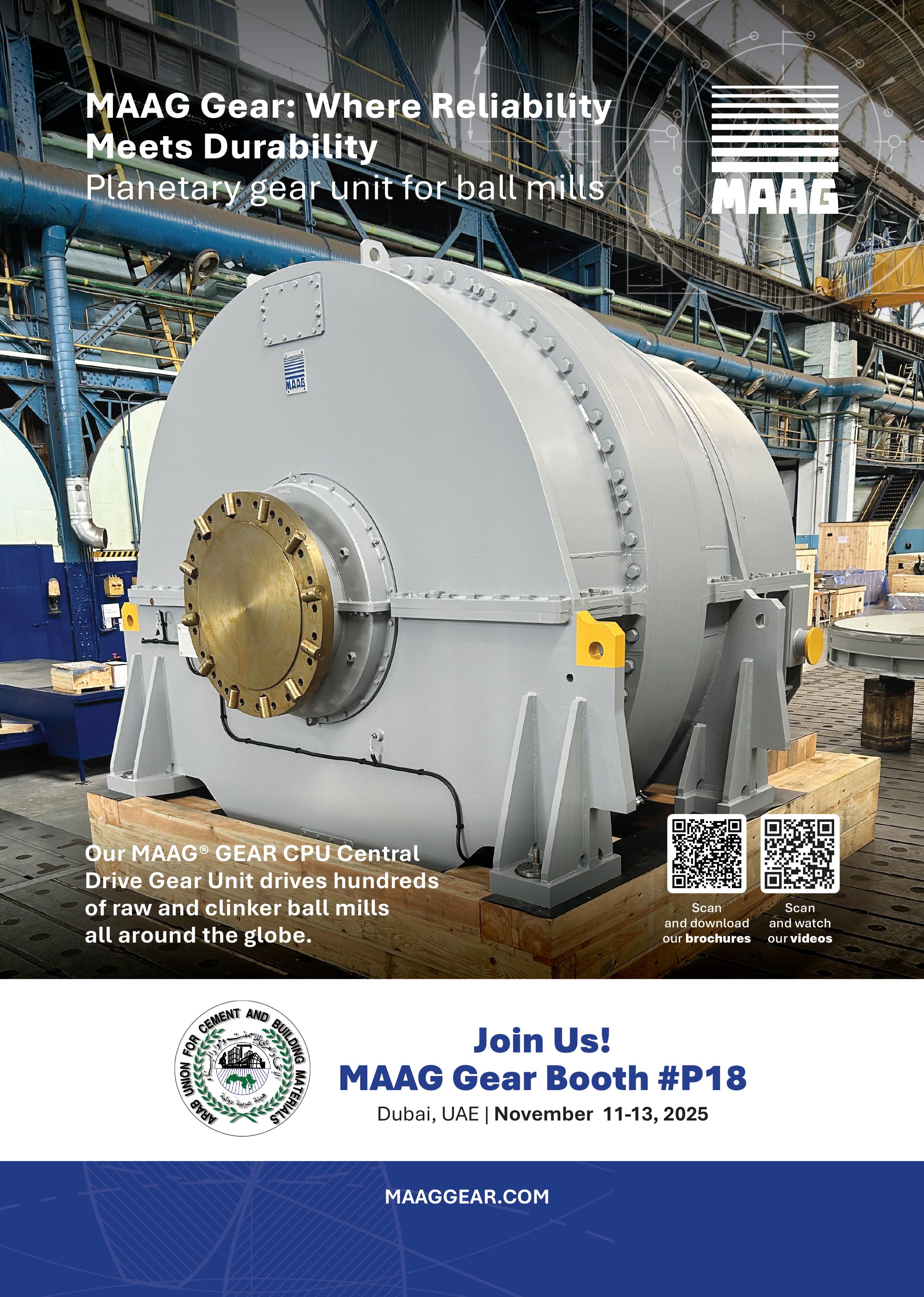
Jon Siverling, Regal Rexnord, reveals why gearbox recertification is the smarter way forward.
n an industrial environment –especially within the cement industry – uptime is expected in conditions that are unforgiving, making the reliability of machinery and mechanical systems an absolute necessity. Gearboxes are among the most critical components within this ecosystem. They serve as the metaphorical backbone of power transmission across some of the most essential machinery in operations. These systems face the elements

head on and endure constant stress, dust, heat, and vibration, and so their longevity hinges on a proactive approach to servicing and maintenance.
Traditionally, when a gearbox begins to show signs of wear or failure, the default response has been to repair what is possible or replace the unit entirely. However, in today’s climate – marked by extended lead times, tight budgets, and growing sustainability initiatives – this approach is increasingly being reconsidered.

A growing number of operators are turning to recertification and refurbishment as smarter, more strategic alternatives to repurchasing. This shift not only reduces costs but also encourages a more sustainable and lifecycle-focused approach to managing industrial assets.

Before and after refurb. Refurbishment brings new life to a gearbox by replacing worn parts and repairing housings to ensure they can withstand the harsh operating environments they are commonly subjected to.

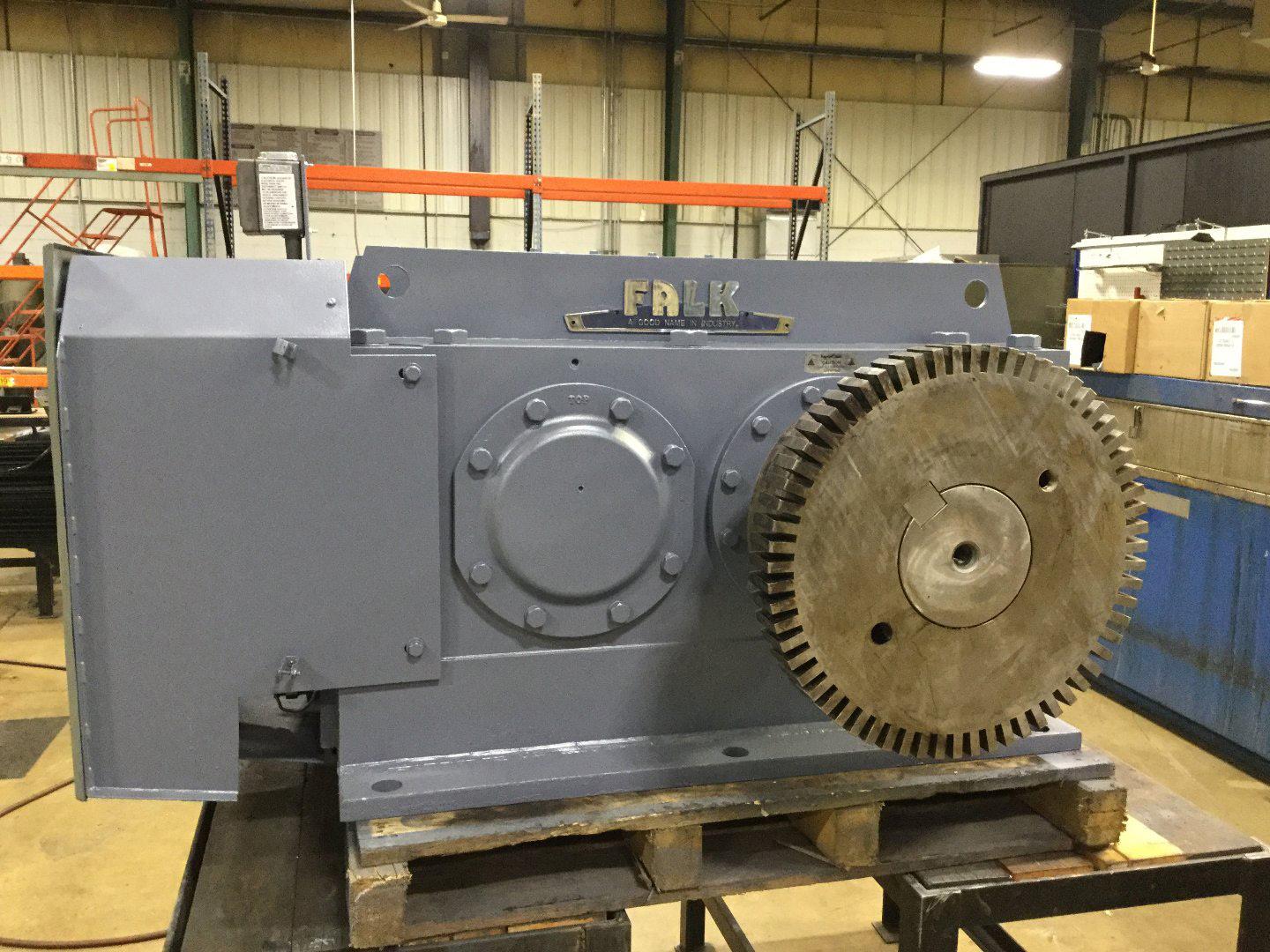
Gearboxes are integral to the manufacturing processes in many operations, and the cement industry is no outlier. They convert motor speed and horsepower to torque levels suitable for heavy-duty applications, which enables their precise control and efficient operation. Whether they are driving rotary kilns, grinding mills, or bucket elevators, gearboxes must instil confidence and perform reliably under extreme loads and environmental conditions with ease.
Over the years, gearbox technology has evolved to meet these demands head on.
Modern units are designed with improved sealing, heat dissipation, and modularity for ease with any operation’s needs. However, even the most advanced gearboxes are subject to wear. Bearings degrade over time, seals fail, and gear teeth unavoidably wear down – all of which can lead to costly downtime if not addressed or accounted for properly.
In most cases, gearbox issues are rarely minor. A single failure can halt operations, spread additional stress to other components, and disrupt supply chains entirely. Common gearbox problems include:
f Lubrication breakdowns leading to advanced gear wearing.
f Contamination from elements, including dust and debris.
f Thermal stress speeding up the degradation of seals and lubrication.
f Vibrations from misalignment or improper installation.
When issues like these arise, operators are faced with an important decision: repair, replace, or recertify. While purchasing a new unit may seem like the most straightforward and obvious solution, it often comes with longer lead times, higher costs, and logistical challenges. In contrast, recertification offers a path that is faster, more economical, and increasingly viable thanks to advancements in service capabilities from manufacturers.
In most cases, trying to avoid the need for any significant downtime should always be the priority. Effective gearbox
management begins with routine maintenance. Onboard technicians and modern monitoring software systems play a vital role in monitoring performance, conducting inspections, and performing minor repairs when available.
Technicians’ trained eyes – alongside monitoring software – can catch early signs of trouble like vibration anomalies, temperature spikes, or oil discolouration that might otherwise go unnoticed.
However, even with diligent maintenance, gearboxes will eventually require more extensive intervention. It is at this point that operators typically face the decision mentioned above:
f Purchasing a new gearbox, which ensures a fresh start but comes with a high capital expenditure and potential delays.
f Recertifying the existing unit, which involves disassembly, inspection, replacement of worn components, and reassembly to OEM standards.
Recertification is often overlooked, yet it offers compelling advantages. It allows operators to retain the original housing and footprint, minimising installation complexity. It also opens the door to upgrades in the form of new seals, improved bearings, or enhanced lubrication
systems that can extend the unit’s life and performance.
Another upside to recertifying is that operators could be more inclined to stock additional recertified gearboxes with their savings to ensure minimal downtime when sending a damaged gearbox for repair. This allows operations to continue and provides the advantage of cycling spare parts to avoid costly downtime without waiting for shipments and risking delays.
The case for recertification: cost, speed, and sustainability
Recertification is a strategic investment in operational efficiency and comes with many benefits:
f Faster turnaround. Refurbishing an existing gearbox can be significantly quicker than waiting for a new unit to be manufactured and shipped. This is especially valuable in time-sensitive operations.
f Lower total cost of ownership. By extending the life of existing assets, recertification reduces capital expenditures and avoids the hidden costs of downtime, installation, and training.
f OEM-grade quality and warranty. When performed by qualified service providers,


recertification includes the use of OEM-grade parts and adherence to original specifications. In some cases, it may even exceed the original design through targeted upgrades. When performed by an OEM, many recertified units are returned with a performance warranty to add peace of mind and reduce operator liability.
f Environmental responsibility. Refurbishing components rather than discarding them aligns with sustainability goals. It reduces waste, conserves resources, and supports positive economic principles.
f Operational insight. The recertification process often includes a root cause analysis of failures, offering valuable insights into environmental factors, usage patterns, and maintenance gaps.
Another key enabler of successful recertification is the competence of the maintenance team. Technicians who understand gearbox anatomy, failure modes, and service procedures are better equipped to make crucial informed decisions and perform effective interventions in its operation.
Educational programmes such as manufacturer-led training schools can play a transformative role in enabling technicians. These courses are aimed at teaching technicians how to inspect, maintain, and troubleshoot gearboxes, fostering a culture of proactive care within operations. When teams are empowered with knowledge, they become strategic partners in asset management rather than reactive responders in an emergency.
Equally important is the concept of a truly serviceable design. When selecting gearboxes for new installations, operators should consider not just the performance specs of the gearbox, but
also the ease of maintenance and the potential for future refurbishment. Units designed with modular components, accessible internals, and clear documentation are far easier to recertify when the time comes.
The relationship with a gearbox OEM should not end at delivery. Ongoing collaboration can yield significant benefits, from access to service data and technical support to opportunities for upgrades and lifecycle planning.
When a gearbox returns to the OEM for recertification, it undergoes a rigorous process that may include:
f Disassembly and cleaning.
f Dimensional inspection and failure analysis.
f Replacement of worn components with OEM-grade parts.
f Reassembly and testing to ensure performance standards.
In some cases, the refurbished unit may be enhanced with new accessories or design improvements that were not available at the time of the original purchase. This creates a feedback loop where genuine field experience informs product evolution, and customers everywhere benefit from the continuous innovations.
And as service portfolios evolve – often through rebranding and expansions – OEMs are increasingly offering integrated solutions that combine field services, diagnostics, and refurbishment. While specifics may vary, the overarching trend is clear: service is becoming a cornerstone of industrial reliability.

Utilising OEM parts ensures the engineering equity of a refurbished gearbox is retained. Components will have the same form, fit, and function and will be installed following correct procedures to achieve optimal performance and longevity.
In high-stakes industrial environments like cement manufacturing, every decision carries weight. Choosing to recertify rather than replace a gearbox is entering the conversation more often and is a vital strategic shift towards smarter asset management. It reflects a mindset that values longevity, adaptability, and partnership.
By embracing recertification, operators can reduce downtime and lead times, lower the total cost of ownership, enhance sustainability, and empower their maintenance teams all while building a stronger relationship with OEMs.
Ultimately, the goal is not just to keep the operation running, but to work toward running smarter. In an industry defined by pressure and precision, recertification offers a path toward improvement one gearbox at a time.

Innomotics explores how advanced motor and drive technologies can help cement producers boost efficiency and cut carbon emissions.
he global cement industry is facing a perfect storm. While investment in infrastructure continues to grow, driving increased demand for cement (especially in emerging economies), producers are struggling with the demands from shareholders and customers to reduce
costs and regulatory pressure to minimise the sector’s environmental impact.
With cement production responsible for an estimated 7 – 8% of global CO2 emissions (which would make it the world’s third-largest emitter if ranked as a country), the industry is under significant scrutiny from governments to contribute meaningfully towards the fight against climate change.
These challenges are forcing producers to rethink how their plants are powered, maintained, and modernised. But the nature of cement production means that scope for significant change is limited.
Cement production is highly energy intensive, requiring large volumes of fuel and electricity for handling raw materials, clinker production, and finishing processes. When energy prices rise, margins shrink.
Older plants face additional hurdles. Legacy equipment is less efficient, harder to maintain, and often inflexible in adapting to alternative fuels (AFs).
And while AFs, such as domestic trash or farm waste, can reduce carbon intensity, their uptake is limited by variations in quality, local availability, and plant compatibility.
Increasing environmental regulation adds to the pressure. Carbon pricing, emission limits, and mandatory reporting schemes are becoming standard in many markets, potentially pushing up costs.
As the industry balances high costs, high energy consumption, regulatory pressure, and infrastructure constraints, Innomotics has developed highly efficient motors to help address these issues. Moreover, a tool called Innomotics Evaluate is designed to enable the industry to address these challenges head-on and with confidence.
central role
Electric motors and drives are critical to almost every stage of cement production. They power conveyors, elevators, and feeders that move raw materials and clinker; the mills that grind raw feed and finish cement; the kilns and coolers; the fans and blowers that handle air movement and dust control; the pumps that circulate water and process fluids; and the bagging and palletising equipment in the packing plant. Globally, motors and drives account for nearly 70% of industrial electricity use. In cement production, this proportion is even higher, meaning that improvements here can have a disproportionate impact on both energy costs and CO2 emissions.
Innomotics’ IE5-class motors, the highest efficiency category defined by the International Electrotechnical Commission, are designed to deliver measurable reductions in electricity use. Operating temperatures are significantly lower than in less efficient designs, reducing wear and maintenance downtime and improving reliability in continuous-duty applications.
The compact size of IE5 motors makes them well-suited to retrofits in plants where space is limited, while robust construction ensures they can withstand the heat, dust, and vibration typical of cement production. For operators, the gains translate into lower running costs, reduced maintenance effort, and improved equipment uptime, all whilst reducing the CO2 footprint.
High-efficiency motors and variable speed drives bring benefits across the production chain. In material handling systems, they provide consistent torque and minimise energy losses despite fluctuating loads. In grinding mills, variable speed control allows operators to fine-tune mill speed for optimum output and energy draw. Around kilns and coolers, robust drives maintain reliable rotation and airflow under extreme conditions. Air handling systems see lower power demand from fans and blowers, while pumping systems achieve higher throughput with reduced energy and water consumption. In packing operations, smoother motor control improves accuracy and reduces wear on mechanical components.

Upgrading existing plants to improve energy efficiency can be complex. Capital cost is often the first barrier, particularly where the return on investment (ROI) is not immediately clear. Technical assessment is another; each plant has unique operating parameters, and choosing the wrong upgrade path can limit the benefits. Finally, new systems require training so that
operational and maintenance teams can use them effectively.
Beyond supplying motors and drives, Innomotics can help customers in the cement industry to address these points through detailed site assessments to pinpoint the areas of greatest potential gain and forecast ROI to clarify the economic case for an update.
Innomotics also supports training and commissioning to ensure returns are realised as quickly as possible. The Innomotics Evaluate platform provides a fast, data-driven way to model the energy savings achievable through motor and drive upgrades. By inputting plant-specific operating parameters, operators can quantify potential gains before committing to expenditure.
Innomotics further supports the cement industry’s transition to greater energy efficiency with its portfolio of solutions in automation and digitalisation. For process optimisation, solutions such as AI Pyro and AI Kiln use machine learning to continuously adjust kiln operation for maximum fuel efficiency and clinker quality. Yardmaster, an automated bulk material handling system, improves the efficiency of raw material reception, storage, and dispatch. Asset Health Analysis applies predictive maintenance techniques to identify early signs of mechanical issues, allowing interventions before
costly failures occur. Improvements in all these areas reduce energy consumption and operating costs.
Evaluation of the cement industry
Energy efficiency lies at the fulcrum of the environmental and economic challenges facing the global cement industry. Improvements here deliver cost savings, emissions reductions, and greater operational resilience.
Three key questions are posed by the industry ahead of using more efficient motors and drives:
f What will be their energy savings?
f How much can they reduce their CO2 emissions?
f When will they see the ROI?
Having the physical solution goes a long way to solving these challenging questions, but advanced modelling tools allow the industry to take concrete decisions with confidence by analysing the ROI, CO2 reduction, and overall energy savings, be it for a single motor or an entire plant.
A combination of high-performance motors and drives, advanced process control, and digital monitoring provides a complete package for plants seeking to modernise. By leveraging proven technology and industry-specific expertise, cement producers can prepare for the demands of a low-carbon, high-efficiency future – on a commercially viable basis.


Matt Piedmonte, Aerzen Rental Solutions, discusses how contingency planning can safeguard critical process blower operations in cement and gypsum plants.
eliable operation of process blowers is essential for maintaining continuous production in cement plants, gypsum plants, and similar industrial facilities. These low-pressure, high-volume machines support critical functions such as pneumatic conveying, silo fluidisation, and combustion air supply, typically operating at pressures between 400 and 3500 mbar(g) with airflows from 10 to 300 m3/min. Unplanned blower outages can cause major production disruptions and financial losses. This paper presents a proactive approach to contingency planning, helping plants mitigate downtime

risks by assessing process requirements, evaluating response strategies, and preparing detailed implementation plans. While routine preventative maintenance – such as vibration monitoring, oil analysis, and spare parts stocking – remains important, this paper focuses on planning for significant blower failures that can still occur despite good maintenance practices.
Role of process blowers in cement and gypsum plants
In cement and gypsum manufacturing, process blowers perform critical functions such as
transporting material, cooling, fluidisation, and supporting combustion processes. A failure in any of these process blowers can severely impact production targets, customer delivery schedules, and overall plant profitability.
For effective contingency planning, it is essential to define the specific air flow and pressure requirements for each process. This assessment may involve consultation with design engineers or third-party experts to validate original design criteria. Plant operators should also evaluate the possibility of temporarily operating at reduced flow rates, considering the operational risks and process implications. For example, reduced airflow might slow product transfer without halting production entirely. It is also important here to not rely on name plate data from permanently installed equipment as the original design points of the processes may differ considerably from the actual operating points currently in place. For example, if the permanently installed process blower has a

name plate rating of 45 PSIG but the plant never exceeds an operating pressure of 17 PSIG, the reduced pressure requirement greatly expands the number of rental process blowers that can help solve the problem and minimises the footprint/cost of the solution. Also, permanently installed equipment is typically designed for peak plant production and many plants may not need to operate at that peak production point, thus possibly allowing for reduced air flow rates from the process blowers. The bottom line is that identifying acceptable operational flexibilities can broaden the range of viable contingency solutions while still meeting the plant's needs.
Several options are available to address process blower failures.
f Have dedicated 'big ticket' spares: a permanently installed spare that is proactively procured and properly maintained within the facility and can be installed on an emergency basis. These spares could include a blower stage, motor, starter, or VFD.
f Original equipment manufacturer (OEM) exchange programme: engaging the OEM for expedited replacement of any of the above mentioned major components, though availability for these major process blower components is often limited and not guaranteed around the clock if an emergency plant situation exists.
f Rental equipment: many plants choose not to invest in these 'big ticket' spares and instead rely on rental equipment. The most accessible rental options to replace a failed process blower typically include diesel-driven oil-flooded or oil-free compressors. However, these units are inefficient, expensive, and require frequent maintenance shutdowns. A preferable alternative is renting an electrically driven process blower that closely matches the failed blower's performance and can be powered by the plant’s existing electrical infrastructure. Availability of rental process blowers varies by region, making advance planning critical to securing the best solution.
A robust implementation plan should address the following key areas:
f Rigging and handling: pre-arrange access to cranes, forklifts, or aerial lifts to facilitate quick installation.



f Electrical connections: identify available power sources or make necessary modifications to the motor control centre (MCC) to accommodate rental equipment. Standby electricians should be available to minimise commissioning delays.
f Mechanical interfaces: plan for mechanical connections, including installation points and piping interfaces. Proactive modifications can significantly reduce installation time during emergencies.
f Rental partner engagement: establish relationships with rental providers who
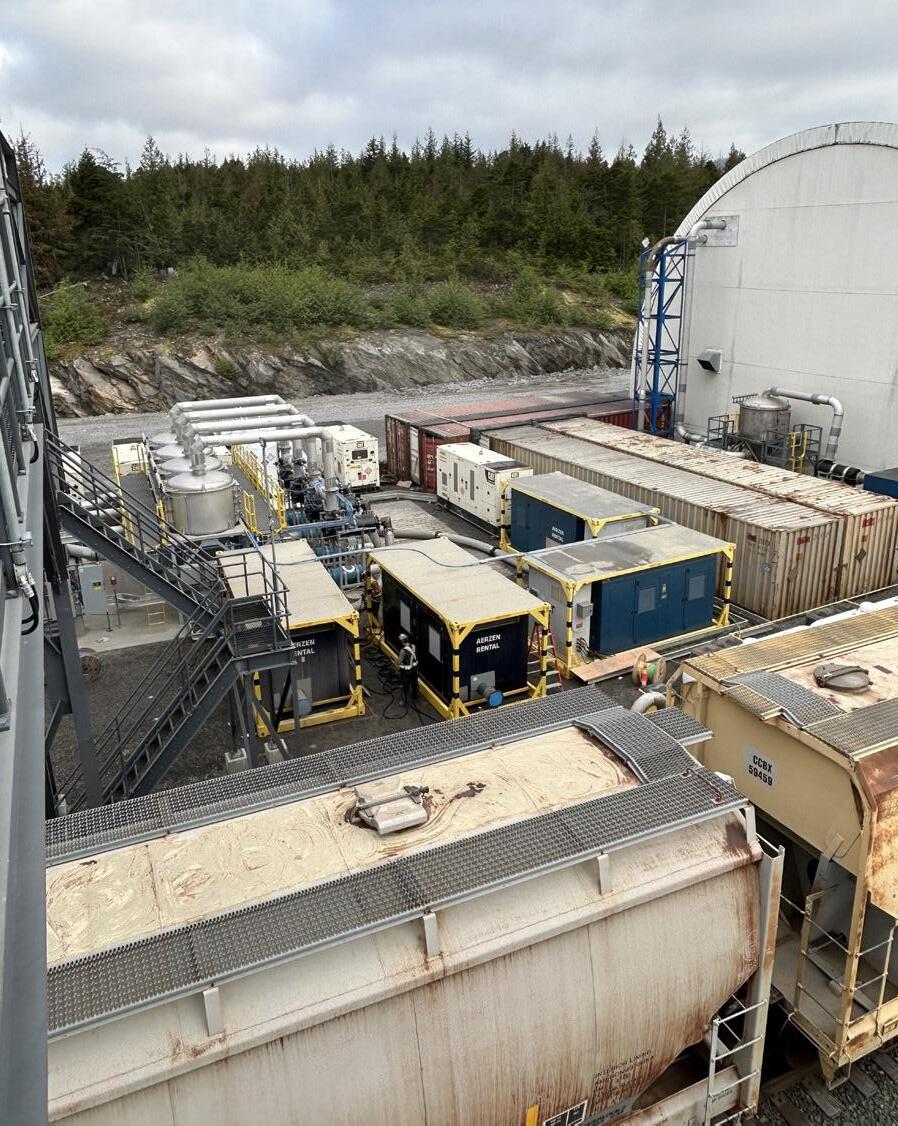
understand the plant’s operational needs and can offer reliable, rapid-response solutions.
f Fuel supply (if applicable): for diesel-driven solutions, secure a dependable fuel delivery partner and implement spill prevention and response protocols.
A gypsum plant experiencing frequent process blower stage mechanical failures developed a comprehensive contingency plan by:
Assessing process needs
The permanently installed blower delivered 71 m3/min. at 1000 mbar(g) pressure. Operators identified limited flexibility in reducing flow rates and noted a lack of pressure monitoring in the system, and so there was uncertainty as to whether any flexibility existed there.
Evaluating options
Faced with conflicting opinions on the root cause of failures, the plant avoided investing in a redundant blower stage. Instead, they secured a rental process blower capable of fully replacing the flow of the permanently installed process blower and providing up to 2000 mbar(g) discharge pressure (vs. 1000 mbar(g) on the permanently installed process blower), along with data logging features to monitor system conditions.
Implementing the plan
Preparations included identifying installation points, securing electrical connections, and setting up mechanical tie-ins for rapid deployment.

When another failure on the plant process blower occurred, the plant was able to resume production quickly by deploying the pre-identified rental process blower on an emergency basis.
Operating data from the rental unit confirmed that system pressures regularly exceeded the maximum allowable operating pressure of the permanently installed blower, likely contributing to the recurring stage failures. This insight enabled the plant to specify and procure a properly rated

























































































replacement blower while avoiding additional costly production interruptions. Without the contingency plan, the facility would have faced a prolonged shutdown or been forced to rely on diesel-driven compressors – an option five to six times more expensive than renting, with higher maintenance needs and performance challenges due to moisture carryover and unstable air quality. By partnering with low-pressure air specialists and planning ahead, the plant avoided costly interruptions and positioned itself for long-term operational reliability.
A cement plant faced prolonged disruptions following a process blower failure in a silo homogenisation process due to a lack of contingency planning.
Initial response
The plant resorted to renting a diesel-driven oil-flooded compressor without an air dryer, leading to high fuel costs, maintenance interruptions, and moisture carryover issues in the process.
Alternative solution
Upon discovering the availability of rental process blowers, the plant transitioned to a more suitable rental option, achieving operational stability and significant cost savings.
By switching from diesel compressors to an electric driven rental process blower, the plant saved approximately US$700 000 in rental and fuel expenditures and avoided further operational challenges during the replacement period.
About 6 months before a greenfield product packaging plant start-up in Canada was committed to becoming operational, it faced a daunting challenge from a customer to accelerate the start-up date by two months. 'Not possible' was not an answer the customer would accept.
Assessing process needs
A thorough analysis of how to accelerate the start-up was completed and two items were identified as controlling path. Municipal power for the entire facility would not yet be available and the process blowers that move the product from railcars to the packaging centre could not be further expedited. The specific process needs of each were easily known as this plant was a duplicate of others that have been recently commissioned across North America.
The power side was relatively easy as temporary power solutions providers are readily available in Canada.
The company learned of the existence of rental process blowers through their permanent installed blower supplier. The process blower needs were presented and a plan was developed by the rental provider to mobilise four rental process blowers to the project site for installation and commissioning using generator power.
A detailed plant layout was developed to determine where to place all of this rental equipment given that available real estate was tight.
The temporary system was installed and the entire plant commissioned to allow repackaging production to begin two months earlier than previously committed. The successful acceleration of the go-live date strengthened the relationship between the plant and their customer and the commissioning team is now armed with new experiences in accelerating commissioning that they can carry forward to future commissioning projects.
Proactive contingency planning for process blower outages is a strategic investment of effort that minimises downtime, reduces emergency costs, and safeguards production continuity.
By understanding process requirements, assessing all response options, and developing a detailed implementation plan, industrial plants can significantly improve their resilience against unforeseen process blower failures or unavailability. Facilities that take these preparatory steps are better positioned to maintain operational stability and protect their bottom line during unexpected process blower outages.
Matt Piedmonte serves as Vice President and General Manager of Aerzen Rental Solutions in the Americas, as well as Global Business Development Manager for Aerzen Rental Solutions in the Middle East. Matt is currently leading the greenfield startup of Aerzen Rental Solutions in Dammam, Saudi Arabia, supporting industrial plants across the GCC region in achieving continuous, reliable, and efficient operations through the implementation of engineered rental process blower solutions.
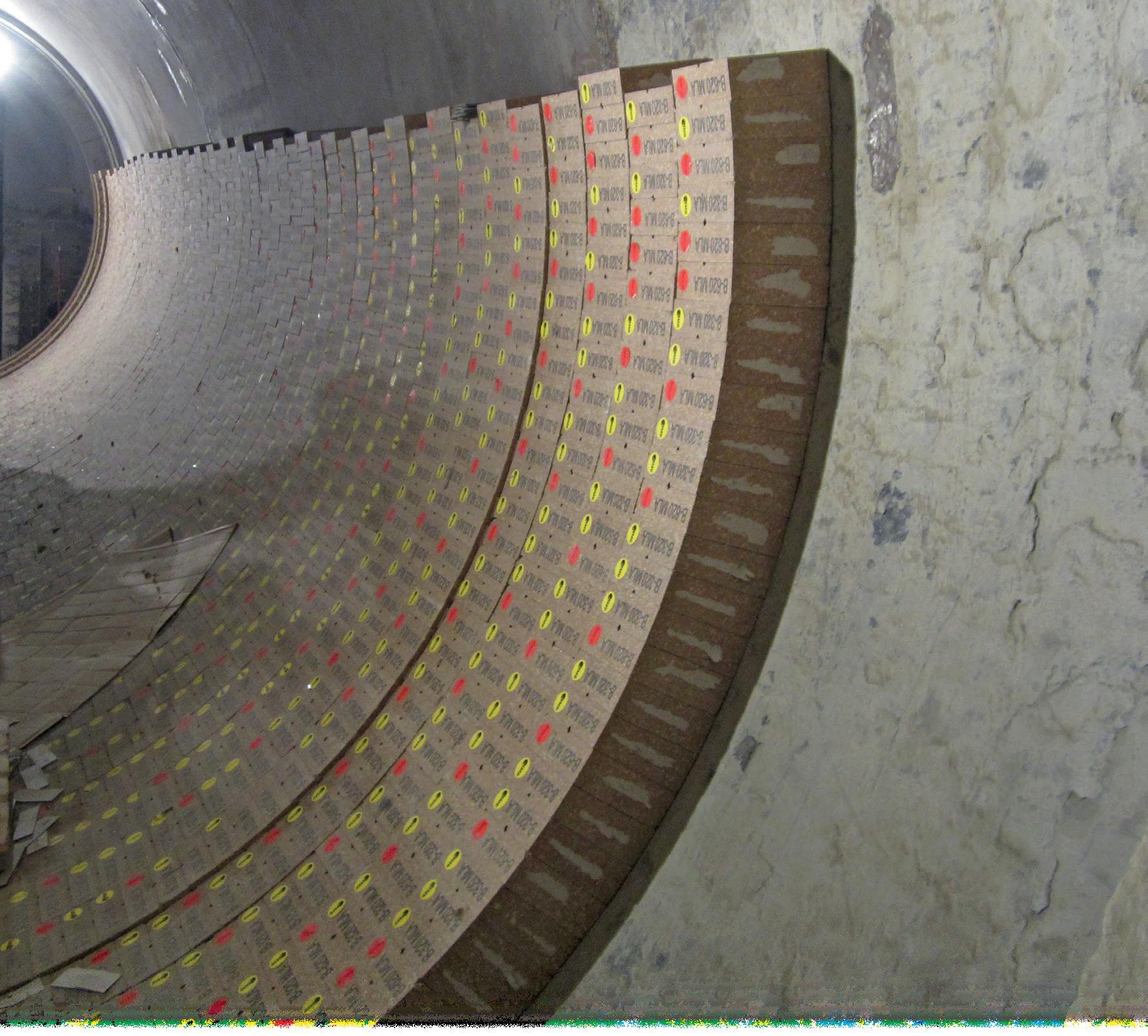


www.krosaki.amr.com www.refractaria.com The KROSAKI Group, through the Krosaki AMR Refractarios and Refractaria factories in Spain, supplies the most complete range of high quality refractory materials for the cement industry.










Jeremy Williams, Thermo Fisher Scientific, explains how advanced analytical techniques support the safe and sustainable use of alternative fuels.

s the global demand for urbanisation and infrastructure grows, the demand for cement – a main ingredient in concrete – will only grow with it. But unlike other sectors, more than half of the emissions in cement and concrete production are process related, offering plenty of room for improvement.
To reduce process emissions, one critical strategy cement plants are adopting is the use
of waste-derived alternative fuels (AFs) to replace fossil fuels, which cuts emissions significantly. AFs are being increasingly used in cement kilns to contribute to a more environmentally compliant manufacturing process. Analytical technology can help cement manufacturers ensure that they maintain consistent, safe, and high-quality cement while safely incorporating AFs or waste-derived materials.
The cement industry: energy challenges and solutions
To produce cement, CO2 is removed from limestone (CaCO3) and is turned into quicklime (CaO), which is the most important component of clinker, a stony residue produced by kilns. Clinker is later mixed with other materials to produce cement. Therefore, a large part of the CO2 production stems from the conversion of CaCO3 into CaO.
Additionally, the conversion of CaCO3 to CaO only happens at high temperatures. To reach temperatures high enough to cause the chemical reaction, the kiln is heated by burning pulverised coal, oil, or natural gas – adding to the total CO2 footprint. To maintain the temperature, combustibles are added to the material mix in the kiln. Fortunately, these combustibles, as well as burner fuel, can be partially replaced by AFs.
The three primary benefits for using AFs over fossil fuels include:
f Waste valorisation, which transforms waste into valuable energy resources, prevents landfill accumulation, and promotes circular economy principles.
f The natural resource conservation of coal, gas, and petroleum cake by substituting fossil fuels with AFs, limiting the exploitation of these natural resources.
f The high calorific potential of AFs help meet the energy needs of diverse industrial activities.
At the heart of cement plants’ decarbonisation action plans is the increasing use of AFs such as refuse derived fuel (RDF) and solid recovered fuel (SRF). The first, RDF, is derived from hazardous waste with high energy potential. This type of fuel is predominantly utilised by cement plants and serves as a sustainable substitute for traditional fossil fuels, significantly contributing to the reduction of carbon emissions. The second, SRF, is produced from non-recyclable, non-hazardous waste and possesses high energy potential. This fuel finds applications not only in cement factories but also in other industries seeking AF sources.
Both fuels – derived from a highly variable range of waste materials, including petroleum coke, paper waste, rubber residues, and used tires, among others – enable cement manufacturers to reduce their dependence on fossil fuels in favour of local AF supplies, minimising the carbon footprint associated with transportation.
When discussing RDF, it is also important to discuss why the cement industry is allowed to accept hazardous waste streams as AFs. Unlike conventional waste incinerators, which primarily focus on disposal, cement kilns used by the cement industry can repurpose the energy from burning hazardous materials directly into industrial production, transforming waste management into an efficient part of the manufacturing process. Using pre-existing infrastructure – the cement kilns – to burn these AFs as a fuel source is a win-win: the waste becomes productive for communities and manufacturers alike, as they do not need to waste resources to destroy or store it, and manufacturers save on the cost of expensive fossil fuels. However, due to the complex chemistry associated with the varying nature of these AFs, which include a variety of materials such as solid waste, liquid waste, and hazardous waste, they must be properly conditioned and validated to ensure their suitability for use in kilns while complying with regulatory emission standards.
However, hazardous waste poses its own unique challenges. The total load of hazardous elements, mainly harmful and toxic metals, cannot be too high in the kiln, as the clinker must meet certain specifications. Additionally, the waste contains sulfur and chlorine, which can turn into corrosive compounds that damage the kiln over time. Because of this, the sulfur and chlorine contents in the AF must remain below a certain level. As other industries using AFs do not work with high temperatures, and therefore cannot accept hazardous waste as fuel, EDXRF is used to ensure that these elements are completely absent from the final product.
To meet stringent specifications set by internal quality standards, industry standards, and regulatory requirements, cement manufacturers must leverage technology that ensures unwanted materials are absent from their final product. X-ray fluorescence (XRF) is one of the most suited techniques for the elemental analysis of these diverse materials to determine if they are qualified for incineration in cement kilns. Analysis of toxic or heavy elements – undesirable elements
solutions fast, flexible, reliable



Specializing in oil free compressors and blowers under 3.5 bar
Pneumatic conveying | Silo homogenization | Kiln combustion air




for cement quality control – can be achieved easily using XRF.
XRF provides precise elemental analysis, ensuring that AFs meet strict quality and regulatory standards. Having this capability is essential for maintaining the integrity and performance of industrial processes, particularly in sectors like cement manufacturing, where fuel quality directly impacts production efficiency and environmental compliance.
Specifically, for this application, energy dispersive XRF (EDXRF) is essential for the precise elemental analysis of diverse waste materials, helping ensure the suitability of AFs for use in various industrial applications, including cement kilns. EDXRF is a convenient technology to screen all kinds of materials for quick identification and quantification of elements with little or no sample preparation. Rapid elemental analysis of regular or irregular samples makes EDXRF an attractive front-end analysis tool.
EDXRF is designed to analyse groups of elements simultaneously. Instead of analysing one element at a time, this type of XRF instrumentation separates the characteristic X-rays of different elements into a complete fluorescence energy spectrum, which is then processed for qualitative or quantitative analysis. By detecting many elements at once, this technology is especially useful in cement production where the material composition of AFs is highly variable.
There are two main instrument designs used in EDXRF: direct excitation (2D optics) and indirect excitation (3D optics). The difference lies in the way X-rays are directed at the sample. For direct excitation, X-rays pass through filters before hitting the sample, and the detector measures the resulting samples. For indirect excitation, the X-rays hit a secondary target, eliminating primary radiation coming from the sample and producing clearer results.
Specifically, EDXRF enables cement manufacturers to maintain compliance with ASTM C114 standards, the most widely used standard test method used to evaluate the performance of XRF instruments for the analysis of cements. By measuring the elemental composition of the cement, manufacturers can detect and address potential contaminants from AFs, which can compromise the quality and safety of the cement. This technology ultimately enables cement manufacturers to safely and efficiently incorporate AFs while maintaining consistent, high-quality cement.
The role of X-ray fluorescence in alternative fuel development: a case study
The CHIMIREC Group, a leading entity in the management of hazardous and non-hazardous
waste in France and internationally, provides ecologically virtuous solutions to address pressing environmental challenges, with the cement manufacturing industry being one of its primary beneficiaries. Considering the stringent acceptance criteria set by cement manufacturers, CHIMIREC needed a reliable and efficient method to analyse materials to determine their suitability to support kiln operations.
A critical component of CHIMIREC's research and development efforts is the use of EDXRF. CHIMIREC mixes the previously discussed wastes to meet the requirements not only for calorific value but also sulfur and chlorine content, as well as other toxic and harmful elements (like cadmium, antimony, chromium, and mercury).
By detecting toxic or heavy elements and other undesirable components, EDXRF ensures that CHIMIREC's preparations meet strict acceptance criteria, such as specifications around density, water content, metals, and calorific power. This approach enhances the quality of the AFs produced and ensures compliance with regulatory emission norms.
The CHIMIREC Group leverages the Thermo Scientific™ ARL™ QUANT’X EDXRF Spectrometer for its elemental analysis of AFs, leaning heavily on the technology’s flexibility, ease-of-use, and rapid screening capabilities. Equipped with Thermo Scientific™ UniQuant™ Software, this instrument allows for the qualitative, quantitative, and fingerprinting analysis of diverse materials, including AFs without the need for reference calibrations or standards.
By leveraging EDXRF, CHIMIREC provides high-quality, sustainable energy solutions that align with the environmental goals of its industrial partners.
AFs are leading the way toward a greener and more efficient world, and with technologies like EDXRF at the helm, the future of industrial sustainability is bright. As industries across the globe continue to pursue carbon neutrality and sustainable practices, the importance of advanced technologies and innovative solutions becomes increasingly clear. The use of AFs is pivotal in reducing reliance on fossil fuels and minimising carbon emissions. In this context, XRF technology plays a crucial role in supporting the industry’s sustainability efforts.
AFs are leading the way toward a greener and more efficient world, and in the cement industry, the right analytical tools enable cement producers to confidently expand the use of AFs and waste-derived materials without compromising the quality, safety, or consistency of their final product. With technologies like EDXRF at the helm, the future of industrial sustainability is bright.

Joakim Jaeger, Climeon AB, explores how low-temperature organic Rankine cycle technology is unlocking new value from waste heat to enhance energy efficiency and decarbonisation.
s the binding agent in concrete, the world’s most-used manufactured material, cement is essential to global development and resilience in the face of climate change, but it is also one of the largest industrial emitters of CO2 globally. In response to the rising pressure to decarbonise, major producers such as Holcim Group, Heidelberg Materials, and Cemex
have committed to achieving net-zero by 2050, and initiatives like the Global Cement and Concrete Association’s (GCCA) roadmap has outlined a pathway for the sector’s decarbonisation, including an interim target to reduce CO2 emissions by 25% by 2030.
There is no simple solution for achieving the ambitious targets set out by one of the world’s most energy-intensive industries. Despite growing investment in carbon reduction strategies, the CO2 intensity of cement production has remained largely unchanged over the past five years, according to the IEA. Without sufficient supportive policy frameworks and stronger commitment from consumers to adopt environmentally driven procurement standards, cement producers are left with the challenge of urgently reaching the industry’s decarbonisation goals with few commercially viable options.
There is no silver bullet for solving the challenges facing the industry. Decarbonising cement will require a combination of
strategies, including alternative raw materials, advanced process controls, energy efficiency improvements, carbon capture technologies, among others.
According to the GCCA’s pathway to net zero, decarbonising electricity consumption can contribute approximately 5% to the cement industry’s overall decarbonisation pathway. Waste heat recovery (WHR) is one of the few levers available today that is commercially proven. However, many WHR systems still leave lower-temperature heat sources unutilised.
This article explores how modern low-temperature organic Rankine cycle (LT-ORC) systems can exploit thermal energy previously disregarded for the production of electricity to increase on-site electricity production and enhance ROI from existing or planned WHR projects.

In a typical modern dry-process cement kiln, nearly half of the thermal energy input is lost as waste heat. According to energy balance studies, about 23% of the heat is lost in the form of waste gases, 11% in the cooling process, and 10% by radiation through equipment surfaces. By installing a WHR system, cement plants can capture this lost energy and convert it to clean, reliable on-site power. These systems not only reduce the environmental impact but also offer clear operational and financial benefits, such as: f Greater control over energy costs. WHR reduces exposure
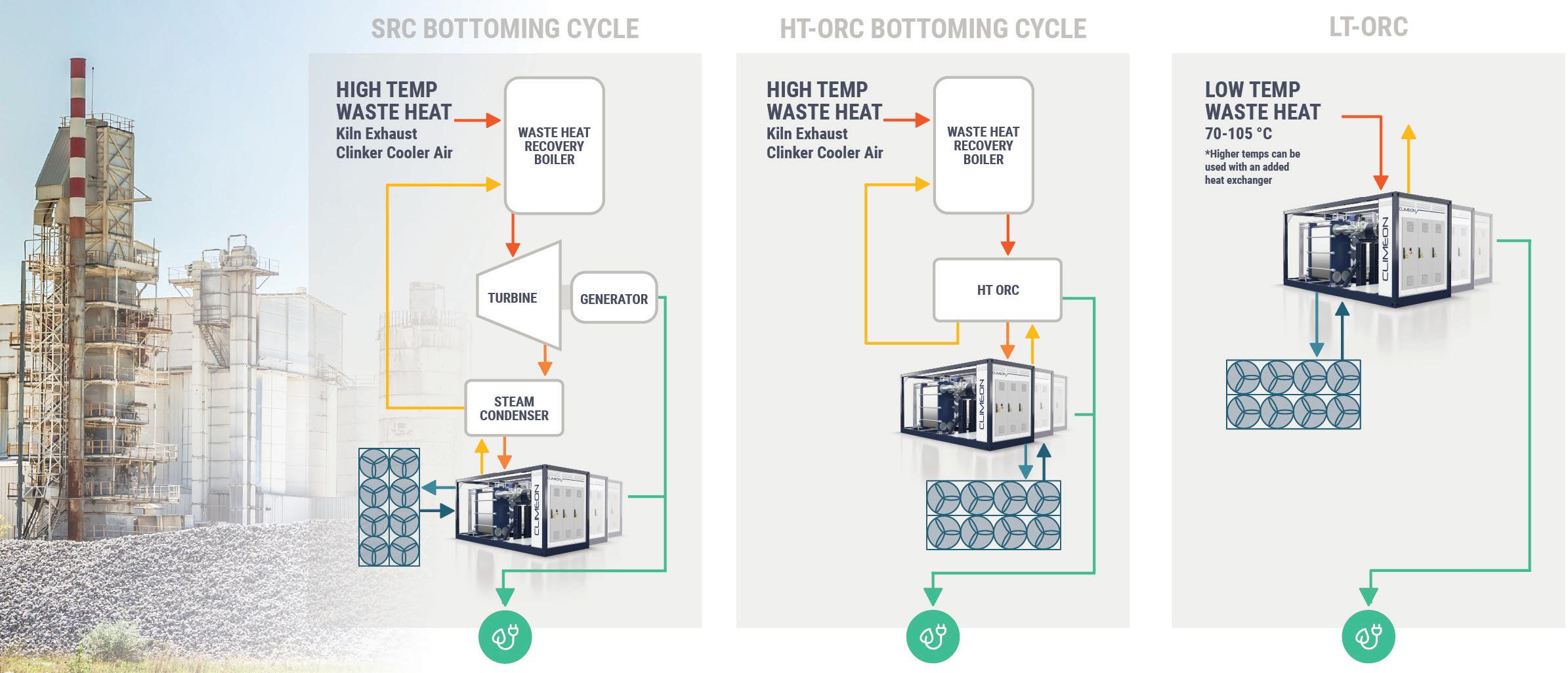


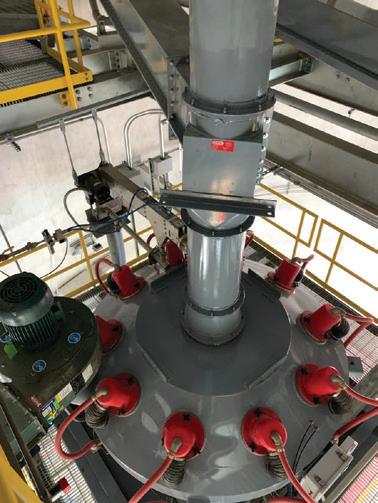


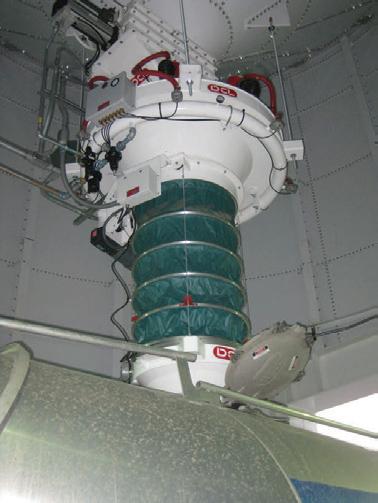






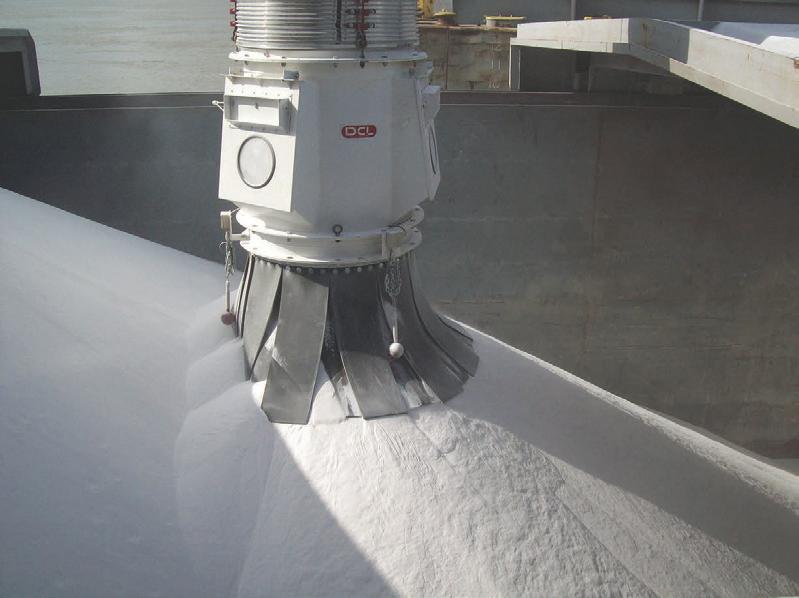

Since 1981, our team has assisted industries worldwide to achieve cleaner, greener, and more efficient loading operations. Our advanced dust control and bulk loading systems—spanning loading spouts, valves, conveyors, dust collectors, and full automation—are engineered to increase throughput while supporting your sustainability goals. Call 231.547.5600 to partner with us and optimize your loadout solutions.
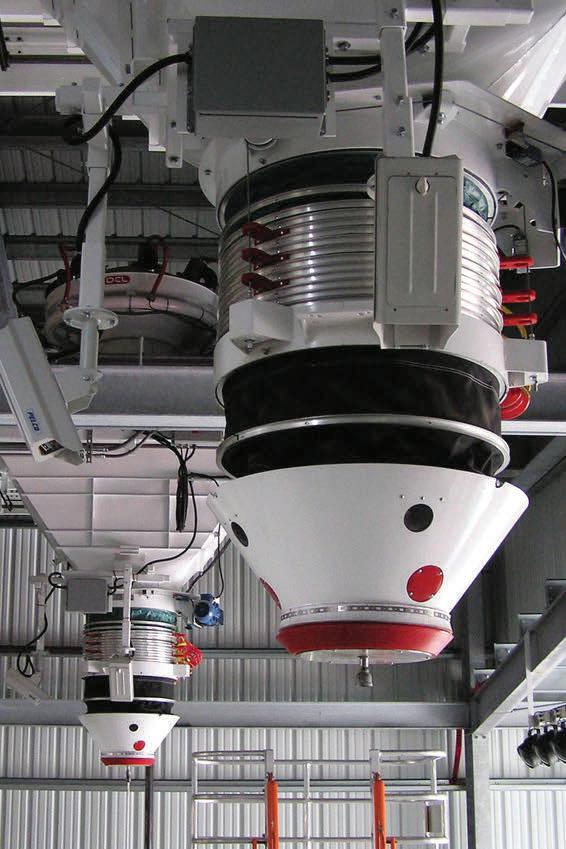



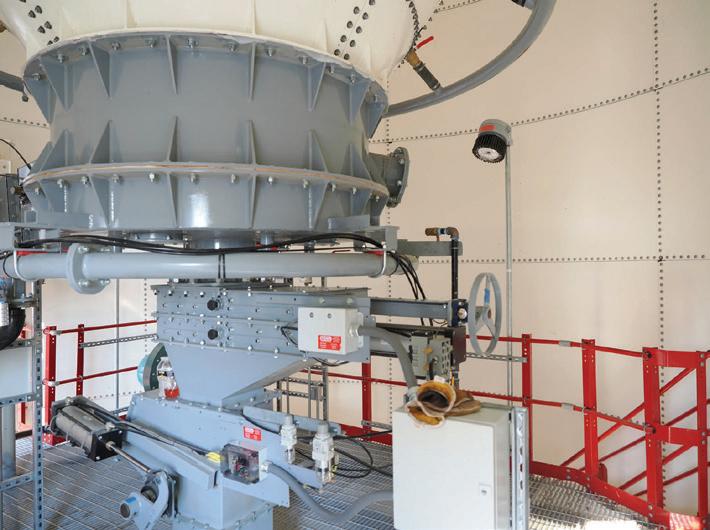

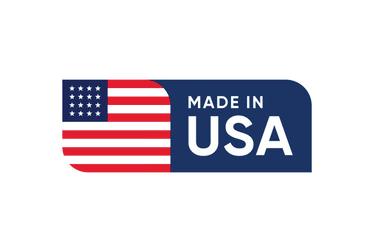
to volatile energy prices, peak demand-related expenses, and unreliable grid infrastructure.
f Improved operational efficiency. Capturing waste heat increases energy efficiency by converting thermal energy that would otherwise require cooling into sustainable baseload electricity.
f Stronger positioning for sustainability and investments. WHR helps industries achieve their sustainability goals, improves appeal for green financing, and builds resilience to future regulations.
According to a 2014 report by the IFC, approximately 25 – 45 kWh of electricity per tonne of clinker can be harnessed from waste heat at a typical cement plant, depending on efficiency and the design of the preheater system. This level of energy recovery can offset 20 – 30% of a plant’s total electricity demand, which can provide substantial cost-savings for cement producers.
Generally, WHR circuits in cement plants are applied to high-temperature waste heat sources, such as kiln exhaust gases and clinker cooler air. Steam Rankine cycles (SRC) or high-temperature ORC (HT-ORC) systems are the most applied and cost-efficient technologies for converting this high-temperature heat into electricity. Steam Rankine cycles use high-temperature exhaust gases to produce steam that drives a turbine connected to a generator to produce on-site power.
They are well-suited for large plants with stable, high-temperature waste heat, and can deliver significant electricity generation. However, their efficiency is limited to the portion of heat available at sufficiently high temperatures (>500˚C).
HT-ORC, like steam cycles, convert thermal energy into electricity using a turbine-generator setup. The key difference is that ORC systems use organic fluid with a lower boiling point than water, which allows them to operate at lower temperatures and pressures than steam turbines. HT-ORCs are generally designed for heat sources above 150˚C and can offer simplified operation and reduced maintenance demands compared to steam-based systems.
The financial viability of WHR systems in cement plants is closely tied to how much power they generate. Higher-output systems offset a larger
portion of a plant’s electricity demand and in turn recover capital investment more quickly.
Traditional WHR project expenditures have been estimated to range from around US$7000/kW installed for small-scale ORC systems to US$2000/kW for larger steam turbine systems, the cost per unit of electricity produced declines as the electrical output of the system increases. For this reason, maximising total energy recovery is essential to improving the return on investment (ROI).
One effective way to boost the power output of an existing WHR system is to add a secondary technology to capture low-temperature heat. After high temperature heat sources have been exploited, many cement WHR systems contain residual low-grade heat which SRC or HT-ORC systems are unable to utilise for power generation. By putting this otherwise discarded energy into use, cost-effective low-temperature heat-to-power technologies can increase electricity output and strengthen the ROI from the overall WHR installation.
Low-temperature organic Rankine cycle systems (LT-ORC) make it possible to efficiently utilise this resource. They operate similarly to an HT-ORC but are designed to generate electricity from heat sources in the 70 – 150˚C range. Unlike HT-ORCs, which typically operate with heat sources in the 200 – 350˚C range, low-temperature systems are designed to use working fluids with lower boiling points, enabling efficient operation at lower temperatures. While LT-ORCs produce less power than high-temperature systems, due to the lower energy content of the heat source, with efficiencies typically in the range of 6 – 10%, their advantage lies in capturing this abundant energy source that would otherwise be wasted.
Historically, low-temperature heat streams have been considered uneconomical for power generation. On its own, the high capital expenditure of installing a heat recovery circuit has outweighed the electricity production of smaller ORC systems, unless supported by strong policy incentives and supportive financing. However, with advances in efficiency at low temperatures, cost-efficient modular design, and growing incentives to decarbonise, modern LT-ORC systems have become a practical and financially attractive solution.
This solution can be particularly beneficial in situations such as:
f When residual heat at a temperature less than 150˚C is available after higher temperature heat has been recovered,
Ship unloaders

Storage & reclaim
Convey units
Truck loading
Ship loaders
LT-ORCs can be added as a bottoming cycle. For example, if the steam condenser is cooled at atmospheric pressure, an LT-ORC can be installed to recover energy from the low-temperature stream before it is cooled and discharged (Figure 2).
f Where low temperature heat is available in other areas of the process, such as heat radiation from equipment surfaces, or where exhaust gas temperatures are too low for high temperature heat recovery.
f At plants where operational resources and/or space constraints make the installation of a HT-WHR system challenging.
Climeon has developed a modular LT-ORC-based system called HeatPower.
Designed to operate efficiently with heat sources in the 70 – 105˚C range, each unit can generate up to 355 kW of electricity. In cases where there is a large, continuous flow of thermal energy, multiple units can be deployed in parallel to maximise energy recovery and increase total power output.
As cement manufacturers seek to increase the value and lower the payback time of WHR systems, Climeon’s approach offers several advantages:
f Standardised, plug-and-play design for quick deployment and high cost-efficiency compared to custom-built systems.
f Small footprint makes the system ideal for space-constrained sites and enables placement near the heat source, helping reduce installation complexity and material costs.
f Autonomous operation adapts to available heat load without the need for manual oversight.
f Low pressure and operating temperatures make the systems safer and lower maintenance requirements.
f Modular scalability allows for increasing capacity as needed, or where additional heat sources become available.
Low-temperature waste heat is abundantly available, not only at manufacturing sites, but also during the transportation of cement. Climeon’s LT-ORC system is currently planned for installation on two new NovaAlgoma cement carriers, where it will use waste heat from the vessel’s engines to produce power and reduce fuel consumption. This application highlights the technology’s flexibility and its potential to enhance energy efficiency throughout the cement value chain.
While there is no one-size-fits-all solution for the decarbonisation of cement, it is widely understood that more needs to be done to achieve the industry's targets.
The industry is faced with a lack of readily available and economically sustainable solutions, but WHR is a proven strategy for lowering energy costs and meeting increasingly stringent environmental regulations, and it can be deployed today.
Although most WHR systems are focused on high temperature sources, LT-ORCs can further increase clean energy production by utilising an abundant resource that otherwise would go unused.
In doing so, LT-ORCs help cement plants improve energy efficiency where other custom solutions may not be feasible due to budgetary limitations or temperature constraints, and they expand the potential impact of WHR in the cement industry’s pathway to decarbonisation.
1. Global Cement and Concrete Association (GCCA). Cement Industry Net Zero Progress Report. London: GCCA, November 2024.
2. International Energy Agency (IEA). Cement Industry Overview – https://www.iea.org/energysystem/industry/cement
3. FIERRO, J. J., ESCUDERO-ATEHORTUA, A., NIETO-LONDOÑO, C., GIRALDO, M., JOUHARA, H., & WROBEL, L. C., 'Evaluation of waste heat recovery technologies for the cement industry', International Journal of Thermofluids, Volumes 7 – 8, 2020,100040, ISSN 2666-2027 –https://doi.org/10.1016/j.ijft.2020.100040 (https:// www.sciencedirect.com/science/article/pii/ S2666202720300276)
4. International Finance Corporation (IFC). Waste Heat Recovery for the Cement Sector: Market and Supplier Analysis. June 2014, p.17.
5. International Finance Corporation (IFC). Waste Heat Recovery for the Cement Sector: Market and Supplier Analysis. June 2014, p.19.
6. Climeon - 'Climeon Receives Repeat Order from NovaAlgoma Cement Carriers' June 11, 2025 – https://climeon.com/press-releases/climeonreceives-repeat-order-from-novaalgoma-cementcarriers/
Joakim Jaeger is Key Account Manager at Climeon AB. Joakim holds degrees in mechanical and sustainable energy engineering from the Royal Institute of Technology in Stockholm and has previous experience with energy technology companies such as Orcan Energy in Munich.
Sinoma EC explains how applying a cooler exhaust gas closed loop system can significantly improve waste heat power generation efficiency in cement kilns while reducing emissions and enhancing clinker line performance.

linker cooling and waste gas treatment at the kiln head are crucial sections of the new dry-process cement clinker firing system, serving four main functions:
f Cooling the cement clinker to endow it with desirable cementitious properties and other performance characteristics.
f Transporting the cement clinker, delivering the cooled clinker to subsequent storage or processing stages.
f Heat recovery, reclaiming the sensible heat from the discharged clinker and utilising it to preheat or dry materials in equipment such as the rotary kiln, precalciner, and coal mill.
f Waste gas treatment, purifying the exhaust gases before releasing them into the atmosphere.
Utilising cooler exhaust gas to increase waste heat power generation
This article presents a theoretical analysis and technical introduction to the implementation of a closed-loop cooler exhaust gas system aimed at increasing the efficiency of waste heat power generation.
The focus is placed on a grate cooler system equipped with a coal mill positioned at the kiln head, serving as the primary research object (Figure 1).
Heat inputs into the grate cooler
f Sensible heat of clinker from the kiln (Qysh).
f Sensible heat of gases entering the cooler (QLk).
Heat outputs from the grate cooler
f Sensible heat of clinker exiting the cooler (QLsh).
f Sensible heat of secondary air entering the kiln (Qy2k).
f Sensible heat of tertiary air entering the precalciner (QF3k).
f Sensible heat of gases extracted from the cooler for the coal mill (Qmmk).
f Sensible heat of excess air discharged from the cooler (QPk).
f Sensible heat of gases extracted from the cooler for kiln head waste heat utilisation (Qytk).
f Sensible heat of fly ash in exhaust gases from the cooler (QLfk).
f Heat dissipation from the cooler surface (QLB).
f Other heat losses from the cooler (QLqt).
Energy balance equation
Based on the principles of energy conservation, the heat balance for the grate cooler is expressed as:
Qysh + QLk = QLsh + Qy2k + QF3k + Qmmk + QPk + Qytk + QLfk + QLB + QLqt
Thus, Qytk = Qysh + QLk - (QLsh + Qy2k + QF3k + Qmmk + QPk + QLfk + QLB + QLqt)
In a closed-loop configuration, the cooler exhaust gas – after purification by the dust collector – is redirected into the cooling air system of the grate cooler.
This reintroduction allows the purified gas to serve as part of the cooling air for the clinker, effectively increasing the cooling air flow rate (QLk).
From the heat balance equation above, it is evident that, assuming all other heat transfer components remain constant, an increase in QLk results in a corresponding increase in Qytk – the thermal energy available to the air quenching cooler (AQC) boiler.


The heat entering the kiln head waste heat boiler is given by: Qi = Qytk = q·Ci·Ti The effective heat utilised by the AQC boiler is calculated from the waste gas side (ignoring air leakage from the boiler itself), Qn = Qi - Qo = q·(Ci·Ti - Co·To). Where:
f Qi – Heat of waste gas at the inlet of AQC boiler, kJ.
f Qo – Heat of waste gas at the outlet of the boiler, kJ.
f q – Waste gas volume at the inlet of the boiler, Nm³/h.
f Ci – Specific heat of waste gas at the inlet of the boiler (including dust specific heat), kJ/Nm³ ˚C.
f Ti – Temperature of waste gas at the inlet of the boiler, ˚C.
f Co – Specific heat of waste gas at the outlet of the boiler (including dust specific heat), kJ/Nm3 ˚C.
f To – Temperature of waste gas at the outlet of the boiler, ˚C.
According to the heat balance calculation of the middle part of the grate cooler, when Qytk increases, the Qi and Ti at the boiler inlet also increase. Thus, when the designed outlet temperature of the AQC boiler is constant, that is, Co·To is constant, Qn increases.



It can be seen from this analysis that after setting the cooler exhaust gas closed loop system, the flow rate and temperature of the waste gas entering the AQC boiler increase.
Thus, the AQC boiler can produce more superheated steam with higher temperature, improve the working efficiency of the steam turbine and the Rankine cycle efficiency, thereby increasing power generation.
At present, the air supply volume for the kiln head grate cooler is generally around 2.0 Nm³/kg.cl. After implementing 100% exhaust gas recirculation, the air supply volume of the flue gas at the inlet of the waste heat boiler is generally 1.1 Nm³/kg.cl (i.e., 1.1 Nm³ of exhaust gas per kg of clinker).
Given conditions:
f Ambient temperature: 25˚C (specific heat capacity: 1.2973 kJ/Nm³ ˚C).
f Recirculating air temperature: 100˚C composite specific heat capacity after considering clinker heat contribution: 1.3301 kJ/Nm³ ˚C).
After adopting 100% hot air recirculation, the theoretical increase in heat input per kg of clinker at the waste heat boiler inlet is calculated as follows:
QZ = 1.1 × (100 × 1.3301 - 25 × 1.2973) = 110.64 kJ/kg.cl
The cycle efficiency of the waste heat power station is about 21% (including boiler heat exchange efficiency, heat dissipation loss, etc.), and the theoretically increased power generation per t of clinker is:
PZ = 110.64/3600*0.21*1000 = 6.45 kWh/t.cl
A 5000 tpd new dry-process cement clinker production line in a cement plant has an actual clinker output of ~5700 tpd. The kiln head grate cooler is equipped with 10 air chambers (numbered #1 – #10), and 10 cooling fans (#1 – #10) are configured accordingly.
A 100% recirculating air system is designed and installed in the existing kiln head cooling and exhaust gas treatment system; that is, all exhaust gas discharged into the chimney is redirected into the grate cooler cooling air system. Due to the structural limitation of the grate cooler, in order to meet the needs of clinker quenching to ensure clinker quality, #1 and #2 air chambers are used as quenching sections without a recirculating air system. At the same time, in order to ensure the final cooling temperature of clinker, the #10 air chamber is not equipped with a
air system. All exhaust gas at the outlet of the first row fan is introduced into #3 to #9 air chambers to form a closed loop system with 100%
Wen Peng & Chen Xiangyou, Henan SRON Silo Engineering Co., Ltd., present the advantages of silo pump pneumatic systems for cleaner, smarter, and more reliable powder material handling.

n modern cement production, the storage and handling of powdered and granular materials have a direct impact on production efficiency and operational stability. Traditional mechanical conveying methods, often subject to blockage, severe wear, excessive dust generation, and high energy consumption, have become a major bottleneck to achieving continuous operation and cleaner, more sustainable production. Leveraging their efficiency, sealed design, intelligence, and reliability, silo pump pneumatic conveying systems have revolutionised the storage and handling of powdered materials, becoming an indispensable solution for silo loading and unloading.
Flexible adaptation to dense-phase and dilute-phase conveying
Silo pump pneumatic conveying systems can be configured for either dense-phase or dilute-phase conveying, depending on material characteristics such as particle size, moisture, and viscosity. This enables stable, low-velocity, high-concentration conveying while effectively minimising pipeline wear and particle degradation.

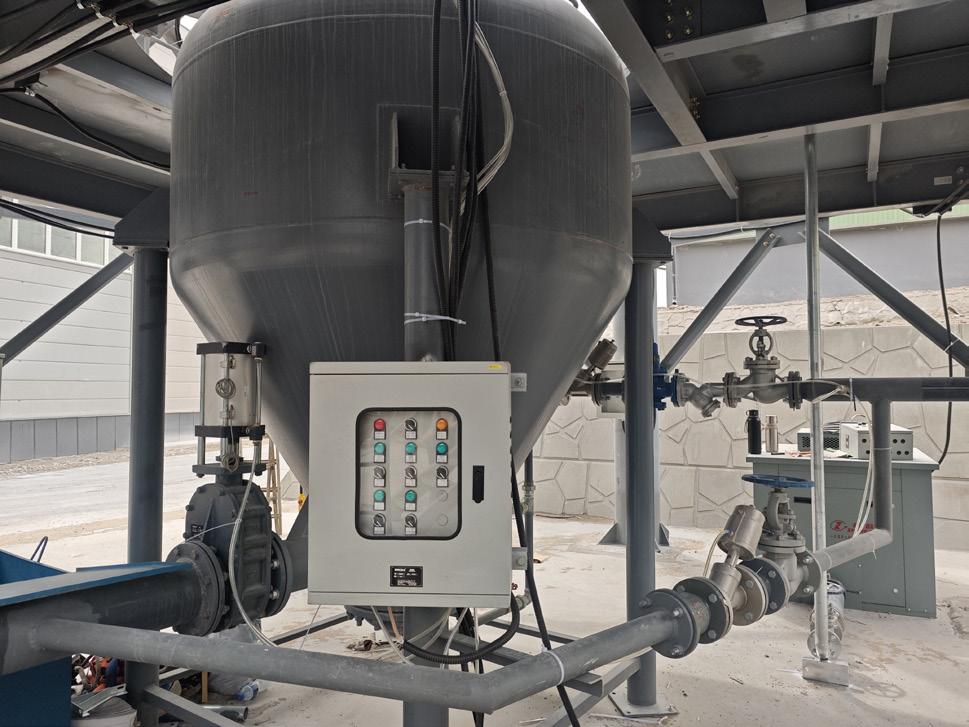
system.
These systems boast long conveying distances and significant elevation capacity, with a single system capable of horizontal distances of up to a kilometre and lifting heights exceeding 100 metres, easily accommodating complex process layouts.
Fully automatic operation and precise control
A PLC control system provides one-touch start/stop, real-time operating status monitoring, fault self-diagnosis, and safety interlocks.
It automatically adjusts the delivery rate according to silo position and pressure signals, allowing unmanned operation and greatly enhancing system response accuracy and stability.
No mechanical moving parts for exceptional reliability
The main body of the silo pump contains no rotating components and relies solely on compressed air to fluidise and convey materials. This design results in an exceptionally low failure rate and greatly prolongs equipment service life.
Economic benefits: lower costs, faster returns
Reduced operating costs
Unit energy consumption is lower than that of mechanical conveying methods, with clear advantages over medium- and long-distance conveying. The system features low maintenance costs and extended spare parts replacement cycles.
Enhanced operational continuity
The silo pump system offers fully automatic continuous conveying, reduces downtime from blockage removal and maintenance, and ensures smooth material flow.
Minimising material loss and contamination
Closed conveying prevents dust emission, ensures minimal material loss, and prevents moisture and cross-contamination. It is especially suitable for industries with stringent standards such as food, pharmaceuticals, and fine chemicals.
Safety and environmental protection: fully enclosed and environmentally reliable
Zero operational risk
Fine powder (cement, fly ash)
and construction materials storage Dense phase conveying + wear-resistant pipe
Lightweight particles (microplastics) Chemical and plastic ingredients Low-pressure dilute-phase conveying + cyclone separation
Food-grade materials (flour, sugar)
Food and grain silos
Food-grade stainless steel pipe + fully enclosed design
The fully enclosed pipeline system completely eliminates manual contact with dust, protecting operator health. The system also offers an explosion-proof option suitable for use in flammable and explosive dust environments.
Dust-free, pollution-free, and low-noise
Compared with open conveying methods such as bucket elevators, scraper conveyors, and belt












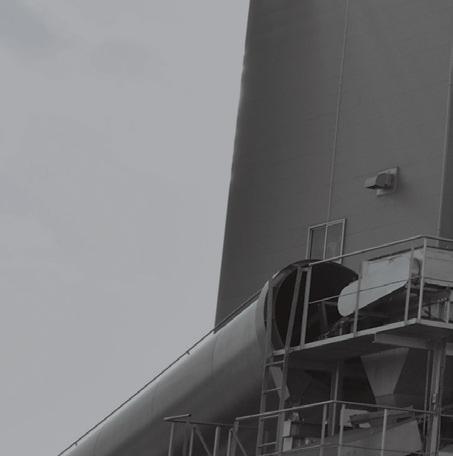

























conveyors, pneumatic conveying is dust-free and spill-free, ensuring cleanliness and environmental friendliness, and compliance with national environmental protection and ‘dual carbon’ policies.
Broad adaptability and performance under extreme conditions
Applicable to multiple industries and materials
Pneumatic conveying systems offer broad adaptability across diverse industries and material types (Table 1).
Reliable performance under extreme conditions reliable performance


For harsh environments involving high temperatures, corrosion, or abrasion, materials such as stainless steel, ceramic linings, and wear-resistant alloys can be used to ensure system reliability is maintained. The anti-arching and anti-blockage design – especially when combined with fluidisers or air cannons –effectively handles materials prone to bridging.
Intelligence and integration: The core engine of future logistics
IoT + cloud platform monitoring
Remote operation and maintenance, along with big data analytics, can be deployed. This provides real-time visibility into conveying efficiency, energy consumption, and equipment health, paving the way for predictive maintenance and smarter decision-making.
Strong system integration capabilities
Robust integration with MES and ERP platforms are also possible, enabling digitalised material flow management and delivering critical logistics support for smart factories and intelligent warehousing.
Summary: pneumatic conveying via silo pumps – the lifeline of modern powder storage and handling
f Technical aspect: it offers efficient, flexible, and reliable conveying performance, adaptable to diverse and challenging operating conditions.
f Economic aspect: significantly lowers operation and maintenance costs while enhancing overall system efficiency.
f Environmental protection and safety: ensures fully enclosed, dust-free operation that meets stringent standards.
f Development perspective: as a core component of automated and intelligent bulk material handling systems, it empowers enterprises to accelerate digital transformation and upgrading.
Choosing silo pump pneumatic conveying is choosing an efficient, clean, and reliable logistics solution for the future.
Frank Ormeloh, HAVER & BOECKER, explores how packing equipment advancements are boosting efficiency and sustainability.
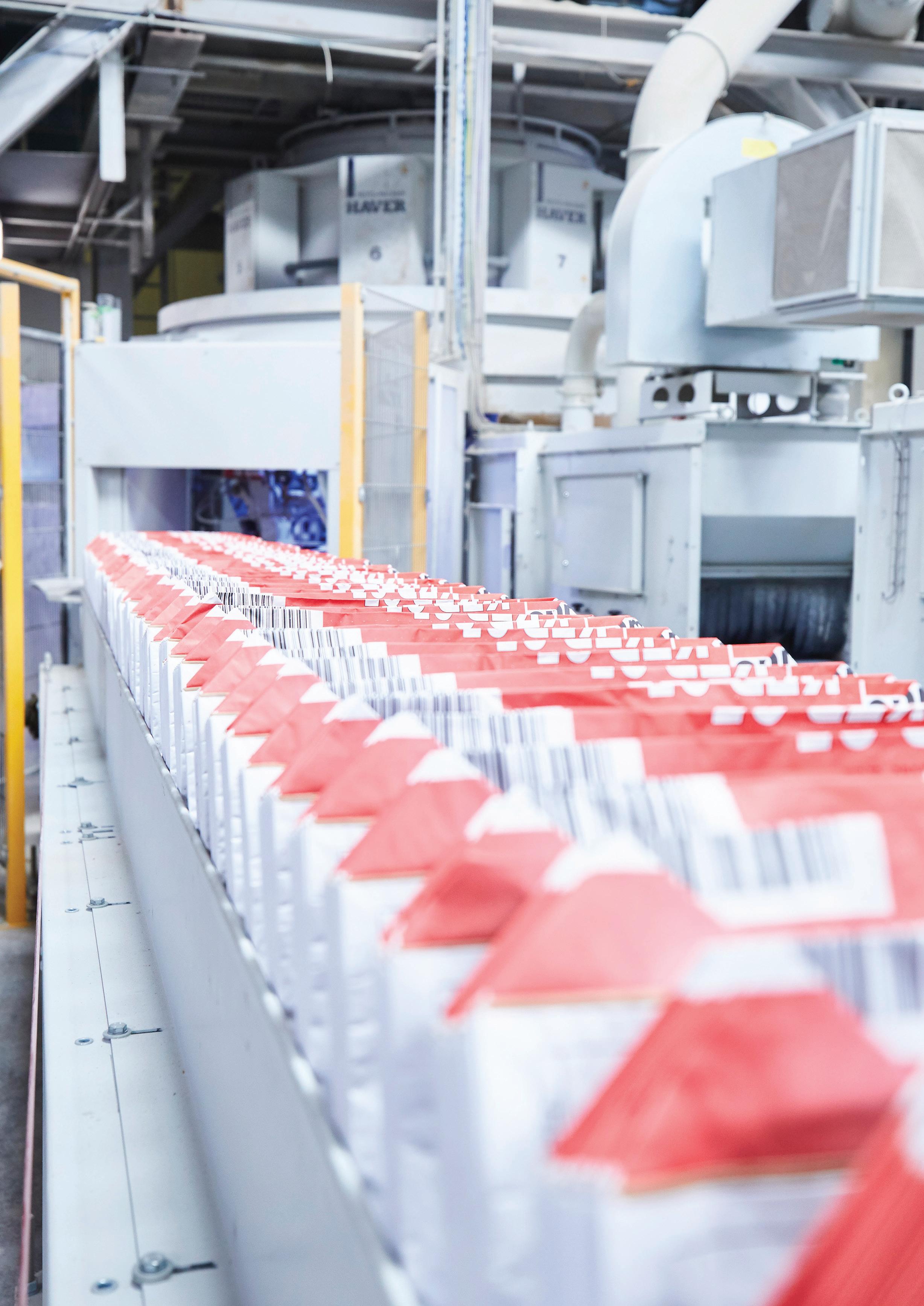
hen people hear the word ‘sustainability’, many jump to a definition that focuses solely on environmental impacts. However, in the truest sense of the word, sustainability encompasses three factors – social, economic and, of course, environmental.
As with all businesses, cement plants have been drawn into the sustainability conversation. As pressure mounts to save resources and reduce carbon footprints and energy consumption, cement plants are developing smart and efficient practices to meet strict environmental standards. To reach sustainability objectives, facilities need to scrutinise the entire plant to identify the most effective solutions. Yet many operations overlook packing and loading lines, writing them off as insignificant to sustainability. However, plants
can reduce resource consumption and improve product protection by optimising every system, and that includes the packing process.
Some key areas to focus on while optimising a plant for sustainability include choosing the right equipment and components that can be customised to the plant, as well as considering machine designs that allow for upgrades and enhancements.
These options increase the longevity of the packing line while improving filling accuracy and reducing lost product.

ROTO-PACKER Plants can reduce energy consumption by optimising every system, and that includes the packing process.

ROTO-LOCK. A fully enclosed, metal shaft-sealed system featuring a rubber interface between the gates makes the process at least 70% cleaner and up to 8% faster compared to traditional slide gate systems.
Many producers believe dust is an inevitable byproduct of cement production. This is a myth. It is true that packing powdered material, for example, requires the addition of air to move the material, inevitably creating dust. However, dust suppression technology available today can offer nearly dust-free working conditions. By reducing dust, minimising product loss, and promoting the careful use of resources, the employee, the environment, and the bottom line all benefit. Maintaining cleanliness also enhances employee health and provides a safer working environment. Reducing dust is just one way to enhance sustainability in a packing plant, though. Adjustments at nearly every stage of the filling process – from feeding and dosing to packing and loading – can have a positive impact.
The first step in the packing process is when material is fed into the packer silo. The material is then moved through a rotary feeder and a dosing system. In this initial step, many machines feature a slide gate dosing unit, which leaves a gap of several millimetres where dust and spillage can escape. To reduce dust production and protect against spillage, operations should consider a fully enclosed, metal shaft-sealed system featuring a rubber interface between the gates. This simple changeout makes the process at least 70% cleaner and up to 8% faster compared to traditional slide gate systems. The only dust and spillage that can escape using this system comes from the way the filling spout and the bag valve interact – a challenge that some manufacturers are prepared to address with services such as updated bag sealing technology.
Advanced sealing technology goes a long way in addressing material loss during bag filling and sealing. Standard rigid filling spouts require the unsealed valve bag to adhere to the tube, leaving room for product to escape. Once packed, unsealed valve bags rely on the inner pressure of the bag to close, which results in the bag being only 70% closed and leaves a 30% opening for spillage.
To solve this challenge, premium manufacturers offer specialised inflatable filling tubes that hermetically seals the gap between the bag and the filling spout during the filling process. This translates to no dust escaping through the valve and, when filling is complete, the bag is removed from the spout, and the valve is welded shut by an ultrasonic sealing unit. This creates a cleaner working environment with less product loss, reduced cleanup and energy consumption, and better weight accuracy. During palletising,
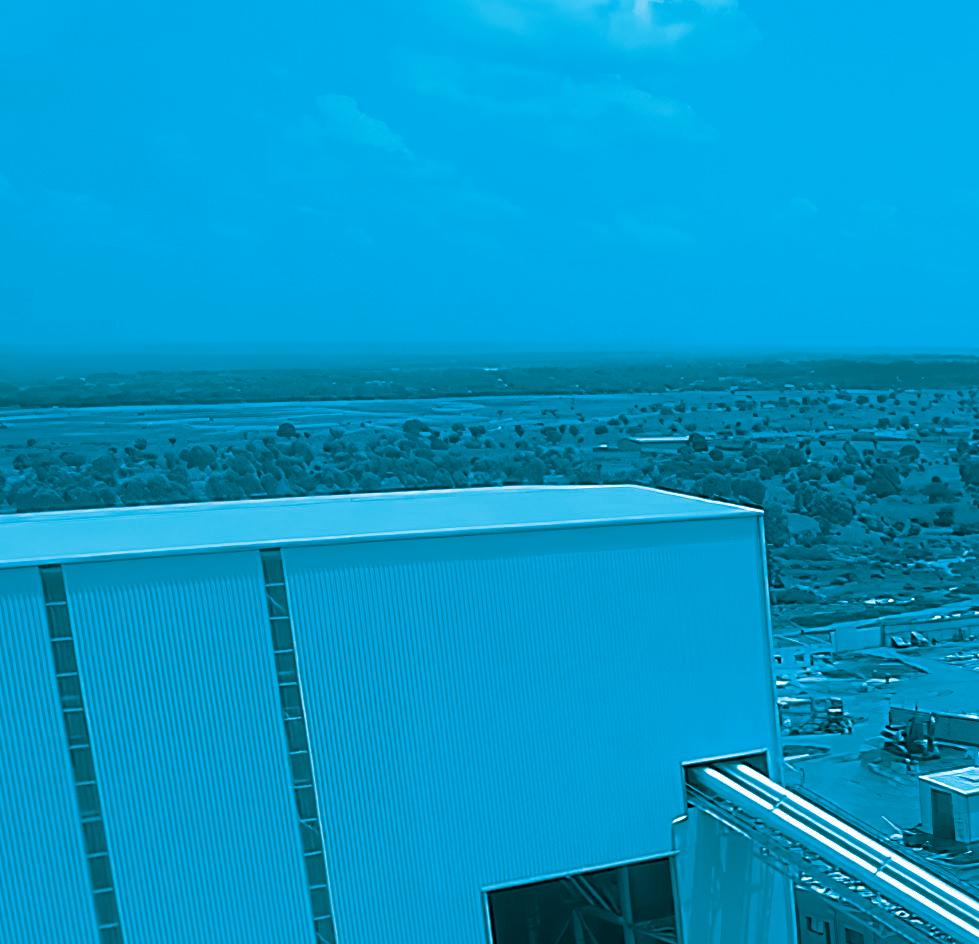


From individual components to upgrades to complete plants, InterCem provides customized solutions for operators and investors of cement plants all over the world. InterCem is therefore also the right partner for you when it comes to planning, detailed engineering, project management of greenfield projects and conversion/modernization of production plants. Contact us: The InterCem professionals will also find the right solution for your requirements.

BULK MATERIALS
STORAGE & HANDLING
SOLUTIONS
MARINE TERMINALS
ECO-HOPPERS

TURNKEY INSTALLATIONS

SCAN THE QR-CODE AND VISIT OUR WEBSITE TO FIND OUT MORE





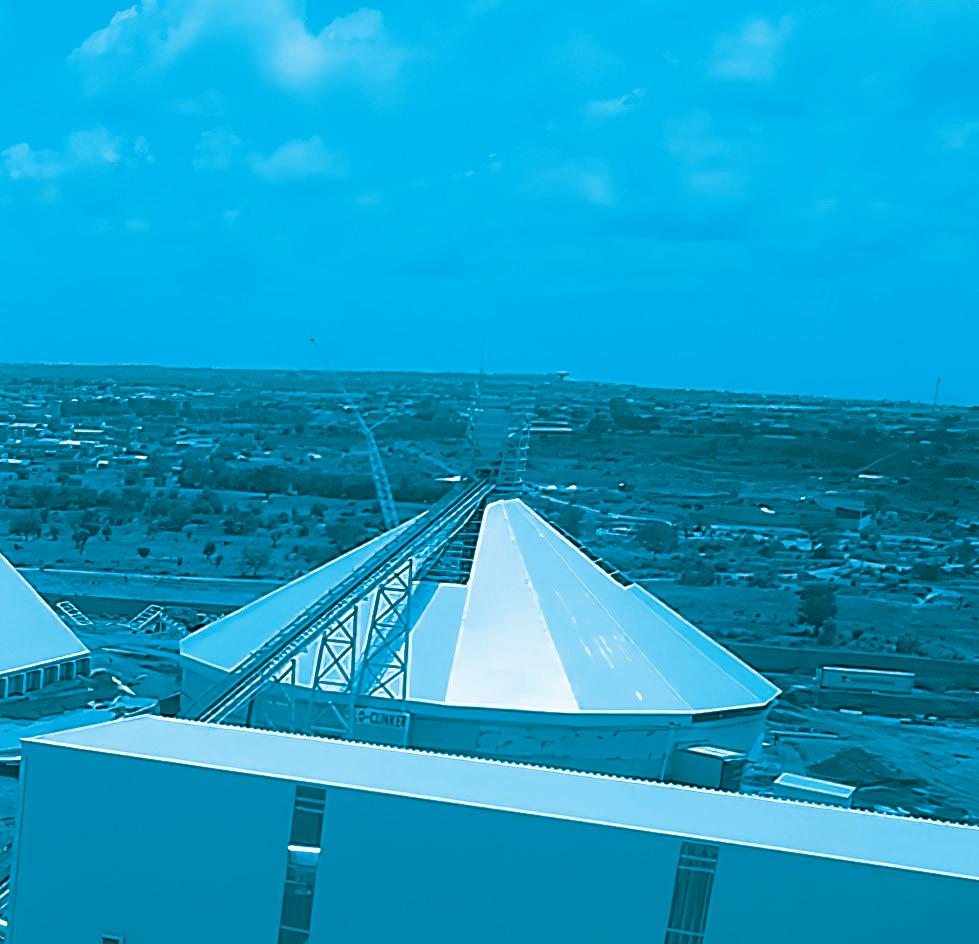



transportation, and storage, these completely sealed bags can make producers stand out with custom designs and a clean packing solution.

SEAL technology. Specialised inflatable filling spouts seal the bag to the spout throughout the filling process. This translates to no dust escaping through the valve and, when filling is complete, the bag is removed from the spout, and the valve is welded shut by an ultrasonic sealing unit.

Tubular film is fed into a packing machine where it is cut and sealed with ultrasonic technology, ensuring it is 100% closed. This sealing method creates a permanent, tamper-resistant closure that holds up reliably during transport and storage.
Another factor that should be considered for reducing product loss is the type of bag and its compatibility with the packing equipment. Specialised manufacturers analyse the material being packed and the bags used before making recommendations. These customised recommendations increase the harmony between the bags, packing machines, and product. For example, tubular film bags are a completely sealed, weatherproof, and leakproof solution for a wide range of industries, spanning from cement to building and chemical products. Tubular film is fed into a packing machine where it is cut and sealed, ensuring it is 100% closed. This sealing method creates a permanent, tamper-resistant closure that holds up reliably during transport and storage – a key advantage over other methods that may weaken under shifting conditions. These tubular film bags are also completely emptiable, eliminating product loss for the consumer. Plus, they are recyclable, providing an additional sustainability benefit.
If making the switch to a form-fill-seal (FFS) or tubular film machine, consider the manufacturer and the machine itself. Some FFS machines use vacuum methods to compact material as it is filled into the bag. On the other hand, some machines are equipped with vibration technology to accomplish this task, which is much more effective and allows for the same amount of product to be packed into a smaller bag, meaning less film used per bag. Over time, this translates to significant environmental and economic advantages. The fully sealed bags remain clean and uniform, which can draw in more customers. The weatherproof qualities of these bags make handling and storage easier.
Once equipment and bag material choices have been made, it is time to look at automation, which helps significantly impact efficiency and sustainability. A fully automated packing line allows for more flexible line layouts and negates the inefficiencies caused by human error or manual limitations. Though both may seem like small matters, the effects add up over time. Automation also allows skilled labour to focus on higher-value tasks, improving overall workforce utilisation.
Manual processes, such as bag placement, leave room for lost productivity and errors from tired or distracted workers who may be late placing a bag on the filling spout or miss a bag entirely. If a bag is not placed at the correct time in the correct way, facilities see major product loss of material per missed bag.
To replace the manual process, a robotic depalletiser can transfer bags – even loose,
unstrapped bundles – from the pallet to the automatic bag placer. Automated bag application systems eliminate provide steady packing by ensuring continuous and accurate bag placement. Then, the bag placer securely places the bags onto the filling spout at a rate that matches the packing machine, with an output of up to 6000 bags per hour with some models. An automated bag application system allows for a consistent, sustained pace for bag placement that is simply impossible to achieve with manual labour.
Some plants are limited by space, making it difficult or seemingly impossible to accommodate the footprint needed for production-boosting automation. This requirement previously inhibited automation, forcing manual placement and increasing safety risks by putting operators near the packing machine. However, innovative new products developed by leading manufacturers provide systems to transfer empty bags from the bag applicator to the packing machine, eliminating the need to place the bulky applicator right next to the packing machine. With the new and innovative systems, bag applicators can be positioned away from the packing machine, even in a different room. Not only does this protect the bag applicator from the immediate surroundings of the packing machine, but it also allows the plant to position it in a way that makes maintenance easier and allows users to completely rethink their empty bag logistics process. Properly maintained equipment works more efficiently for longer, increasing sustainability and allowing operations to get the most out of their packing line. In addition to these options, palletisers – either robotic or traditional layer palletisers – can be incorporated to completely automate lines from empty to full bag.
The integration of equipment monitoring technology across all machines is an excellent way to achieve easier equipment optimisation and preventative maintenance tailored to the needs of the plant. Maintenance warnings or optimisation adjustments are displayed on the HMI, which is integrated into the control and weighing units of the machine, allowing service personnel to address concerns before they become critical and preventing unexpected downtime and lost production. Systems with a centralised digital solution connect multiple machines together to translate data from the machine control and weighing system, making updating the entire packing line easier and resulting in more versatility. These systems require relatively low investments and result in fast return on investment. One of the easiest ways to start a sustainability journey is to invest in digitalisation.


Beyond digitalisation, some manufacturers offer rebuilds and upgrade kits to expand the flexibility, longevity, and return on investment of packing lines. These kits also help the plant adapt as changes are made to the composition of materials. Many kits come preconfigured, making connecting them much

Bag applicator. Products developed by leading manufacturers provide systems to transfer bags from the bag applicator to the packing machine, eliminating the need to have the fully automatic bag applicator right next to the packing machine.
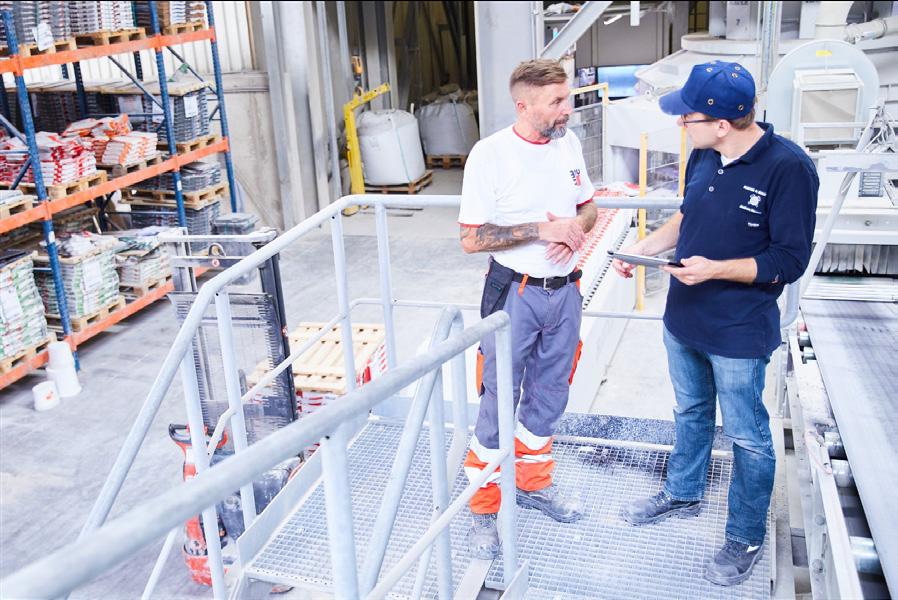
Systems with a centralised digital solution connect multiple machines together to translate data from the machine control and weighing system, making updating the entire packing line easier and resulting in more versatility.
easier than other upgrade options. As businesses continue to grow, some plants will need to expand, whether that means diversifying into other materials or adding new locations.
While many quality assemble-to-order systems enhance key sustainability metrics, operations that want to take things one step further often look to packing plants that are truly engineered to order. For facilities seeking even more tailored solutions, engineer-to-order (ETO) systems offer long-term benefits by allowing companies to customise with all the features that continue to save money and boost profitability for years to come. Consider working with a manufacturer that offers a truly consultative approach to determine the best options for not only the packing machine but the entire plant. All together, these systems make packing powdered material safer, cleaner, and more efficient, allowing for greater operational sustainability. Choosing the right technology is an essential step to maximise the sustainability process when it comes to preventing product loss and saving resources like energy.
In the cement industry, circumstances change quickly, and operations need options to meet demand wherever in the world that might be. Look for a manufacturer that offers prefabricated, modular packing systems designed for quick installation, especially in situations where there is a short timeline between the purchasing decision and market entry. These specialised systems can be disassembled and reassembled in different areas, making it a sustainable option for production facilities.
It has also become increasingly important for operations to look for ways to diversify their product output. One way cement plants can do this is by using cement byproducts to create new materials. For example, instead of burning limestone, plants can use it as a component of fertilizer, which allows for an additional source of revenue in new markets and effectively reduces the amount of CO2 the plant produces. To accomplish this, operators should consider working with a manufacturer that offers a depth of expertise in a wide range of industries and process engineering capabilities.
No matter what the future of packing brings, when experienced cement producers and equipment manufacturers partner, it results in more sustainable, efficient plants. The future of sustainability does not just rely solely on reducing power usage, dust suppression, or even minimising product loss. Instead, the truly sustainable operations will be those that account for the big picture view of all factors – from environmental to social and economic.

R. Todd Swinderman and Daniel Marshall, Martin Engineering, explore best practices for managing safe and efficient plant shutdowns.
Demand to achieve production targets and the need to control costs place cement plant operators under pressure to extend periods between scheduled shutdowns. The amount of time allotted for planned outages can also be squeezed, exacerbating numerous (sometimes conflicting) projects scheduled at once. As every plant manager knows, shutdowns are extremely busy times, with in-house and contractor personnel working side-by-side to tight timescales to complete an array of projects before the scheduled restart date.1
Even with the best planning, pushing to stay under budget and ahead of time can mean putting sub-optimal equipment




back into service, resulting in early failure. The rush to get back into production can also translate into exposure to workplace hazards, arising from corner-cutting to meet deadlines. Yet it is essential for material flow systems and conveyors to be brought back online for production to resume. The following are some of the key areas for consideration when planning a shutdown.
Operators are always looking to improve safety, efficiency, and production, and rightly so. With the right planning, shutdowns are the ideal time for major retrofits and reconstructions to accomplish these goals.
However, upgrading a single piece of equipment alone is not likely to lead to increased production capacity; this usually requires a well-engineered solution that considers all related aspects of the operation. For example, increased production might involve redesigning a transfer chute to handle greater material volumes with different trajectories at faster speeds, and a well-sealed environment to control wear and avoid additional spillage and dust. Any solution should also seek to minimise future exposure to hazards and reduce the amount of ongoing maintenance.
The right solution therefore involves an end-to-end examination of material flow in the system, and consideration for appropriate upgrades to the capabilities of every component.
The volume and nature of the work required for a smooth and timely shutdown typically exceeds the number of trained and experienced internal staff needed to complete the tasks, so there is almost always a need for expert services and contractors.
Choosing the correct contracting and servicing partner can be the key to the success of a plant shutdown, and ensuring all those involved are certified appropriately from the start could save time, hassle, and cost later. It is wise to choose trusted providers who are familiar with the site and involve them early in the process to gather bids, discuss details, and obtain their expert input. For retrofits and new installations alike, equipment manufacturers commonly supply a supervisor to oversee a subcontractor or in-house staff. This works well if all parties are experienced with the manufacturer’s equipment and its capabilities.
It is worth considering that terms like ‘servicer’, ‘contractor’, and other names are sometimes used interchangeably, but their roles can be very specific. For example, servicers are typically technicians who perform specialised scheduled tasks such as belt cleaner replacement or other conveyor maintenance. Contractors can be generalists supplying outside labour or highly skilled specialists in major equipment installation and construction, such as crane operators or structural engineers. However, during a shutdown, these may be the same person or company and, as
mentioned, may employ subcontractors. In most cases, an equipment manufacturer's factory-trained technicians will have greater specific expertise than in-house personnel or third-party workers, and they do not need to be trained on the nuances of products and installation techniques while on the job.
The benefits of using the right specialised servicers during a shutdown are:
f Training and expertise. They can quickly get the job done, identify potential issues, and troubleshoot if necessary.
f Faster access to the supplier. They often have maintenance and installation documentation on hand and quick access to support from the supplier.
f Safety and certification. Certifications are required for some specified tasks for safety purposes. Using an uncertified individual can increase the risk of injury and could be a liability issue.
f Equipment considerations. Specialised contractors generally have the proper tools on hand to overcome obstacles.
f Engineering solutions. When unforeseen problems arise mid-project, experienced contractors can devise a safe work-around either onsite or by communicating with the equipment manufacturer’s engineers.
f Logistical considerations. Servicers often work for or have a parts agreement with the equipment manufacturer, providing them quick access to replacement parts.
f Insurance. Speciality contractors typically carry specialised liability and workers compensation insurance, which provides better protection for the customer than general insurance coverage.
The goal should always be a project completed safely within the allotted time and budget. But that is often not the case. An unexpected obstacle that requires a pivot in the plan, a logistical issue with receiving the proper equipment, or a serious workplace injury can derail a timeline, resulting in extended downtime and increased costs.
Planning a shutdown should start directly following the previous shutdown, as it can take months to put in place everything that is required. Additionally, there are sometimes outstanding tasks remaining from a previous shutdown, and checklists always grow leading up to the next one. Scheduled shutdowns have five broad, normally complicated, steps:
f Scope
f Plan
f Schedule
f Execute
f Evaluate
Often, tasks in a shutdown plan that seem independent of each other can be symptoms of a

larger issue. For example, idler fouling, spillage issues, belt damage, etc., might seem like independent problems, but could all stem from the same mistracking belt. Identifying the root cause, addressing it, then testing the solution can help reduce the overall scope of a shutdown.
Once the main areas of concern have been identified, the task list should be prioritised according to the current condition and desired performance post-shutdown. There are five task labels that are useful in defining the work to be done – ‘test, repair, replace, defer, or do nothing’ – and contractors can be invaluable in identifying the label for each task.
Detailed proposals are among the reasons why contractors and servicers are so valuable – they can help to define items on the checklist and then solicit

Make sure there is ample time for contractors to examine the proposed project, provide a bid and prep worksites.

Effective training and communication improves project safety and success.

plans and bids (or issue a request for quote (RFQ)). These bids – delivered as a proposal or statement of work (SOW) – will offer a detailed account for materials, purchased components, contract services, and in-house labour and all associated factors.2
Quotes for parts and materials should consider lead times not only for the delivery, but also for the secondary operations such as preparatory engineering, electrical installation, or component fabrication. When the RFQ is issued, it is key to ensure that all necessary specifications for purchased components are provided. Of the areas requiring hard quotes, contracted labour can be the most difficult for which to obtain accurate estimates.
Any potential suppliers should review the scope, specifications, drawings, and photographs to note any exceptions or revisions that could be required as the job progresses. The project manager will also need to discuss direct labour with various resources within the company to outline both requirements and duration. The most accurate method to accomplish the estimate is to break the work into individual tasks, assess for each task, and then summarise to generate the total.
Once the checklist has been prioritised and categorised, and contractors have provided their bids and requirements, estimate the time for each task and create an overall timeline. This may change during the planning and scheduling phase, but it provides a baseline to work from.
Here is where the budget comes in. Once the scope, specifications, and timeline have been established, operators find that a large portion of planning has already been accomplished. However, integrating schedules with other contractors is vital, and sign-off on the bids always takes time. Be aware that each SOW may have a purchase order (PO) and once that is signed, the plant has committed to the work.
When planning, be aware of issues such as weather, holidays, pending labour contracts, and compliance (permitting) during the shutdown period. All of these can bring a project to a grinding halt and contingencies are advisable.
This is also the phase when key performance indicators (KPIs) should be set for each project to measure the progress and success of the shutdown. It is important to keep KPIs realistic, as they will later provide valuable data in the evaluation phase. Choosing to install modern automated equipment and monitoring technology connected to logistical software and mobile apps can provide useful data and help with ongoing equipment condition and system efficiency monitoring and reporting.
When designs are finalised for components and subassemblies, the handoff between planning/design and manufacturing/delivery must take place. The schedule, scope, and specifications should be
reviewed by the project manager with all of those involved in the supply of the project components and subassemblies.
As materials and parts are delivered, they need to be inspected and inventoried. To avoid project delays, vendors need to be informed immediately of any shortages or nonconforming items and the intended resolution determined. ‘Material shrinkage’ – through damage or pilferage – is a concern in many parts of the world and can affect both project cost and schedule.
The scheduling process is a good time to ensure all the required safety protocols and equipment are clearly understood by everyone involved in the shutdown. It is absolutely essential to ensure that proper certifications are up to date, and that any specialised equipment is available, energy isolation and other safety procedures are explicit, inducted, and followed religiously, and all contractors are certified appropriately.
Realistic timelines for all shutdown projects are vital to prevent the temptation for work to be rushed and safe working compromised. Equally, several different projects overlapping in the same area of a plant can also create major safety issues and must be avoided. It is sometimes easy for those who work at the plant every day to overlook safety issues when planning shutdowns, because they are familiar with the hazards associated with ‘normal’ operations. But most projects undertaken during a plant shutdown are considered ‘non-routine’ tasks with equally non-routine safety hazards.
The project manager (PM) is the person responsible for controlling all work within the project scope. The PM coordinates with maintenance, operations, contractors, and others to ensure shutdown work is on track and being conducted safely. They oversee resource allocation, managing budgets, and controlling costs, whilst monitoring progress against timelines, addressing risks, and resolving bottlenecks. The PM also ensures effective communication across teams, conducts regular progress reviews, and maintains documentation. Quality assurance, adherence to technical standards, and a smooth restart of operations post-shutdown are critical deliverables under their leadership to achieve efficiency and reliability.
The PM must also watch for, and carefully control, any changes in scope, commonly called 'scope creep'. Changes for any reason must be documented by a change order that will normally also require a contract revision or addendum to ensure validity. Scope creep can quickly erode both the project budget and schedule and is one of the primary reasons for extending downtime.
As individual projects near completion, and before testing installed equipment, the PM ensures that the

ARE YOU PAYING SKILLED STAFF TO CLIMB STAIRS OR TO PRODUCE CEMENT?
Cement plants all over the world rely on Alimak rack and pinion elevators to provide reliable, efficient vertical access for maintenance and inspection. Designed to operate in demanding industrial environments, outdoors and indoors, Alimak elevator s require no expensi ve shafts or machine rooms, and they can easily be installed on new and existing structures Standard capacities range from 30 0 k g to 7,0 0 0 kg, with up to 24-ton capacity available upon request
Contact us at info@alimak com for further information
start-up checklist is reviewed, and all components and systems are thoroughly inspected and adjusted. This includes visually inspecting all moving equipment to confirm that all components are performing as anticipated. After initial testing and adjustment of each newly maintained and installed equipment, the overall plant operation can be checked by loading and observing the plant, before making final adjustments as needed.
This phase of the project will utilise the pre-defined KPIs to measure the success of the solution. Evaluation regarding the performance of the system should be ongoing to ensure that it meets or exceeds expectations measured against the initial requirements in the scope and specifications phase of the project.
An important part of the evaluation phase is also measuring the return on investment (ROI) for each project. This will often inform budgets moving forward and could serve to raise budgets in future shutdowns to deliver greater improvements.
Contractor proposals often include estimated ROI, but calculating it after the fact using KPIs is also important. The goal is to get the payback period as close to (or under) 1 year as possible (Table 1). Keep in mind that less expensive equipment which might indicate a quicker ROI is often more costly over the long term. Categorise all possible causes of increased costs (maintenance labour, downtime, production loss, extra equipment costs, etc.) and then determine the costs associated with each category. The true measure of the expense is the lifecycle cost, not simply the purchase price.
For example, calculating ROI to upgrade conveyor belt cleaners begins with identifying the challenges associated with them, such as spillage from carryback. Some of the common costs associated with spillage are cleanup time/labour, low air quality,
health and safety, replacement parts (fouled rollers and machinery), and unscheduled downtime. There are resources available that help build a strong case for projects and upgrades that include both direct and indirect costs such as safety.3
Installing only a portion of a project to meet the budget or using lower quality equipment to save costs does not necessarily translate to faster ROI. Often, half a solution does not equal half the savings. Staying with the belt cleaning example above, lower quality equipment might only clean 80% of material from the belt and deliver a shorter service life before unscheduled downtime starts all over again due to dust and spillage. Higher quality equipment with proven performance may carry a higher purchase price with a slightly extended ROI, but the cost is generally justified over the long term. It is recommended to review equipment specs, examine the materials of construction, and evaluate case studies from similar applications prior to purchase.
Communication is key
Generally, planning for a shutdown is not the task of a single individual, but a coordinated effort between assigned project managers, supervisors, operations managers, contractors, and partners (equipment manufacturers, contractors, etc.). The key component is good communication throughout.
Relying on the expertise of internal staff in partnership with contractors who have experienced similar shutdowns is an excellent step toward success. By following the steps described, project managers will have a good starting point from which to deliver a successful shutdown. Skipping any steps may result in more unanticipated complications that could extend downtime and reduce overall efficiency. Allowing the time for projects to be completed in a safe, systematic, and compliant manner results in fewer incidents and better performance of installed equipment over the long term.
1. SWINDERMAN, T. R., STAHURA, R. P., MARSHALL, D., et al, 'Foundations for Conveyor Safety; First Edition', pg 318; Martin Engineering; Worzalla Publishing Company; Stevens Point, Wisconsin 2009 – https://www.martin-eng. com/content/page/552/foundations-conveyor-systemsbook
2. SWINDERMAN, T. R., MARTI, A., & MARSHALL, D., 'Foundations: The Practical Resource for Cleaner, Safer, More Productive Dust & Material Control, Fourth Edition', pg. 146, pg. 443, pgs 459 – 462, pg. 465. Martin Engineering; Worzalla Publishing Company; Stevens Point, Wisconsin 2009 – https://www.martin-eng.com/content/page/552/ foundations-conveyor-systems-book
3. HAMEL, K., 'Consider Non-Routine Safety Risks before Plant Shutdown Maintenance', EHS Today. Dec. 13, 2017. Endeavor Business Media, Independence, OH – https:// www.ehstoday.com/safety/article/21919415/considernonroutine-safety-risks-before-plant-shutdown-maintenance






• Event previews and reviews
• In-depth technical articles
• In-depth regional analysis by key players in the industry
• Comprehensive technical reviews on all aspects of cement production, from the quarry face to despatch


AERZEN
www.aerzen.com
Alimak AB www.alimak.com
InterCem www.intercem.de
KHD Humboldt Wedag www.khd.com
Krosaki Group krosaki.eu

ATD Abbausysteme GmbH www.atd-cardox.com / www.atd-pgs.com
AUCBM AICCE28 www.aucbm.net
BEUMER GROUP www.beumer.com
Bricking Solutions www.brickingsolutions.com
Claudius Peters www.claudiuspeters.com
DCL
www.dclinc.com
Dracyon Corp. dracyoncorp.com
Endress + Hauser www.endress.com
EnviroTech 2026 www.worldcement.com/envirotech
Euromecc s.r.l www.euromecc.com
Fuller Technologies fuller-technologies.com
Gambarotta Gschwendt www.gambarotta.it
Gorco S.A gorco.es
HASLE www.hasle-refractories.com
HEKO
www.heko.com
Henan SRON
www.sronsilo.com
Loesche www.loesche.com
MAAG Gear www.maaggear.com
Martin Engineering www.martin-eng.com
PENTA Engineering Corporation www.penta.net
PSCL www.pscl.com
Refratechnik www.refra.com
Regal Rexnord www.regalrexnord.com
Silobau Thorwesten www.thorwesten.com
Sinoma Energy Conservation www.sinoma-ec.cn
Sintek www.sintek.com.tr
SOLIDS Dortmund www.solids-recycling-technik.de
TÜRKÇİMENTO turkcimento.org.tr
Unitherm Cemcon unitherm.at
Van Aalst Bulk Handling www.vanaalstbulkhandling.com
World Cement www.worldcement.com





The 28th Arab International Cement & Building Materials Conference & Exhibition (AICCE28)
11th-13th November 2025
Conrad Hotel Dubai/ United Arab Emarites
Event Secretariat: aicce28@aucbm.net aucbm1977@gmail.com www.aucbm.net
Arab Union for Cement and Building Materials (AUCBM)

your CO 2 emissions with
calcined clay and grinding
C/CLAY is part of LOESCHE’s
